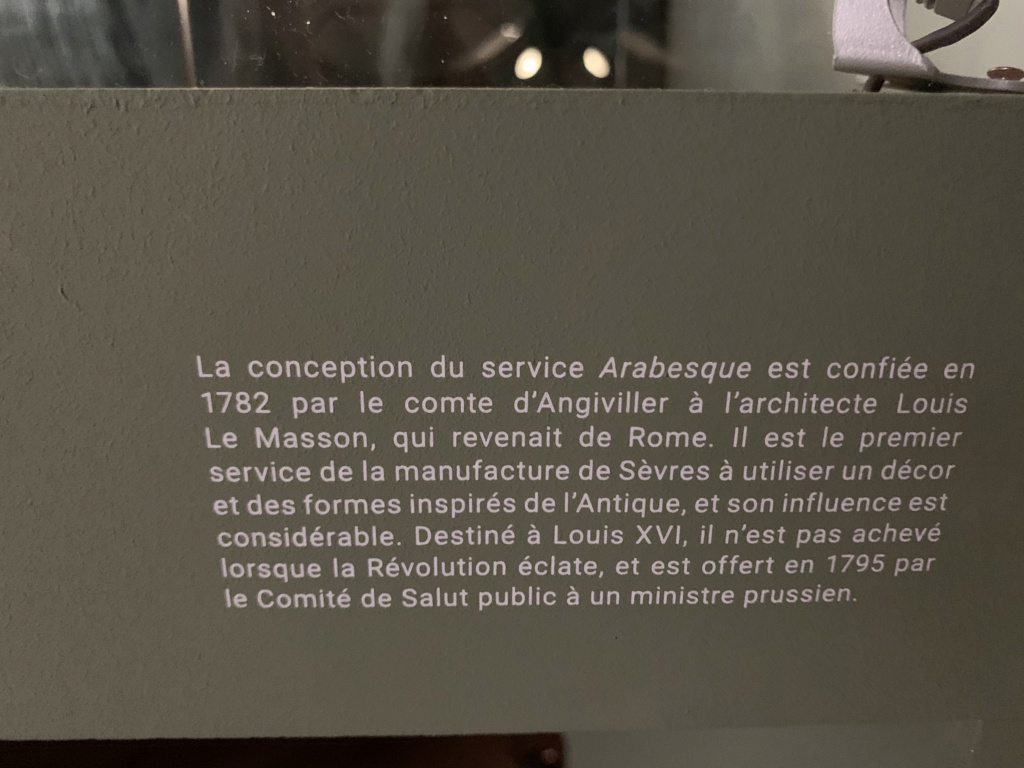Les porcelaines de Sèvres du roi Louis XVI (services et divers)
5 participants
LE FORUM DE MARIE-ANTOINETTE :: La France et le Monde au XVIIIe siècle :: Les Arts et l'artisanat au XVIIIe siècle :: Les arts décoratifs
Page 1 sur 1
 Les porcelaines de Sèvres du roi Louis XVI (services et divers)
Les porcelaines de Sèvres du roi Louis XVI (services et divers)
Il m'inspire généralement beaucoup moins, mais puisque nous avions ouvert de nombreux sujets dédiés aux Services en porcelaine de Sèvres de Marie-Antoinette, ce brave Loulou mérite bien aussi un petit sujet. :roll: :
 L'occasion se présente grâce à la communication de lots qui seront prochainement présentés lors d'une vente aux enchères, organisée par Christie's Paris, le 13 avril 2017.
L'occasion se présente grâce à la communication de lots qui seront prochainement présentés lors d'une vente aux enchères, organisée par Christie's Paris, le 13 avril 2017.
Et ainsi je cite (extraits) :
Assiette en porcelaine de Sèvres du XVIIIe siècle.
Marque en bleu aux deux L entrelacés, lettre date II pour 1788
Marque de peintre pour Cardin, marques en creux.
De forme contournée, à décor polychrome au centre d'une rose dans un médaillon formé d'un filet carmin et de barbeaux, la chute avec un filet bleu et petites guirlandes de myrte, le bord avec un filet carmin et des barbeaux, dents de loup or sur le bord, petites usures à l'or
D.: 24 cm. (9 ¼ in.)
Provenance : Du service du "Gobelet du Roi" de Louis XVI.

Photo : Christie's 2017
Deux assiettes en porcelaine de Sèvres du XVIIIe siècle
Marques en bleu aux deux L entrelacés, lettre date MM pour 1789 et NN pour 1790
Marques du peintre pour Mme Bunel et Anne-Marie Gérard, marques en creux.
De forme contournée, à décor polychrome au centre d'une rose dans un médaillon formé d'un filet carmin et de barbeaux, la chute avec un filet bleu et des petites guirlandes de myrte, le bord avec un filet carmin et des barbeaux, dents de loup or sur le bord, petites usures à l'or
D.: 24 cm. (9 ¼ in.)
Provenance : Du service du "Gobelet du Roi" de Louis XVI.
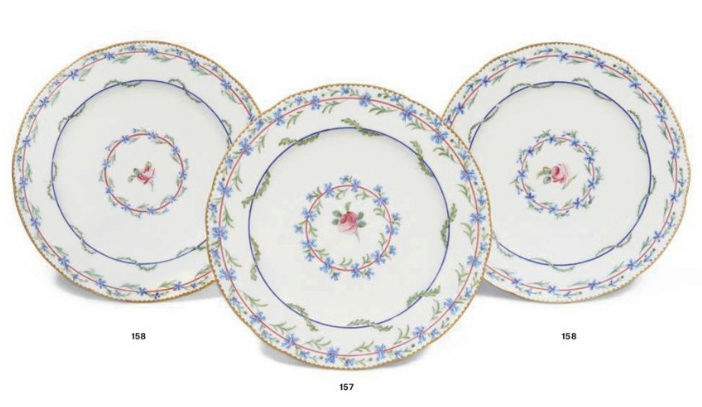
Photo : Christie's 2017
Note de l'expert :
Les trois assiettes proviennent du service dit du "Gobelet du Roi" ou "guirlandes de barbeaux".
Le "Gobelet du Roi", institution chargée du pain, des fruits et des boissons pour la table du roi, commande pour le roi Louis XVI en 1782 un service qui porte communément son nom et dont les livraisons s'échelonnèrent jusqu'en 1790.
Il servait essentiellement à présenter des boissons fraîches, des glaces, des sorbets ou des alcools.

Pour un commentaire détaillé sur les diverses livraisons de ce service voir par David Peters, Sèvres plates and services of the 18th century, Little Berkhamsted, 2005, T.III, pp.663-665 et T.IV, pp.847-850, pp.877-878 et pp.911-912.
Pour des pièces provenant de ce même service, voir le catalogue d'exposition, De Versailles à Paris, Mairie du Vème arrondissement, Paris, 1989, p.263, no 129, illustration face à la page 145; et le catalogue d’exposition, Versailles et les tables royales en Europe, Paris, 1993, p.291, no.97-105, ill. p.142.
Pour une assiette voir la vente chez Christie's Paris, Collection Charles-Otto Zieseniss, 5-6 décembre 2001, lot 167.
 Source et infos complémentaires : http://www.christies.com/SaleLanding/index.aspx?intSaleID=26758&lid=1
Source et infos complémentaires : http://www.christies.com/SaleLanding/index.aspx?intSaleID=26758&lid=1
A suivre, les autres services en porcelaine du roi Louis XVI....

Et ainsi je cite (extraits) :
Assiette en porcelaine de Sèvres du XVIIIe siècle.
Marque en bleu aux deux L entrelacés, lettre date II pour 1788
Marque de peintre pour Cardin, marques en creux.
De forme contournée, à décor polychrome au centre d'une rose dans un médaillon formé d'un filet carmin et de barbeaux, la chute avec un filet bleu et petites guirlandes de myrte, le bord avec un filet carmin et des barbeaux, dents de loup or sur le bord, petites usures à l'or
D.: 24 cm. (9 ¼ in.)
Provenance : Du service du "Gobelet du Roi" de Louis XVI.

Photo : Christie's 2017
Deux assiettes en porcelaine de Sèvres du XVIIIe siècle
Marques en bleu aux deux L entrelacés, lettre date MM pour 1789 et NN pour 1790
Marques du peintre pour Mme Bunel et Anne-Marie Gérard, marques en creux.
De forme contournée, à décor polychrome au centre d'une rose dans un médaillon formé d'un filet carmin et de barbeaux, la chute avec un filet bleu et des petites guirlandes de myrte, le bord avec un filet carmin et des barbeaux, dents de loup or sur le bord, petites usures à l'or
D.: 24 cm. (9 ¼ in.)
Provenance : Du service du "Gobelet du Roi" de Louis XVI.

Photo : Christie's 2017
Note de l'expert :
Les trois assiettes proviennent du service dit du "Gobelet du Roi" ou "guirlandes de barbeaux".
Le "Gobelet du Roi", institution chargée du pain, des fruits et des boissons pour la table du roi, commande pour le roi Louis XVI en 1782 un service qui porte communément son nom et dont les livraisons s'échelonnèrent jusqu'en 1790.
Il servait essentiellement à présenter des boissons fraîches, des glaces, des sorbets ou des alcools.

Pour un commentaire détaillé sur les diverses livraisons de ce service voir par David Peters, Sèvres plates and services of the 18th century, Little Berkhamsted, 2005, T.III, pp.663-665 et T.IV, pp.847-850, pp.877-878 et pp.911-912.
Pour des pièces provenant de ce même service, voir le catalogue d'exposition, De Versailles à Paris, Mairie du Vème arrondissement, Paris, 1989, p.263, no 129, illustration face à la page 145; et le catalogue d’exposition, Versailles et les tables royales en Europe, Paris, 1993, p.291, no.97-105, ill. p.142.
Pour une assiette voir la vente chez Christie's Paris, Collection Charles-Otto Zieseniss, 5-6 décembre 2001, lot 167.
______________
A suivre, les autres services en porcelaine du roi Louis XVI....

Dernière édition par La nuit, la neige le Dim 04 Aoû 2024, 18:51, édité 2 fois
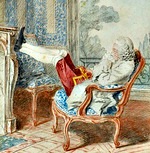
La nuit, la neige- Messages : 18132
Date d'inscription : 21/12/2013
 Re: Les porcelaines de Sèvres du roi Louis XVI (services et divers)
Re: Les porcelaines de Sèvres du roi Louis XVI (services et divers)
Messages copiés / collés depuis notre rubrique "Vente aux enchères"... 
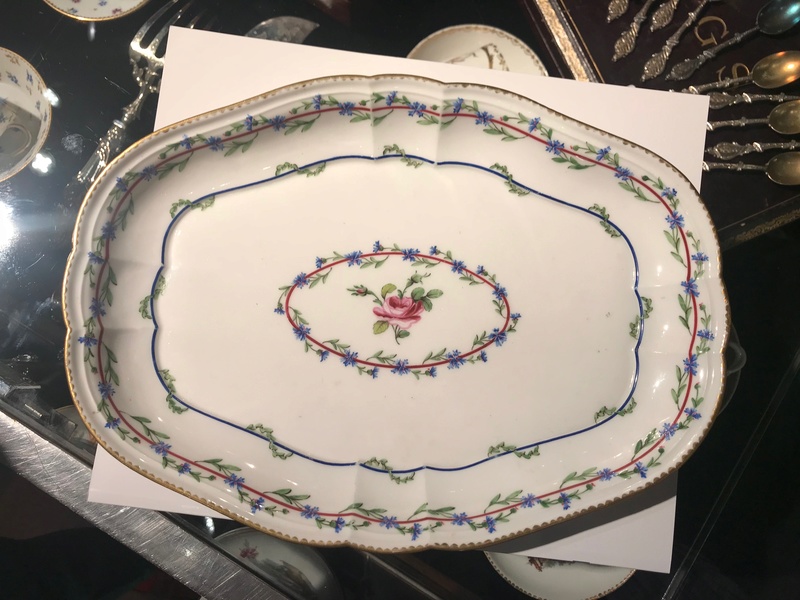

basse a écrit:Il me semble que le forum a oublié de parler de cette vente de 2 plats à raves, en porcelaine de Sèvres, provenant du "service du Gobelet du Roi" commandé par Louis XVI à la Manufacture de Sèvres à partir de 1872, et livré à Versailles (Tessier-Sarrou à Drouot, 20 avril 2018) ....
Duc d'Ostrogothie a écrit:
Je les avais remarqué en effet. Les plats à raves sont rares. Photos :


Mme de Sabran a écrit:Je ne vois pas trop trop ce que sont les raves ? Je connais le mot pourtant ...
Gouverneur Morris a écrit:Je me suis posé la question, c’est une sorte de radis apparemment. Mais vu qu’on parle également de chou ou céleri rave, cela n’est pas très clair...

La nuit, la neige- Messages : 18132
Date d'inscription : 21/12/2013
 Re: Les porcelaines de Sèvres du roi Louis XVI (services et divers)
Re: Les porcelaines de Sèvres du roi Louis XVI (services et divers)
Merci. Pour répondre à Eléonore, le plat à raves est pour les radis.
Juste une petite précision en ce qui concerne ce service : il n'était pas destiné à la table du roi.
C'était le service des officiers du roi, en charge du couvert, du fruit et des boissons de la table du roi (les officiers du gobelet).
Juste une petite précision en ce qui concerne ce service : il n'était pas destiné à la table du roi.
C'était le service des officiers du roi, en charge du couvert, du fruit et des boissons de la table du roi (les officiers du gobelet).

Duc d'Ostrogothie- Messages : 3227
Date d'inscription : 04/11/2017
 Re: Les porcelaines de Sèvres du roi Louis XVI (services et divers)
Re: Les porcelaines de Sèvres du roi Louis XVI (services et divers)
... radis, navets, carottes, céleris and Co , les légumes raves sont des racines, légumes de la plèbe au Moyen-Age mais dont la noblesse a rapidement su combien ils sont délicieux, délicieusement cuisinés.

_________________
... demain est un autre jour .

Mme de Sabran- Messages : 55497
Date d'inscription : 21/12/2013
Localisation : l'Ouest sauvage
 Re: Les porcelaines de Sèvres du roi Louis XVI (services et divers)
Re: Les porcelaines de Sèvres du roi Louis XVI (services et divers)
En fait c'étaient des plats pour présenter des légumes cuits au bouillon , comme ceux du pot-au-feu .
Comme le précise Madame de Sabran cela pouvait être des céleris , navets , chous , carottes , panais , ou un mélange de tout ça
Comme le précise Madame de Sabran cela pouvait être des céleris , navets , chous , carottes , panais , ou un mélange de tout ça

hastur- Messages : 541
Date d'inscription : 22/12/2013
 Sèvres et le goût de Louis XVI pour le style néoclassique à décors " d'arabesques "
Sèvres et le goût de Louis XVI pour le style néoclassique à décors " d'arabesques "
L'un de nos reporters a posté récemment les photos d'une pièce de ce service, dans notre sujet :
 Vivre à l'antique, de Marie-Antoinette à Napoléon Ier (expo au château de Rambouillet)
Vivre à l'antique, de Marie-Antoinette à Napoléon Ier (expo au château de Rambouillet)


 Mais que sait-on de ce service ?
Mais que sait-on de ce service ?
Ce superbe plat (daté 1784 et non pas 1789 ) avait été présenté aux enchères en 2012, avec le descriptif suivant.
) avait été présenté aux enchères en 2012, avec le descriptif suivant.
PLATEAU DE SAUCIERE EN PORCELAINE DE SEVRES DE LA FIN DU XVIIIEME SIECLE
PROVENANT DU "SERVICE ARABESQUE" DIT "SERVICE MASSON"
MARQUE EN BLEU AUX DEUX L ENTRELACES, LETTRES-DATE POUR 1784, MARQUES DE PEINTRE POUR DODIN ET BARRAT, MARQUE DE DOREUR POUR VINCENT
De forme navette, à décor polychrome et or, le centre en grisaille d'une figure féminine à l'antique tenant un panier fleuri et d'un lion, se détachant sur un fond vert, dans un cartouche de forme navette avec une frise de grecques or sur fond bleu, encadré de motifs d'ailes de chauve-souris peints de vases antiques et d'un décor d'arabesques, l'aile décorée d'une large frise de réserves géométriques bleues et blanches intercalées et ponctuées de têtes de fleurs et masques dans des cartouches surlignés de filets mauves, filet or sur le bord, éclats
Longueur: 34 cm. (13 3/8 in.)
Provenance : du service arabesque, livré en 1795 à Karl-August Freihers von Hardenberg, ministre d'Etat.
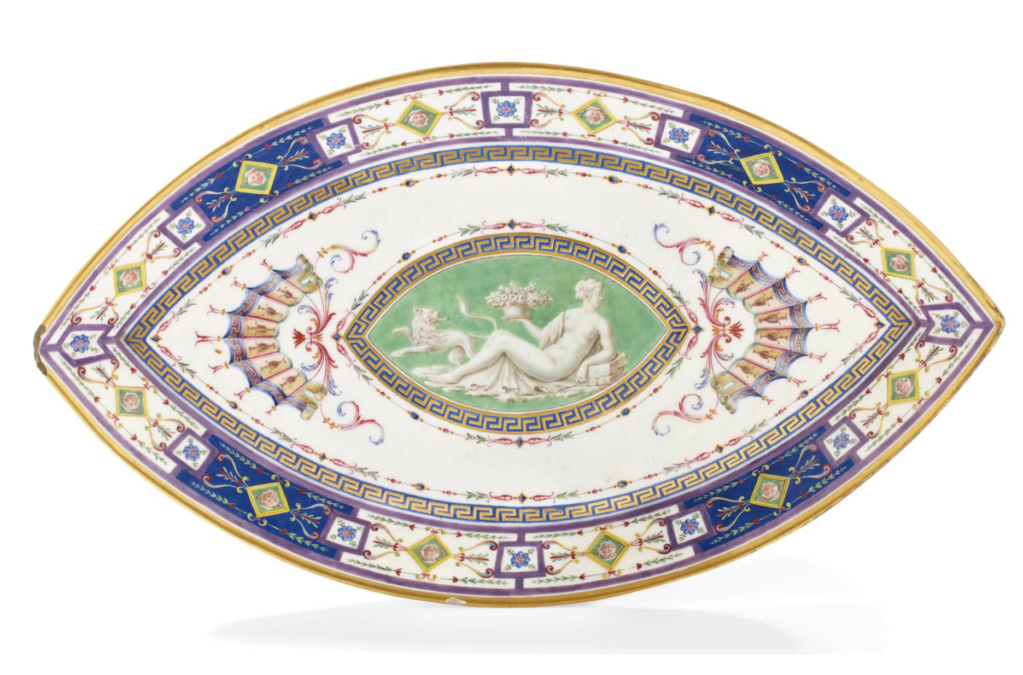
Présentation au catalogue :
L'historique
La genèse et l'histoire du "service arabesque", aussi appelé "service Masson", a été longuement étudiée par David Peters dans sa publication Sèvres plates and services of the 18th century, Little Berkhamsted, 2005, Vol. V, 95-6, pages 1085 à 1095.
Originellement commandé pour le roi Louis XVI, il ne lui est jamais livré et n'est pas non plus achevé (sa production s'arrête vers 1787) du fait des évènements révolutionnaires.
Il est finalement livré sur ordre du Comité de Salut Public à Karl-August Freihers von Hardenberg, ministre d'Etat auprès de Friedrich Wilhem de Prusse en 1795, en remerciement de son aide lors de la signature du Traité de Bâle le 5 avril 1795 ; le roi de Prusse décide alors de se retirer de la coalition anti-révolutionnaire menée par Léopold II, archiduc d'Autriche, pour signer ce traité de paix avec la France.

La conception
Outre l'aspect historique, ce service, dont le lieu de destination originel n'est pas connu, est exceptionnel à plusieurs titres.
C'est l'un des très rares services de style néoclassique réalisés au XVIIIe siècle (avec celui livré à l'Impératrice Catherine II de Russie), et pour lequel non seulement de nouvelles formes, mais aussi des décors (différents pour chaque pièce) et également deux types de porcelaine (tendre et dure) sont utilisés.
Un architecte, du nom de Louis le Masson, était à cette époque employé par la manufacture pour créer de nouvelles formes et décors.
Pour les formes, il s'inspire de pièces antiques ; la forme de la saucière qui correspond à la forme du plateau que nous présentons s'inspire d'une lampe à huile romaine. Pour les décors, il s'inspire des loges de Raphaël au Vatican.
Deux artistes peintres l'ont secondé : tout d'abord Etienne-Henry le Guay puis le fils de ce dernier, Etienne-Charles. Les projets sont partiellement toujours conservés dans les archives de Sèvres-Cité de la Céramique et publiés par Hessling et Lechevallier-Chevignard dans Documents anciens de la Manufacture Nationale de Sèvres: Choix de compositions et de projets de décoration des époques de Louis XVI et du Directoire, Paris, vers 1915, pl. 18.
Eléments de comparaison
Trois exemples de plateau de saucière sont à ce jour répertoriés : le premier vendu chez Christie's à Londres, le 5 décembre 1994, lot 109 et aujourd'hui dans une collection privée ; le deuxième vendu chez Christie's à Paris, le 24 juin 2003, lot 507 et conservé de nos jours dans les collections du Philadelphia Museum of Art, USA; et ce troisième exemple.
Tous ont en commun une structure de décor similaire même si certains motifs sont différents pour chaque pièce. Les trois s'organisent autour du même motif central : une femme vêtue à l'antique allongée, un lion à ses côtés.
L'exemple offert à la vente aujourd'hui a la particularité d'avoir été peint par Dodin, dont on retrouve la trace du travail dans les travaux extraordinaires des peintres pour l'année 1786 : " Reçu Dodin Novembre 1786 une peinture sur un plateau arabesque 24 (livres) ".
Nous remercions Marie-Laure de Rochebrune pour cette information qui sera incluse dans le catalogue de l'exposition du château de Versailles: "Charles-Nicolas Dodin" (15 mai - 9 septembre 2012).
* Source texte et infos complémentaires : Christie's
A suivre, d'autres rares pièces de ce service ainsi que les dessins préparatoires de Louis le Masson...
Duc d'Ostrogothie a écrit:
Plateau de saucière service arabesque en porcelaine de Sèvres, 1789 (service destiné à Louis XVI resté inachevé offert par le Directoire en 1795 à un ministre prussien) :


Ce superbe plat (daté 1784 et non pas 1789
PLATEAU DE SAUCIERE EN PORCELAINE DE SEVRES DE LA FIN DU XVIIIEME SIECLE
PROVENANT DU "SERVICE ARABESQUE" DIT "SERVICE MASSON"
MARQUE EN BLEU AUX DEUX L ENTRELACES, LETTRES-DATE POUR 1784, MARQUES DE PEINTRE POUR DODIN ET BARRAT, MARQUE DE DOREUR POUR VINCENT
De forme navette, à décor polychrome et or, le centre en grisaille d'une figure féminine à l'antique tenant un panier fleuri et d'un lion, se détachant sur un fond vert, dans un cartouche de forme navette avec une frise de grecques or sur fond bleu, encadré de motifs d'ailes de chauve-souris peints de vases antiques et d'un décor d'arabesques, l'aile décorée d'une large frise de réserves géométriques bleues et blanches intercalées et ponctuées de têtes de fleurs et masques dans des cartouches surlignés de filets mauves, filet or sur le bord, éclats
Longueur: 34 cm. (13 3/8 in.)
Provenance : du service arabesque, livré en 1795 à Karl-August Freihers von Hardenberg, ministre d'Etat.

Présentation au catalogue :
L'historique
La genèse et l'histoire du "service arabesque", aussi appelé "service Masson", a été longuement étudiée par David Peters dans sa publication Sèvres plates and services of the 18th century, Little Berkhamsted, 2005, Vol. V, 95-6, pages 1085 à 1095.
Originellement commandé pour le roi Louis XVI, il ne lui est jamais livré et n'est pas non plus achevé (sa production s'arrête vers 1787) du fait des évènements révolutionnaires.
Il est finalement livré sur ordre du Comité de Salut Public à Karl-August Freihers von Hardenberg, ministre d'Etat auprès de Friedrich Wilhem de Prusse en 1795, en remerciement de son aide lors de la signature du Traité de Bâle le 5 avril 1795 ; le roi de Prusse décide alors de se retirer de la coalition anti-révolutionnaire menée par Léopold II, archiduc d'Autriche, pour signer ce traité de paix avec la France.

La conception
Outre l'aspect historique, ce service, dont le lieu de destination originel n'est pas connu, est exceptionnel à plusieurs titres.
C'est l'un des très rares services de style néoclassique réalisés au XVIIIe siècle (avec celui livré à l'Impératrice Catherine II de Russie), et pour lequel non seulement de nouvelles formes, mais aussi des décors (différents pour chaque pièce) et également deux types de porcelaine (tendre et dure) sont utilisés.
Un architecte, du nom de Louis le Masson, était à cette époque employé par la manufacture pour créer de nouvelles formes et décors.
Pour les formes, il s'inspire de pièces antiques ; la forme de la saucière qui correspond à la forme du plateau que nous présentons s'inspire d'une lampe à huile romaine. Pour les décors, il s'inspire des loges de Raphaël au Vatican.
Deux artistes peintres l'ont secondé : tout d'abord Etienne-Henry le Guay puis le fils de ce dernier, Etienne-Charles. Les projets sont partiellement toujours conservés dans les archives de Sèvres-Cité de la Céramique et publiés par Hessling et Lechevallier-Chevignard dans Documents anciens de la Manufacture Nationale de Sèvres: Choix de compositions et de projets de décoration des époques de Louis XVI et du Directoire, Paris, vers 1915, pl. 18.
Eléments de comparaison
Trois exemples de plateau de saucière sont à ce jour répertoriés : le premier vendu chez Christie's à Londres, le 5 décembre 1994, lot 109 et aujourd'hui dans une collection privée ; le deuxième vendu chez Christie's à Paris, le 24 juin 2003, lot 507 et conservé de nos jours dans les collections du Philadelphia Museum of Art, USA; et ce troisième exemple.
Tous ont en commun une structure de décor similaire même si certains motifs sont différents pour chaque pièce. Les trois s'organisent autour du même motif central : une femme vêtue à l'antique allongée, un lion à ses côtés.
L'exemple offert à la vente aujourd'hui a la particularité d'avoir été peint par Dodin, dont on retrouve la trace du travail dans les travaux extraordinaires des peintres pour l'année 1786 : " Reçu Dodin Novembre 1786 une peinture sur un plateau arabesque 24 (livres) ".
Nous remercions Marie-Laure de Rochebrune pour cette information qui sera incluse dans le catalogue de l'exposition du château de Versailles: "Charles-Nicolas Dodin" (15 mai - 9 septembre 2012).
* Source texte et infos complémentaires : Christie's
___________________
A suivre, d'autres rares pièces de ce service ainsi que les dessins préparatoires de Louis le Masson...

Dernière édition par La nuit, la neige le Sam 13 Mai 2023, 17:18, édité 4 fois

La nuit, la neige- Messages : 18132
Date d'inscription : 21/12/2013

Duc d'Ostrogothie- Messages : 3227
Date d'inscription : 04/11/2017
 Re: Les porcelaines de Sèvres du roi Louis XVI (services et divers)
Re: Les porcelaines de Sèvres du roi Louis XVI (services et divers)
Merci !
Je ne comprends pas cette date du cartel, puisque Christie's annonçait les " lettres-date pour 1784 " au dos de la pièce.
Bon...
Je ne comprends pas cette date du cartel, puisque Christie's annonçait les " lettres-date pour 1784 " au dos de la pièce.
Bon...

La nuit, la neige- Messages : 18132
Date d'inscription : 21/12/2013
 Sèvres et le goût de Louis XVI pour le style néoclassique à décors " d'arabesques "
Sèvres et le goût de Louis XVI pour le style néoclassique à décors " d'arabesques "
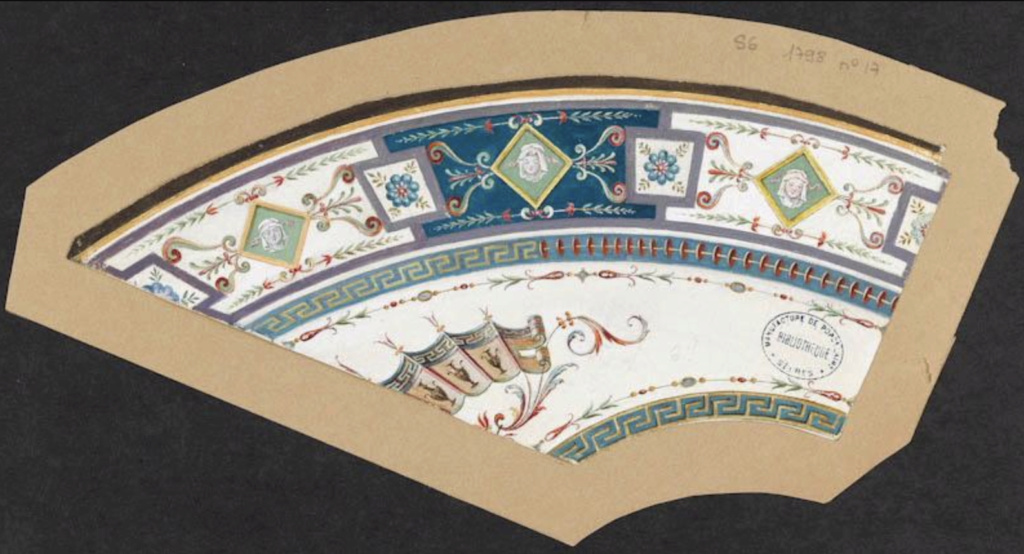
Frise du service Arabesque dit "Masson
Louis le Masson (1743-1829)
18e siècle
Dessin, gouache
Image : Sèvres - Manufacture et musée nationaux, Dist. RMN-Grand Palais / Le Studio Numérique
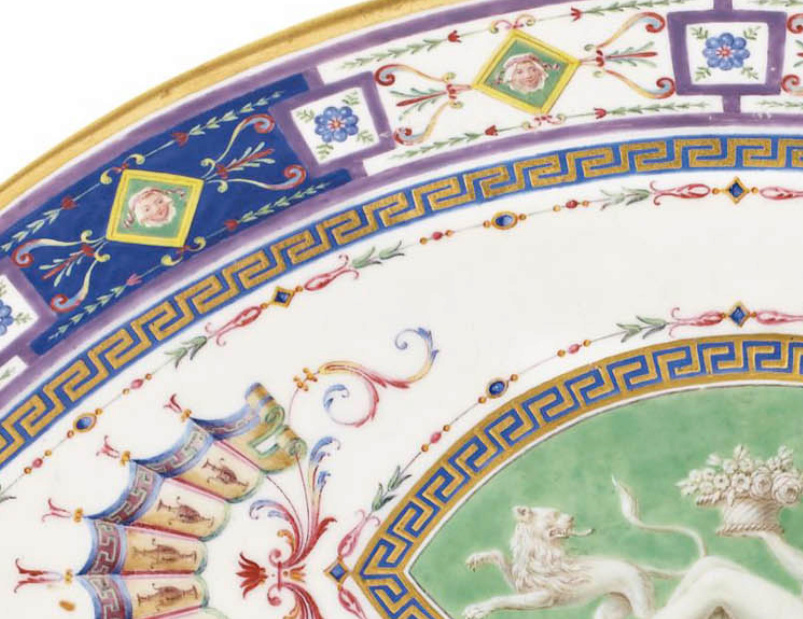
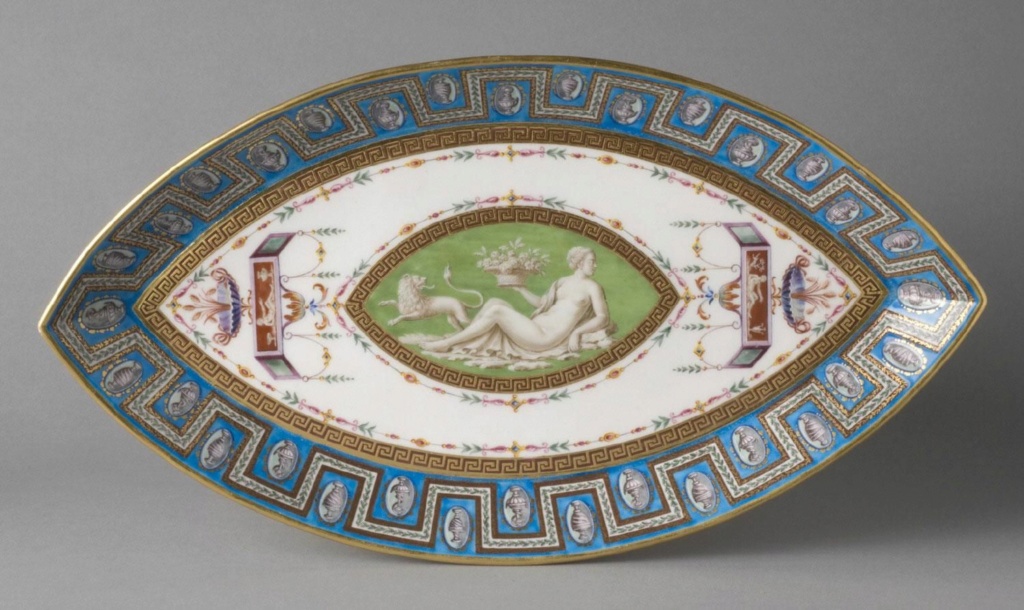
Dish from the "Arabesque" Service
Made by Sèvres porcelain factory, Sèvres, France (1756 - present)
Decoration designed by Louis Le Masson, French (1743 - 1829)
Painted by Pierre-Antoine Méreaud, French (active 1754 - 179)
1786
Soft-paste porcelain with enamel and gilt decoration
Image : Philadelphia Museum of Art
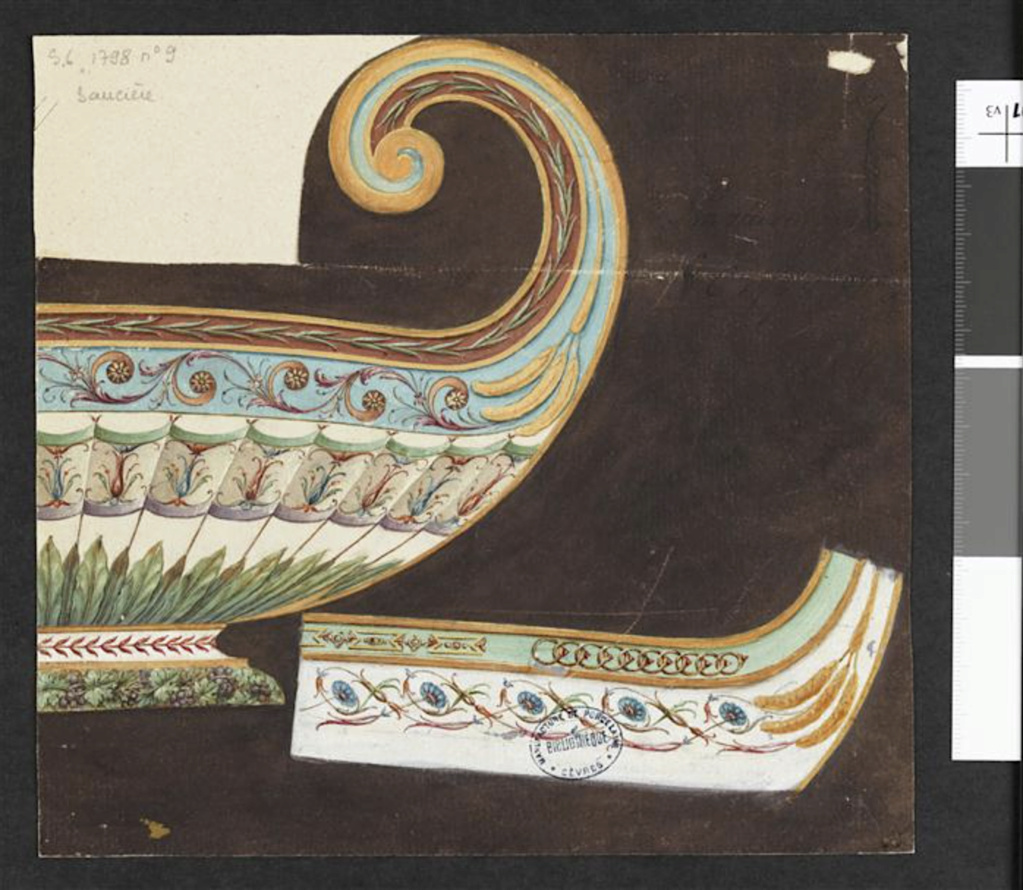
Saucière du service Arabesque dit 'Masson'
Masson Louis Le (1743-1829)
18e siècle
Dessin à la gouache
Image : Sèvres - Manufacture et musée nationaux, Dist. RMN-Grand Palais / Le Studio Numérique
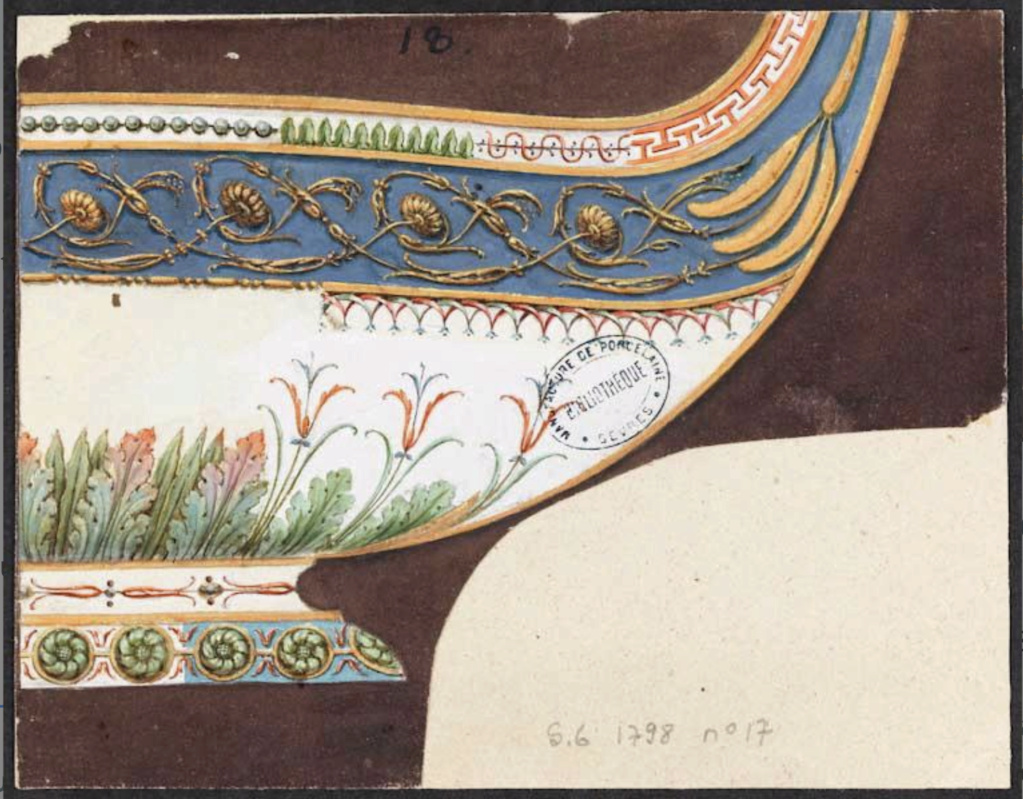
Motif décoratif (frise, ornements) du service Arabesque dit 'Masson'
Masson Louis Le (1743-1829)
18e siècle
Dessin à la gouache
Image : Sèvres - Manufacture et musée nationaux, Dist. RMN-Grand Palais / Le Studio Numérique
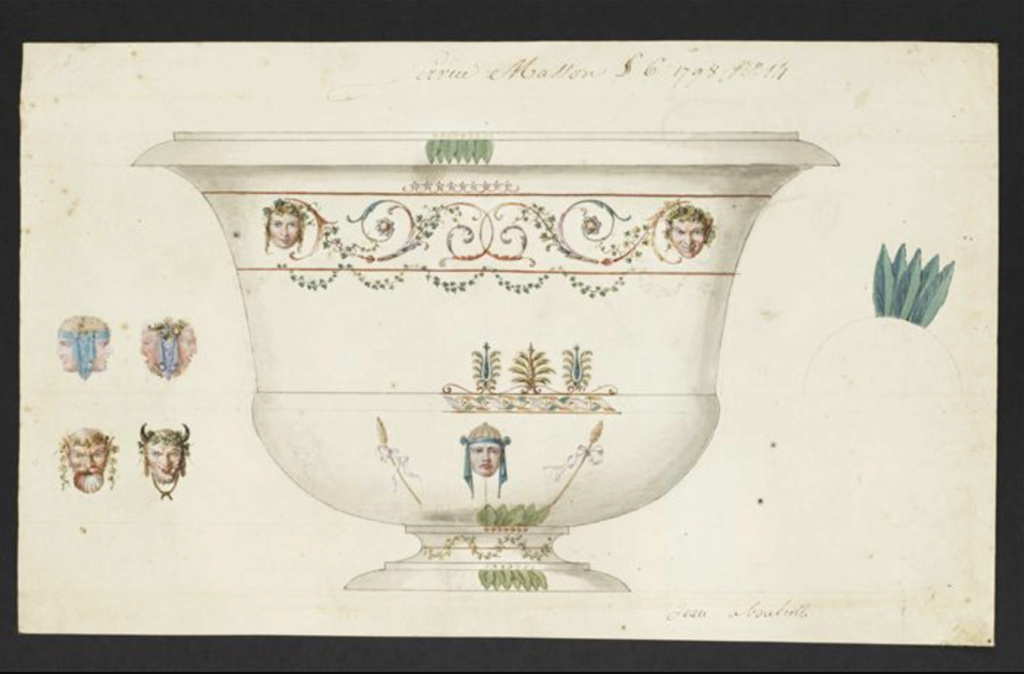
Seau à bouteille du service Arabesque dit 'Masson'
Masson Louis Le (1743-1829)
Dessin à la gouache
18e siècle
Image : Sèvres - Manufacture et musée nationaux, Dist. RMN-Grand Palais / Le Studio Numérique
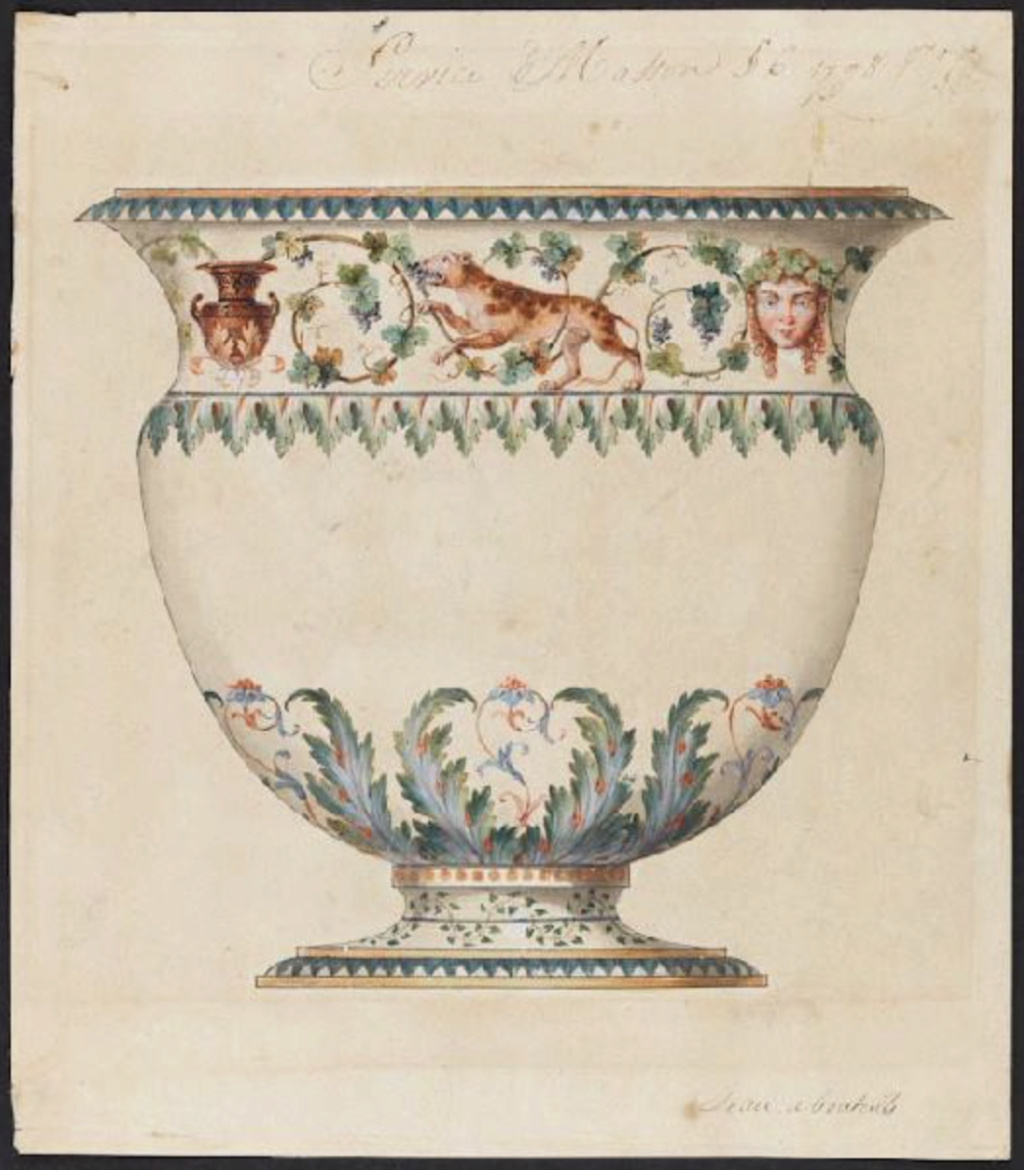
Seau à bouteille du service Arabesque dit 'Masson'
Masson Louis Le (1743-1829)
Dessin à la gouache
18e siècle
Image : Sèvres - Manufacture et musée nationaux, Dist. RMN-Grand Palais / Le Studio Numérique
Inspiré par ce dessin, nous retrouvons aujourd'hui un exemplaire de ces seaux dans les collections du marchand d'art Adrian Sassoon, spécialiste de la porcelaine européenne.
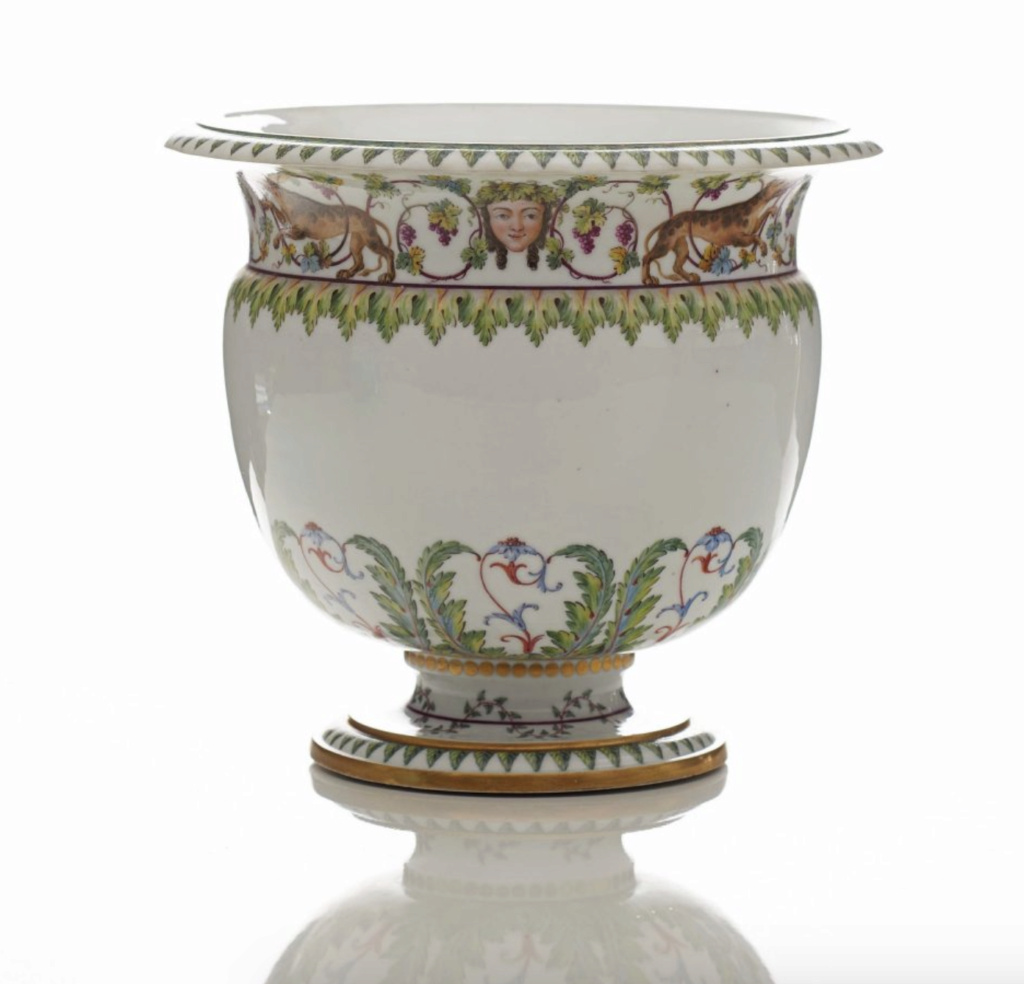
Royal Hard-Paste Sèvres Porcelain Wine Cooler from Louis XVI’s Arabesque Service
Seau à demi-bouteille arabesque
1785
Height 18cm (7 1/8")
Diameter 20cm (7 7/8")
Source et infos complémentaires : Adrian Sassoon
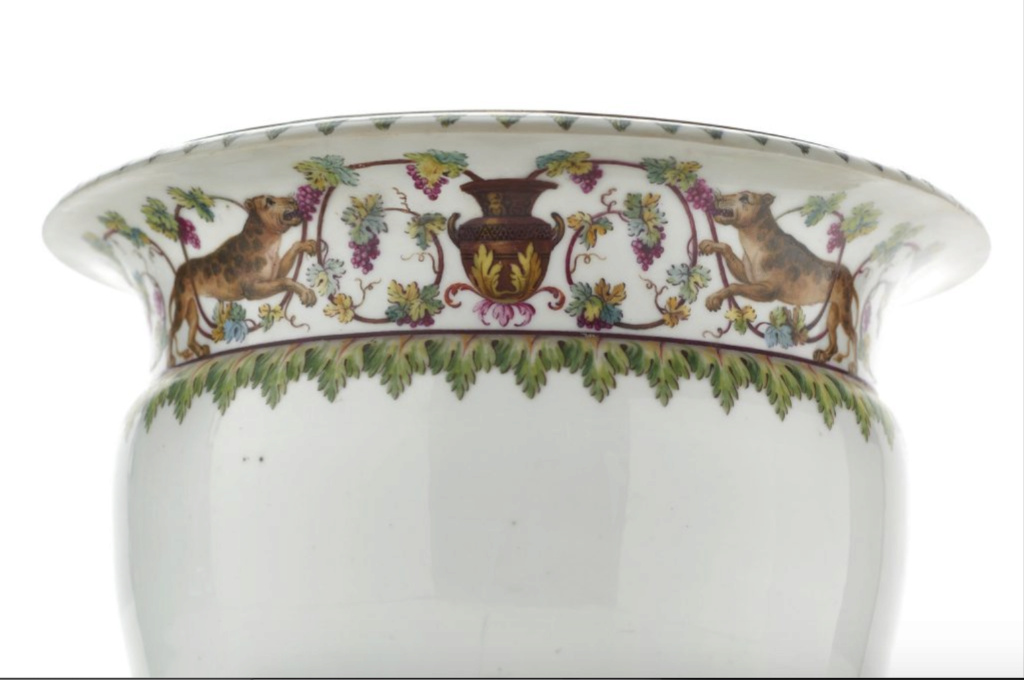
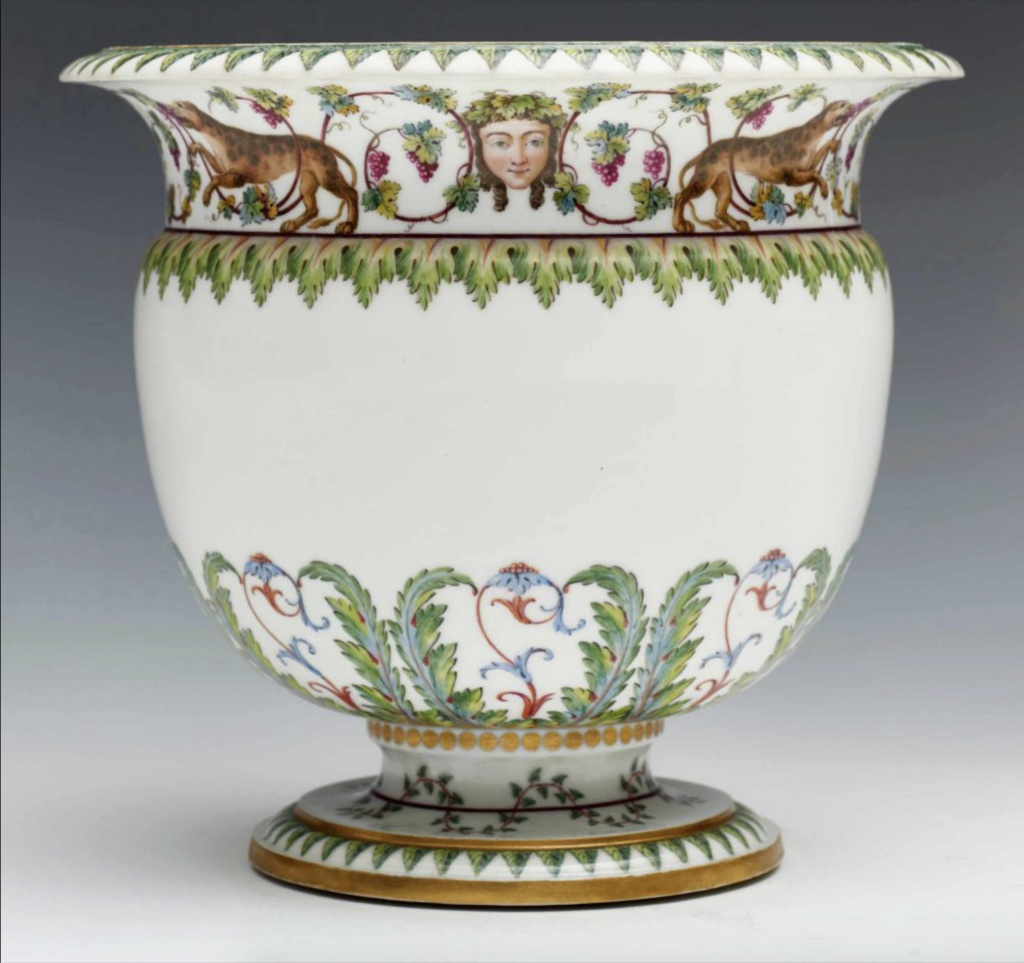
Image : Adrian Sassoon

Images : Adrian Sassoon
Voir et écouter le marchand présenter cette pièce, accompagnée lors de la première vue, l'air de rien, de trois assiettes des services de Marie-Antoinette...


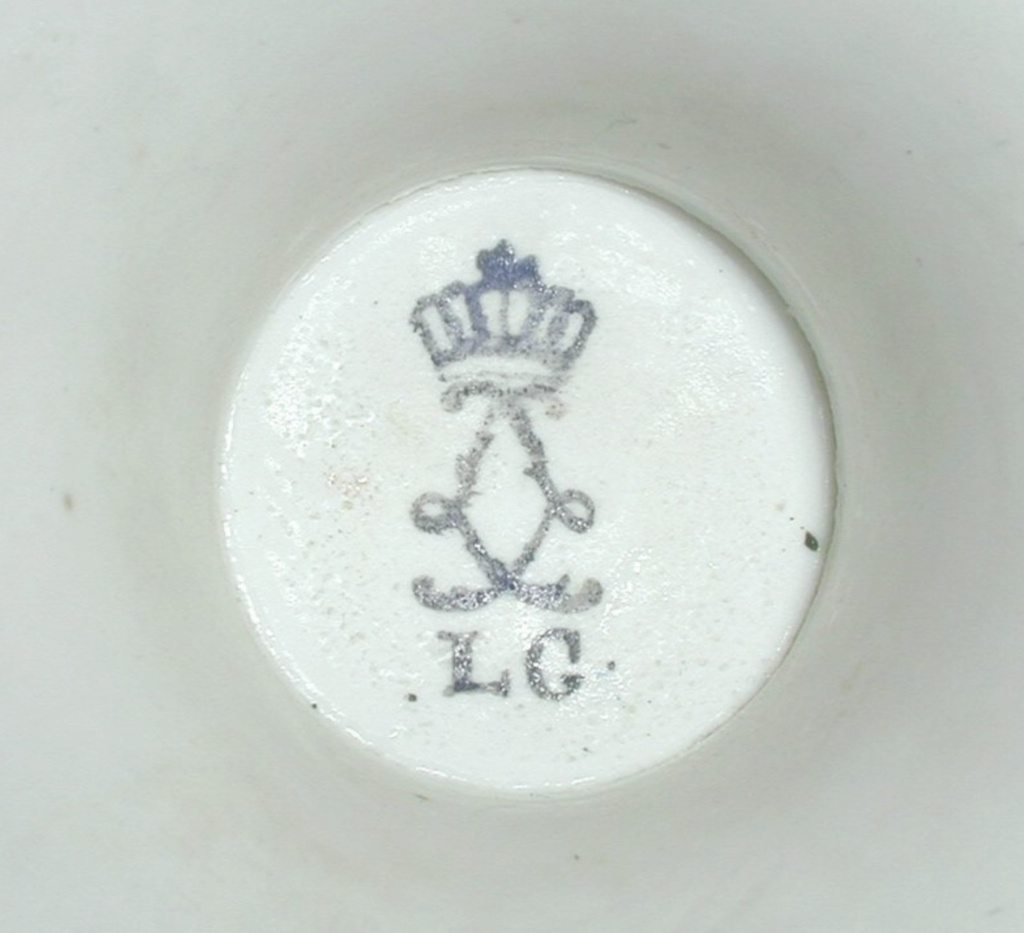
Seau à demi-bouteille du service Arabesque
Manufacture de Sèvres (fabricant) ; Le Gay (peintre)
1784-85
Porcelaine dure, décor peint sur couverte
H 17,8 cm
Images : Les Arts Décoratifs/Jean Tholance

A nouveau le descriptif au catalogue de vente est plus intéressant que celui des musées.
Je cite des extraits :
A SEVRES BOTTLE-COOLER (SEAU A DEMI-BOUTEILLE) FROM THE 'SERVICE ARABESQUE'
1784-85,
BLUE CROWNED INTERLACED LS MARK AND .LG· MARK FOR LE GUAY
(...)
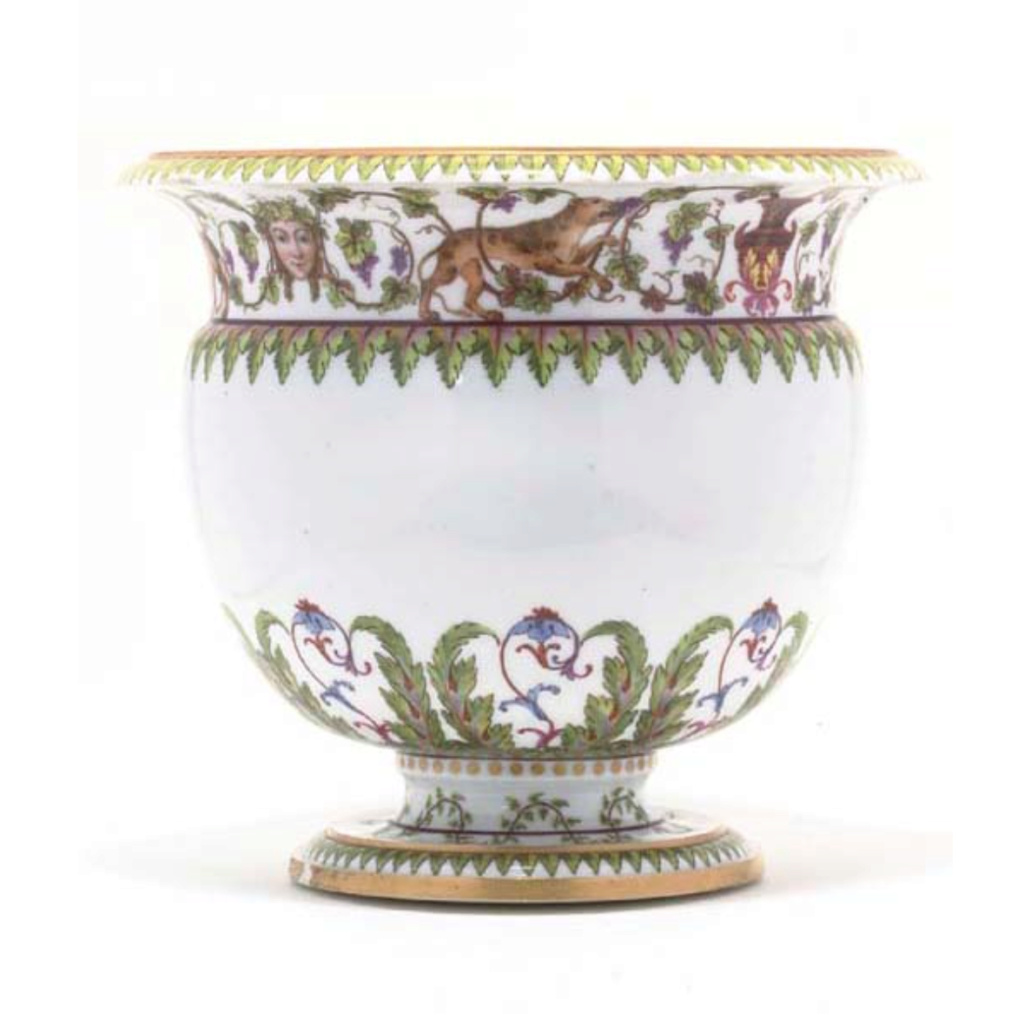
Provenance : Karl August, Freiherr von Hardenberg, Minister of State of the King of Prussia, and thence by descent to the present owner.
LE MASSON'S SEAU FOR THE ARABESQUE SERVICE
The Service Arabesque is extraordinary not only because the decoration of its components differs from piece to piece, but because the forms of the pieces were radically different from anything Sèvres had attempted to produce before. The service was at the cutting-edge of the new neo-classical style, and the factory pushed their experimental techniques to the limit, so much so in fact that the new hard paste posed serious problems for the decorators, and some pieces were not considered a success.
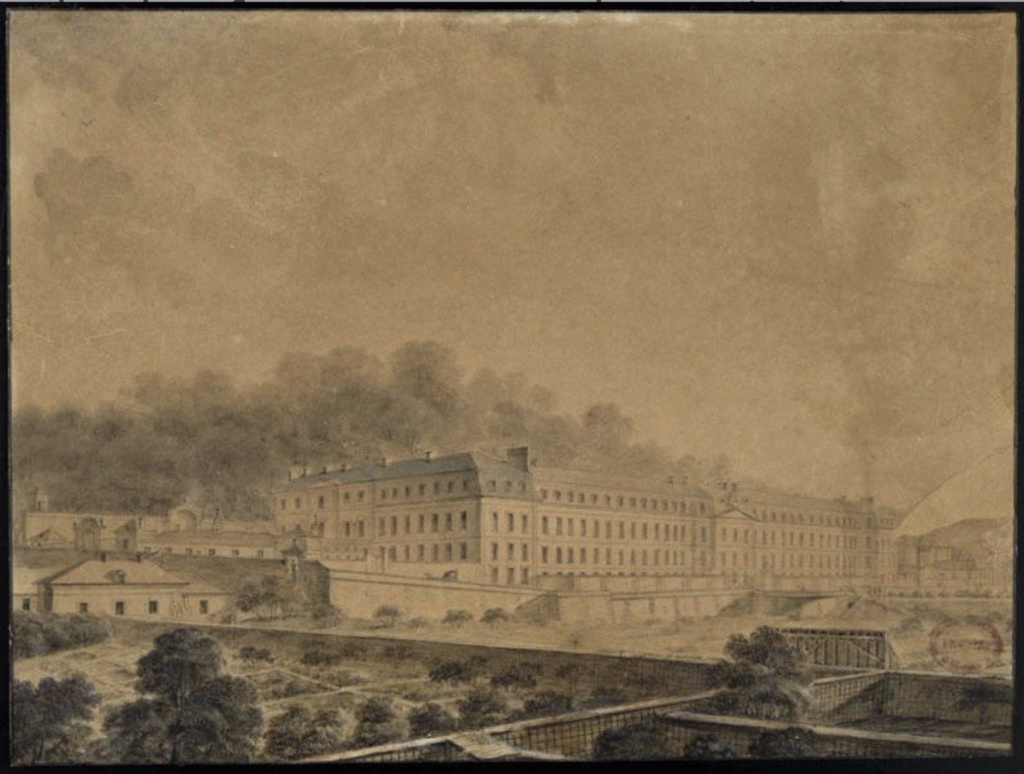
Vue de la Manufacture nationale de porcelaine de Sèvres prise du côté de l'ancienne verrerie
Par Caron : Perruquier-coiffeur de la ville de sèvres
Dessin, 1803
Collections des musées de France (Joconde)
Image : M. de Giovanni, B. Chain - Le Studio Numérique
The architect and engineer Louis Le Masson was employed by the factory to develop new forms for the service, and he looked to Antiquity and Raphael's Vatican paintings for inspiration (Raphael's paintings were widely known through published engravings).
Records surviving at Sèvres and the Archives Nationales, Paris, record both the circumstances of the service's creation and its eventual destination. These records include letters between Charles Flahaut de La Billarderie, comte d'Angivillier (d.1809) who had been appointed Directeur des Batiments du Roi in 1774, and Antoine Regnier, the Director of the Sèvres manufactory. Among other things, the letters detail the technical difficulties faced during the service's production.
(...)
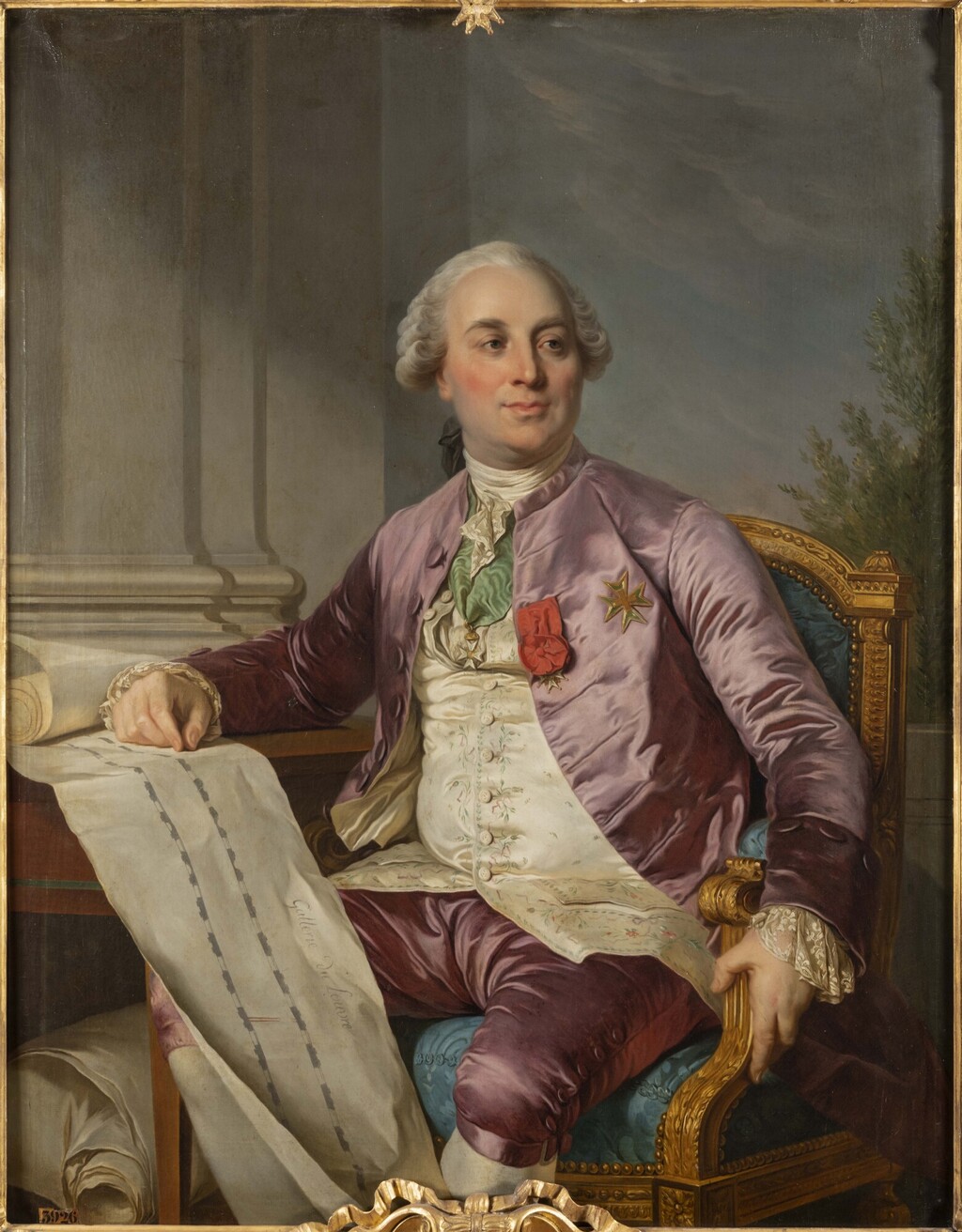
Charles-Claude Flahaut de La Billarderie, comte d'Angiviller
Duplessis, Louis-Joseph-Siffrède
Huile sur toile, 1778
Image : Château de Versailles, Dist. RMN / Christophe Fouin
It is quite clear from the correspondence that the service was originally intended for Louis XVI, even though it was never delivered to him. Work was begun in 1783, and evidence suggests that the service was not completed with all the intended components before production stopped in 1787.
One letter (dated 3rd March 1784) from d'Angiviller to Regnier, which refers to 'le projet de Service du Roi en arabesque', records the intended composition of the service, which was to be for 'vingt-quatre couverts'.
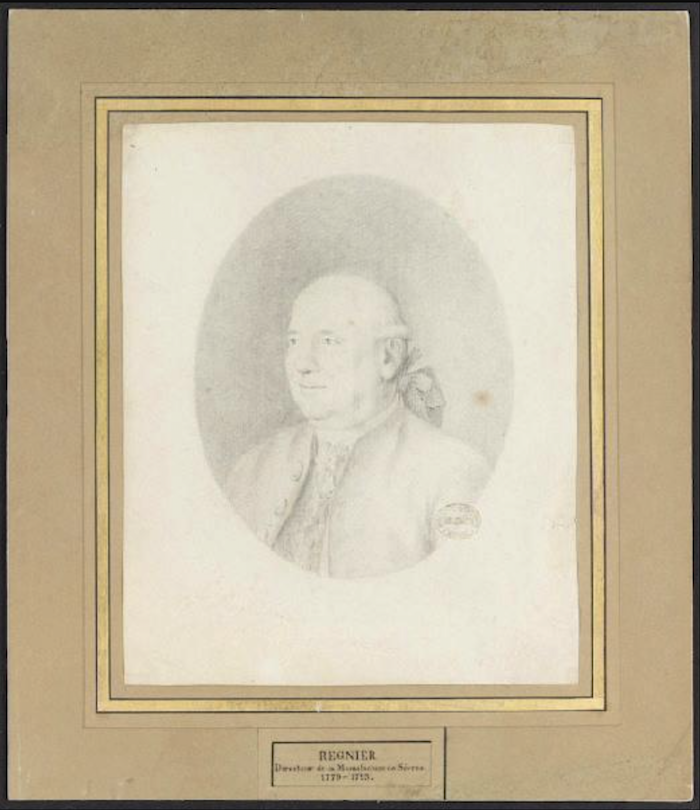
Portrait de Mr Regnier
Anonyme, manufacture de Sèvres
Dessin, 18e siècle
En bas, à l'encre : REGNIER Directeur de la Manufacture de Sèvres 1779 - 1793
Collections des musées de France (Joconde)
Image : M. de Giovanni, B. Chain - Le Studio Numérique
Le Masson based the forms of the service on a variety of Antique forms; the monteith, or seau crénelé, was very clearly based on a Roman sarcophagus; the ice-cream cooler, or seau à glace à trépied, was based on a Roman tripod incense burner, and the saucière was based on a Roman oil-lamp, to name only a few. Le Masson could have based his design for the seau à demi-bouteille on Roman 'columbarium' vase-chambers, which had been promoted a few years earlier by Baron Pierre François Hugues d'Hancarville in his 1767-76 publication of Antiquities Etrusques, Grecques et Romaines.
Le Masson would also have undoubtedly been familiar with two publications by the architect Giovanni Battista Piranesi, Diverse Maniere d'Adornare I Cammine (1769), and Vasi, Candelabra, Cippi.. (1778).
The flared rim and bulbous body of this seau also echoes the Grecian 'krater' bowl, which was used by the ancients for mixing spring water with wine, such as the celebrated marble antique example now known as the 'Warwick' vase.
The frieze of this seau even includes two such Etruscan Pompeiian krater vases, depicted nestling in Roman acanthus leaves and each issuing vines.
The vases are flanked by leopards, which were considered by the ancients to be sacred attendants at triumphal bacchic feasts and harvest festivals, and were frequently depicted pulling Bacchus in his chariot. The frieze also depicts two vine-wreathed masks of 'bacchantae' nymphs, who bore fruit-baskets at bacchic feasts (one mask is now principally lacking due to damage).
Two artists from Sèvres were attached to Le Masson, who was based at Versailles, to assist him with producing designs for the service. Initially Étienne-Henry Le Guay, and then additionally, his son, Étienne-Charles Le Guay.
Each item of the service had a different decorative scheme, which was mapped out in watercolour sketches, presumably carried out by one or the other of the Le Guays.
The watercolour sketches were subsequently used by the factory painters as a basis for their decoration. Some of the watercolour sketches are still at Sèvres, and are published by Hessling and Lechevallier-Chevignard, Documents anciens de la Manufacture nationale de Sèvres - choix de compositions et de projets de décoration des époques de Louis XVI et du Directoire (plate. XV, fig. 2 is illustrated opposite), and by Sandier and Lechevallier-Chevignard, Les Cartons de la Manufacture nationale de Sèvres - époques Louis XVI et Empire.
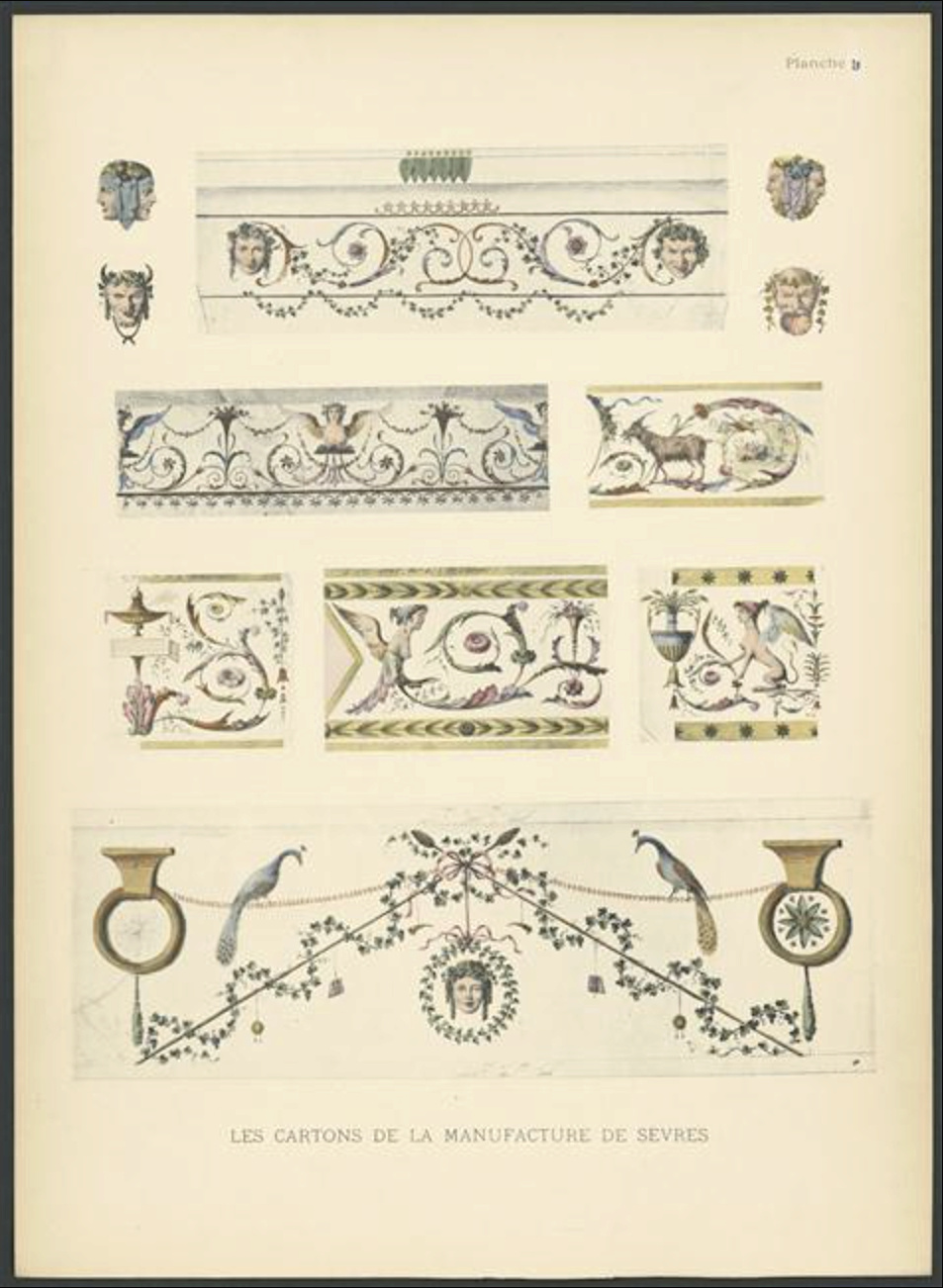
Motifs de frise du seau à bouteille, de saladiers et de pièces diverses du service Masson (ou service arabesque), modèle 1784.
Sandier, Alex, Les cartons de la manufacture nationale de Sèvres, Epoques Louis XVI et Empire, Paris, Ch. Massin.
Image : Ministère de la Culture -Médiathèque de l'architecture et du patrimoine, Dist. RMN-Grand Palais / image RMN-GP
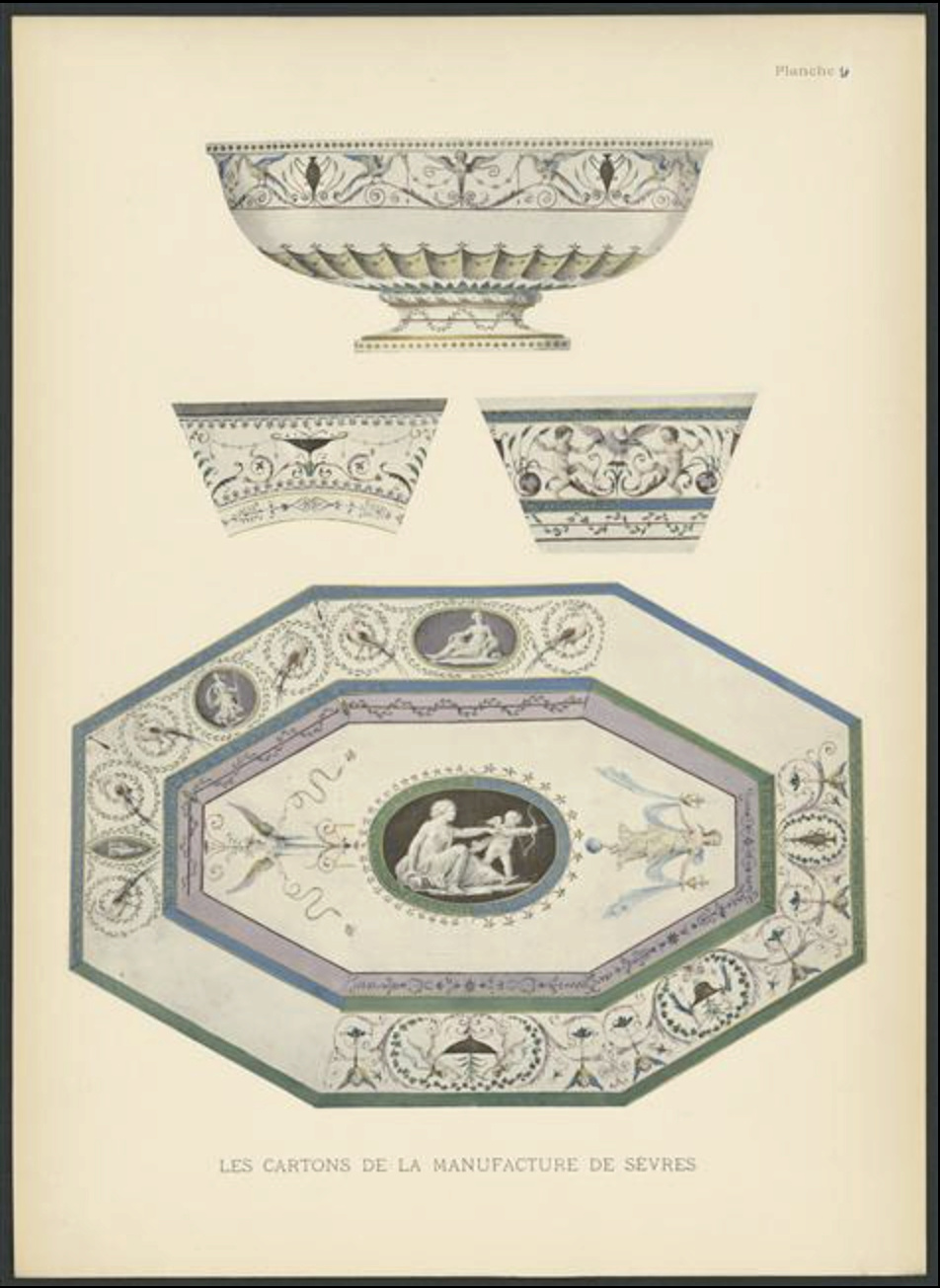
Planche 9. Service arabesque par Masson (1784)
Sandier, Alex, Les cartons de la manufacture nationale de Sèvres, Epoques Louis XVI et Empire, Paris, Ch. Massin.
Image : Ministère de la Culture -Médiathèque de l'architecture et du patrimoine, Dist. RMN-Grand Palais / image RMN-GP

Planche 20. Service arabesque par Masson (1784)
Sandier, Alex, Les cartons de la manufacture nationale de Sèvres, Epoques Louis XVI et Empire, Paris, Ch. Massin.
Image : Ministère de la Culture -Médiathèque de l'architecture et du patrimoine, Dist. RMN-Grand Palais / image RMN-GP
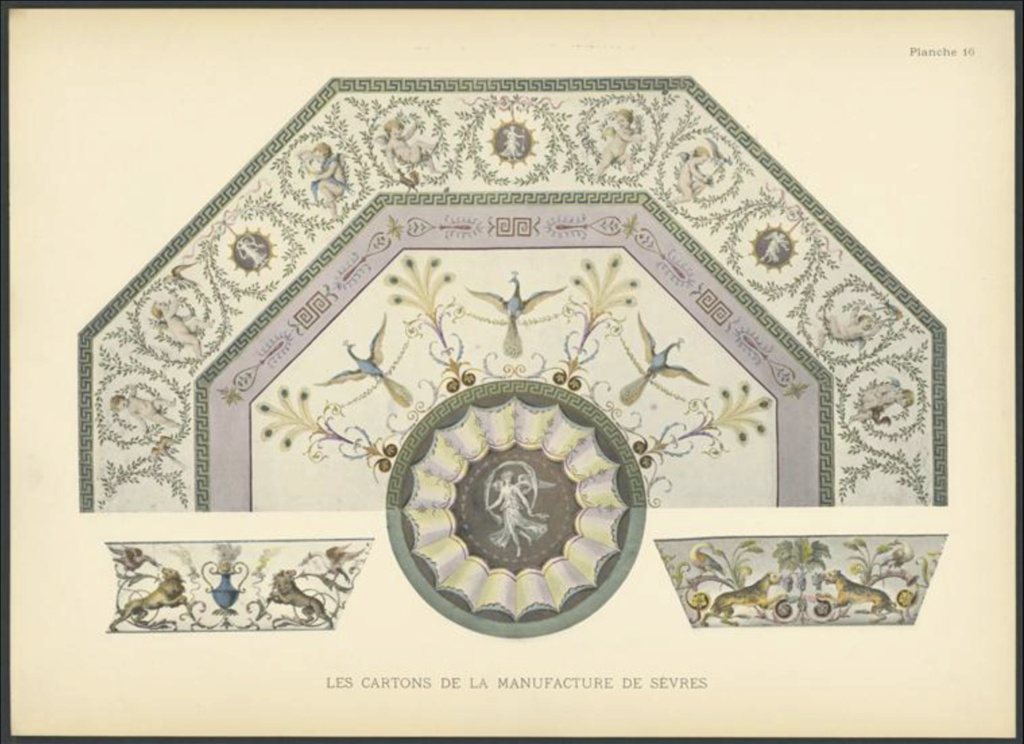
Planche 16. Service arabesque par Masson (1784)
Sandier, Alex, Les cartons de la manufacture nationale de Sèvres, Epoques Louis XVI et Empire, Paris, Ch. Massin.
Image : Ministère de la Culture -Médiathèque de l'architecture et du patrimoine, Dist. RMN-Grand Palais / image RMN-GP
Regnier requested a design for a seau à bouteille from Le Masson in January 1784, and the completed four 4 seaux à ½ bouteilles appear on his un-dated 1785 report of pieces already completed (at the cost of 1,500 livres each). The Sèvres Artist's List (41, 6.1785) records 'Le Guay' as having decorated this seau with '4 Léopards, et deux Testes'. It is interesting to note how closely the decoration follows the original watercolour sketch.
It is not known which Royal interior the service was commissioned for. Such an innovative neo-classical service would have harmonised well with the architectural schemes being carried out at that time for Louis XVI and Marie Antoinette at the Château de Marly and elsewhere. Nor is it known why the service was never delivered to Louis XVI.
Whatever the reason, the service did not leave Sèvres until after the revolution. The 'first coalition' of European forces which came together against the new French Empire shortly after the revolution included Britain, Austria, Prussia, Spain, Piedmont and the Kingdom of Naples.
Prussia soon decided to opt out of this coalition, and it was Karl August, Freiherr von Hardenberg, the Prussian Minister of State, who successfully represented Prussia's negotiated peace with the French, culminating in April 1794 with the Treaty of Basel, which declared Prussia neutral. Hardenberg was a co-signatory of the treaty, and as was customary, he was to be the recipient of an important diplomatic gift.
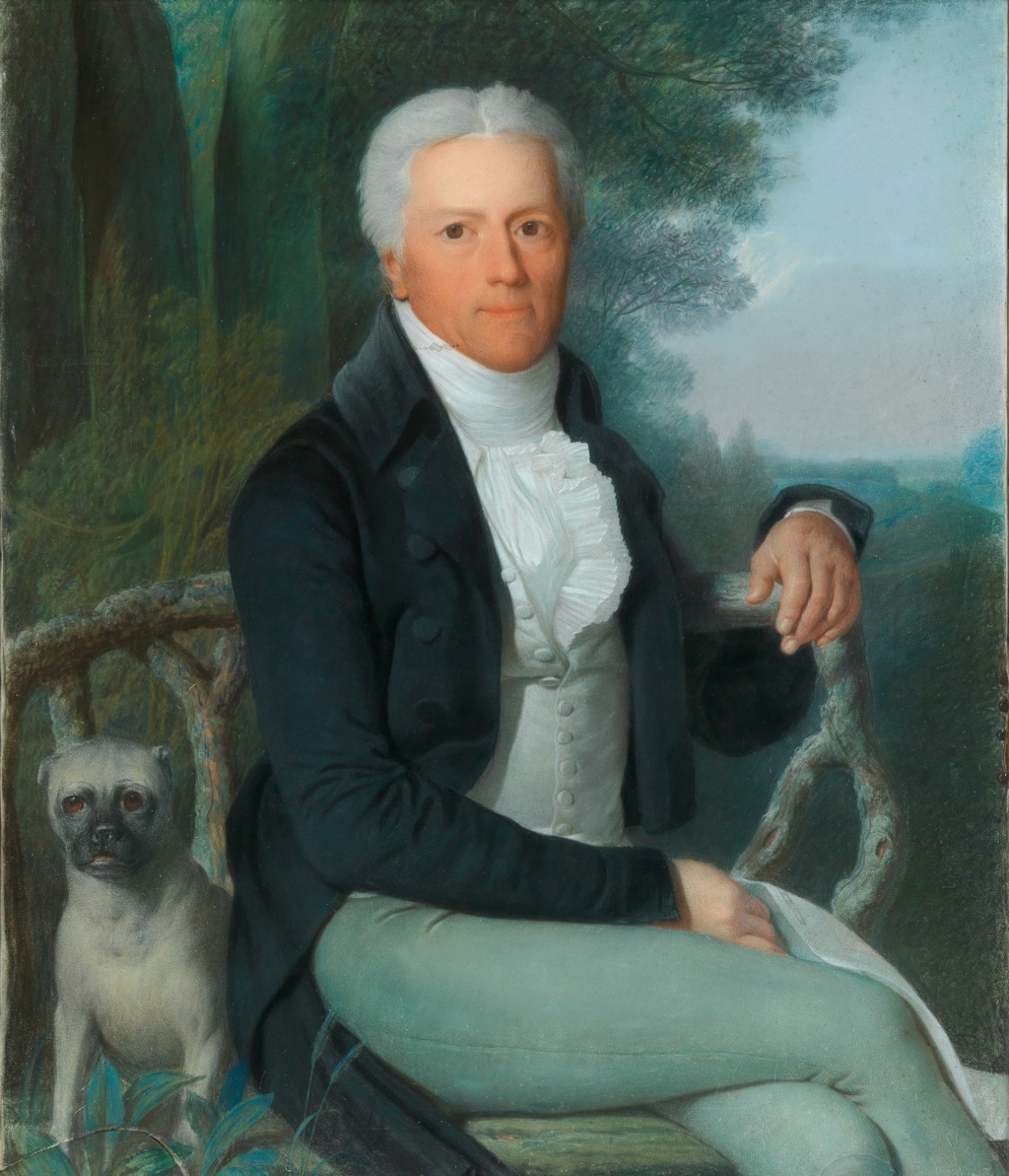
Portrait of prince Karl August von Hardenberg (1750-1822) in the park of his country estate at Tempelhof near Berlin
By Daniel Caffe
Pastel on paper
Image : Dorotheum
A series of letters in the Archives Nationales (AN F12 14952, Nos. 94-117), record the process whereby the service was selected as an appropriate diplomatic gift to Hardenberg. Much of the correspondence makes reference to the service as having been originally for the King, referring to Louis in derogatory terms.
An undated Commission des Revenues Nationaux report (No. 115) lists the contents of the service, describing the shape and decoration as being : de forme du gout antique le plus severe, et decorées des superbes arabesques de Raphael. It was deemed suitable as a diplomatic gift, and shortly after 22nd November 1795, it was despatched to Hardenberg in Basel.
(...)
* Source texte (extraits) : Christie's
Dernière édition par La nuit, la neige le Sam 13 Mai 2023, 17:18, édité 1 fois

La nuit, la neige- Messages : 18132
Date d'inscription : 21/12/2013
 Re: Les porcelaines de Sèvres du roi Louis XVI (services et divers)
Re: Les porcelaines de Sèvres du roi Louis XVI (services et divers)
La nuit, la neige a écrit:Merci !
Je ne comprends pas cette date du cartel, puisque Christie's annonçait les " lettres-date pour 1784 " au dos de la pièce.
Bon...
Le cartel est erroné car le catalogue de l'expo indique bien que cette pièce date de 1784.
Merci pour les belles images de ce service tout simplement prodigieux.
Voici un pot à oille et son plateau du même service (collection particulière) :

Les premières pièces du service furent soumises à Angiviller en septembre 1783, et une partie du service fut exposée en janvier 1784 dans l'appartement de Louis XVI. Ces premières pièces réalisées en porcelaine dure par des peintres peu habitués à ce genre de décor, ne donnèrent pas entière satisfaction au directeur, qui suggéra plus d'application aux peintres et l'emploi de la porcelaine tendre afin d'obtenir "moins de lourdeur". Le résultat était tellement dans le "goût antique le plus sévère" que la manufacture devança les critiques en estimant que "ce genre de beauté est trop au-dessus du goût de la plupart des consommateurs...".
C'est en raison de la difficulté de réalisation de ce service que la production en fut ralentie, si bien qu'il n'était toujours pas achevé lorsque la Révolution éclata. Il était toujours en magasin à ce moment-là. Sur la centaine de pièces réalisées, seule une vingtaine est aujourd'hui connue.
Même si le projet de ce service ne put aboutir complètement, son influence fut considérable : plusieurs services de Sèvres adoptèrent les formes nouvelles inventées par Le Masson, comme les saucières et les glacières à tête de lion. Surtout, la nouveauté de ce service imitant l'antique devait en inspirer un autre : celui de la laiterie de Rambouillet, dont la réalisation bénéficia de cette expérience.
Source : Renaud Serrette, "Louis Le Masson, la fascination de l'antique et de l'Italie", in "Vivre à l'antique, de Marie-Antoinette à Napoléon Ier", éd. Monelle Hayot.

Duc d'Ostrogothie- Messages : 3227
Date d'inscription : 04/11/2017
 Re: Les porcelaines de Sèvres du roi Louis XVI (services et divers)
Re: Les porcelaines de Sèvres du roi Louis XVI (services et divers)
Merci pour cette contribution... 
 Voici le croquis de cette pièce :
Voici le croquis de cette pièce :

Jatte du service Arabesque dit Masson
Louis Le Masson (1743-1829)
Dessin aquarellé, 18e siècle
Image : Sèvres - Manufacture et musée nationaux, Dist. RMN-Grand Palais / Le Studio Numérique
 Ainsi que ceux des "glacières à tête de lion " évoquées dans l'article.
Ainsi que ceux des "glacières à tête de lion " évoquées dans l'article.
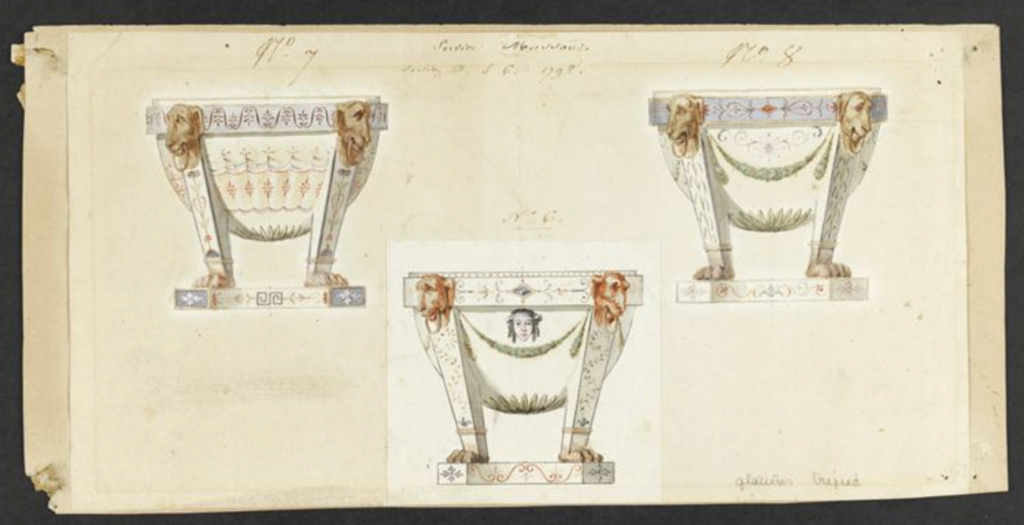
Glacières à trépieds du service Arabesque dit 'Masson'
Louis Le Masson (1743-1829)
Dessin aquarellé, 18e siècle
Image : Sèvres - Manufacture et musée nationaux, Dist. RMN-Grand Palais / Le Studio Numérique

Glacière du service Arabesque dit Masson
Louis Le Masson (1743-1829)
Dessin aquarellé, 18e siècle
Image : Sèvres - Manufacture et musée nationaux, Dist. RMN-Grand Palais / Le Studio Numérique

Service Arabesque dit Masson : éléments décoratifs
Variante pour le pied de la glacière
Louis Le Masson (1743-1829)
Dessin aquarellé, 18e siècle
Image : Sèvres - Manufacture et musée nationaux, Dist. RMN-Grand Palais / Le Studio Numérique
 Pour avoir une idée de ces exceptionnelles glacières sur pieds, nous avions récemment présenté un modèle similaire réalisé par Sèvres, mais avec un autre décor, dans notre sujet :
Pour avoir une idée de ces exceptionnelles glacières sur pieds, nous avions récemment présenté un modèle similaire réalisé par Sèvres, mais avec un autre décor, dans notre sujet :
 Porcelaine de Sèvres : chinoiseries à fond noir ou fond d'écaille à l'imitation du laque
Porcelaine de Sèvres : chinoiseries à fond noir ou fond d'écaille à l'imitation du laque
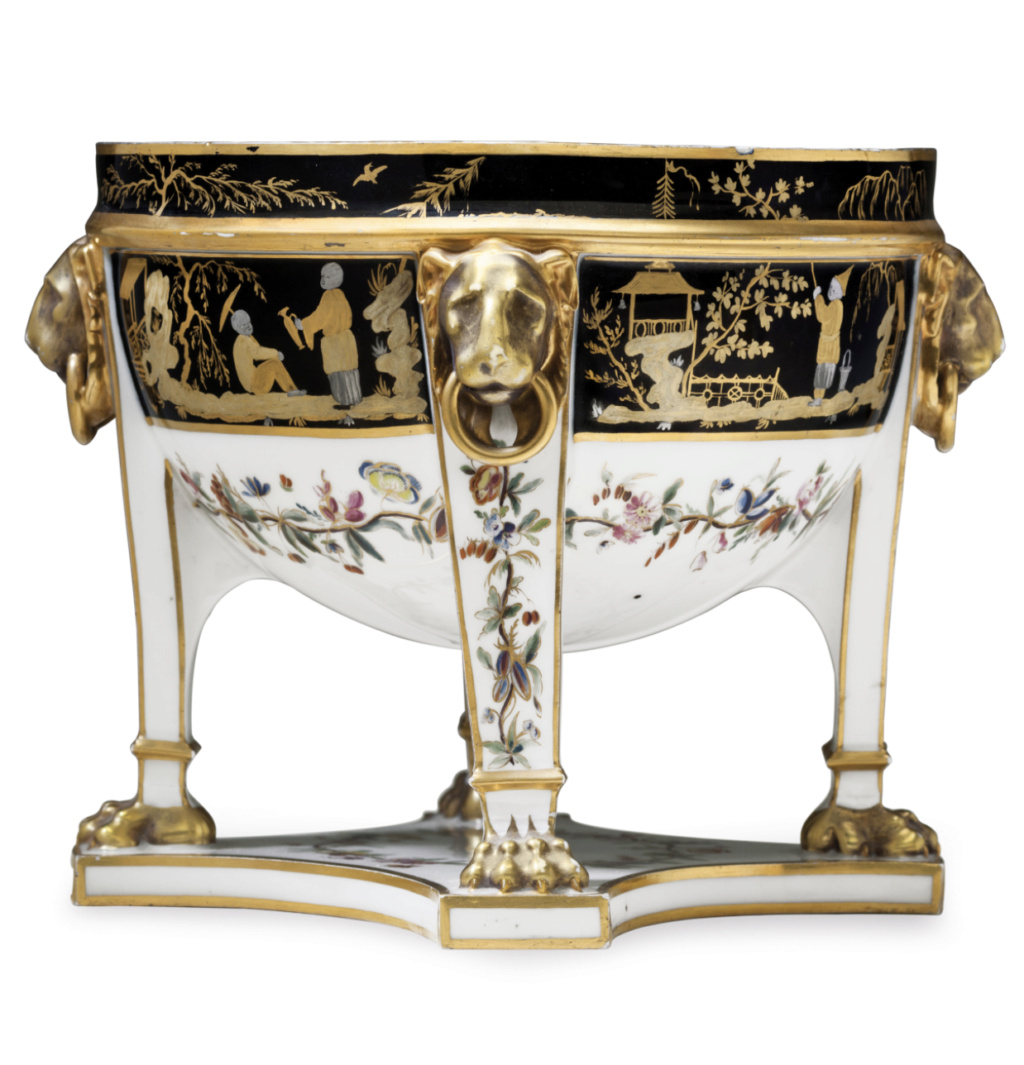
A Sèvres Porcelain Black-ground Chinoiserie Ice-cooler (sceau à trépied)
Circa 1790-91, blue interlaced L'S mark
Conceived as a brazier, the circular bowl with wide rim decorated with vignettes of chinoiserie figures at various pursuits, including taming a large bird, supported by monopodia paw feet surmounted by lion masks suspending rings, the lower-body, leg and cruci-form base with trailing wreaths of flowering vine, the blossoms edged in gilt in the manner of cloisonné enamel.
Image : Christie's
Provenance : Delivered 6 May 1791 to Charles-Louis Huguet de Sémonville, who served as Envoy- Extraordinary to Genoa 14 July 1791-10 October 1792.

Jatte du service Arabesque dit Masson
Louis Le Masson (1743-1829)
Dessin aquarellé, 18e siècle
Image : Sèvres - Manufacture et musée nationaux, Dist. RMN-Grand Palais / Le Studio Numérique

Glacières à trépieds du service Arabesque dit 'Masson'
Louis Le Masson (1743-1829)
Dessin aquarellé, 18e siècle
Image : Sèvres - Manufacture et musée nationaux, Dist. RMN-Grand Palais / Le Studio Numérique

Glacière du service Arabesque dit Masson
Louis Le Masson (1743-1829)
Dessin aquarellé, 18e siècle
Image : Sèvres - Manufacture et musée nationaux, Dist. RMN-Grand Palais / Le Studio Numérique

Service Arabesque dit Masson : éléments décoratifs
Variante pour le pied de la glacière
Louis Le Masson (1743-1829)
Dessin aquarellé, 18e siècle
Image : Sèvres - Manufacture et musée nationaux, Dist. RMN-Grand Palais / Le Studio Numérique

A Sèvres Porcelain Black-ground Chinoiserie Ice-cooler (sceau à trépied)
Circa 1790-91, blue interlaced L'S mark
Conceived as a brazier, the circular bowl with wide rim decorated with vignettes of chinoiserie figures at various pursuits, including taming a large bird, supported by monopodia paw feet surmounted by lion masks suspending rings, the lower-body, leg and cruci-form base with trailing wreaths of flowering vine, the blossoms edged in gilt in the manner of cloisonné enamel.
Image : Christie's
Provenance : Delivered 6 May 1791 to Charles-Louis Huguet de Sémonville, who served as Envoy- Extraordinary to Genoa 14 July 1791-10 October 1792.

La nuit, la neige- Messages : 18132
Date d'inscription : 21/12/2013
 Re: Les porcelaines de Sèvres du roi Louis XVI (services et divers)
Re: Les porcelaines de Sèvres du roi Louis XVI (services et divers)
Le dessin de la jatte propose deux décors différents, dont l'un est dans l'esprit du seau à bouteille présenté chez Adrian Sassoon.
La forme nouvelle des glacières à tête de lion a inspiré le bol sein de la laiterie de Rambouillet (R. Serrette, article précité).
La forme nouvelle des glacières à tête de lion a inspiré le bol sein de la laiterie de Rambouillet (R. Serrette, article précité).

Duc d'Ostrogothie- Messages : 3227
Date d'inscription : 04/11/2017
 Re: Les porcelaines de Sèvres du roi Louis XVI (services et divers)
Re: Les porcelaines de Sèvres du roi Louis XVI (services et divers)
Cette porcelaine est à mourir ............. 


Un grand merci pour ce splendide sujet si magnifiquement illustré, documenté, commenté !
Un mot peut-être sur Louis Le Masson.
Et tout d'abord, bonjour Monsieur !

Il fit en 1778 un séjour en Italie. Un gros coup de coeur pour Rome lui donna l'idée de grimper sur le Janicule afin de dessiner la ville éternelle dans sa globalité. Il représenta l’ensemble du paysage vu sur 360°. De retour à Paris, il grava ses dessins à l’eau forte en cinq planches de 36 pouces de longueur... il avait inventé le panorama ! ( avant les Anglais Fulton et Barker ) .
De retour en France, en 1780, il fut chargé, par le duc de Sérent, gouverneur des ducs d'Angoulême et de Berry, d'enseigner les rudiments de son art à ces deux princes.
C'est Louis Le Masson qui construisit le palais abbatial de Royaumont que nous connaissons bien pour y avoir vu vivre comme un pacha l'abbé de Ballivières ( proche parent et intime des Polignac, qui quitte la France au lendemain de la prise de la Bastille avec le duc, la duchesse, la comtesse Diane et Guichette ) et puis Jean de Travanet ( banquier du Jeu de la Reine et beau-frère de Marc de Bombelles ) .
https://marie-antoinette.forumactif.org/t4308-le-marquis-de-travanet-banquier-du-jeu-de-la-reine?highlight=TRAVANET
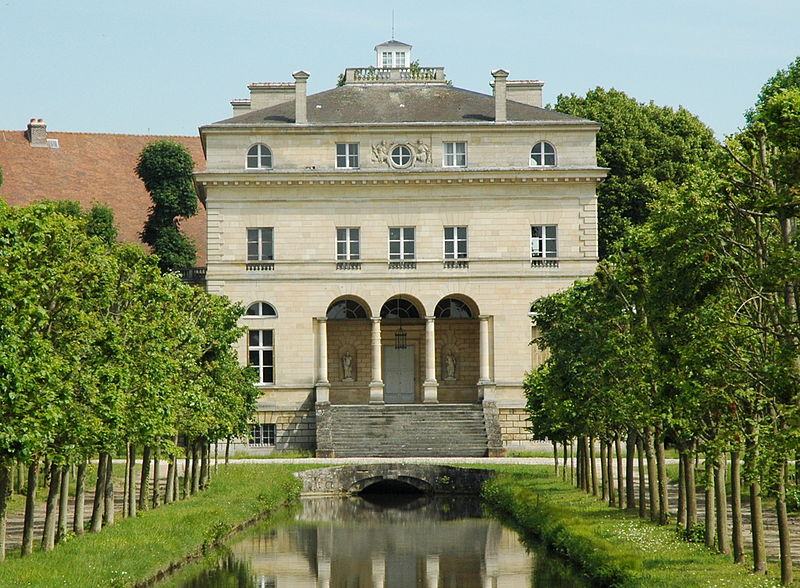



Un grand merci pour ce splendide sujet si magnifiquement illustré, documenté, commenté !

Un mot peut-être sur Louis Le Masson.
Et tout d'abord, bonjour Monsieur !

Il fit en 1778 un séjour en Italie. Un gros coup de coeur pour Rome lui donna l'idée de grimper sur le Janicule afin de dessiner la ville éternelle dans sa globalité. Il représenta l’ensemble du paysage vu sur 360°. De retour à Paris, il grava ses dessins à l’eau forte en cinq planches de 36 pouces de longueur... il avait inventé le panorama ! ( avant les Anglais Fulton et Barker ) .
De retour en France, en 1780, il fut chargé, par le duc de Sérent, gouverneur des ducs d'Angoulême et de Berry, d'enseigner les rudiments de son art à ces deux princes.
C'est Louis Le Masson qui construisit le palais abbatial de Royaumont que nous connaissons bien pour y avoir vu vivre comme un pacha l'abbé de Ballivières ( proche parent et intime des Polignac, qui quitte la France au lendemain de la prise de la Bastille avec le duc, la duchesse, la comtesse Diane et Guichette ) et puis Jean de Travanet ( banquier du Jeu de la Reine et beau-frère de Marc de Bombelles ) .
https://marie-antoinette.forumactif.org/t4308-le-marquis-de-travanet-banquier-du-jeu-de-la-reine?highlight=TRAVANET

_________________
... demain est un autre jour .

Mme de Sabran- Messages : 55497
Date d'inscription : 21/12/2013
Localisation : l'Ouest sauvage
 Re: Les porcelaines de Sèvres du roi Louis XVI (services et divers)
Re: Les porcelaines de Sèvres du roi Louis XVI (services et divers)
Poursuivons avec quelques-unes des rarissimes assiettes de ce service...

Motif décoratif (frise, ornements) du service Arabesque dit 'Masson'
Louis Le Masson (1743-1829)
Dessin aquarellé, 18e siècle
Image : Sèvres - Manufacture et musée nationaux, Dist. RMN-Grand Palais / Le Studio Numérique
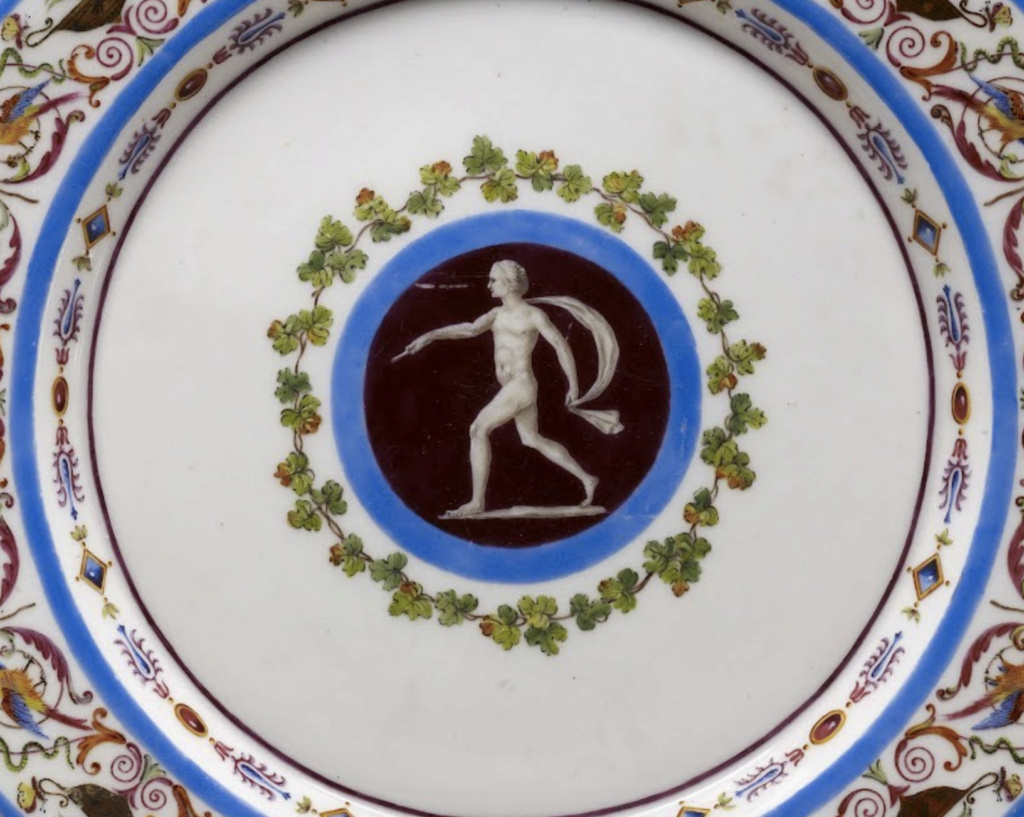
Detail - Plate from the service Arabesque
Sèvres Porcelain Manufactory, 1784
Decorated by Jacques Fontaine (French, 1734–c. 1807)
Soft-paste porcelain
Crossed "L"s marked on the underside in blue with the date letters GG
15/16 × 9 3/8 × 9 3/8 in. (2.4 × 23.8 × 23.8 cm)
Image : The Museum of Fine Arts, Houston
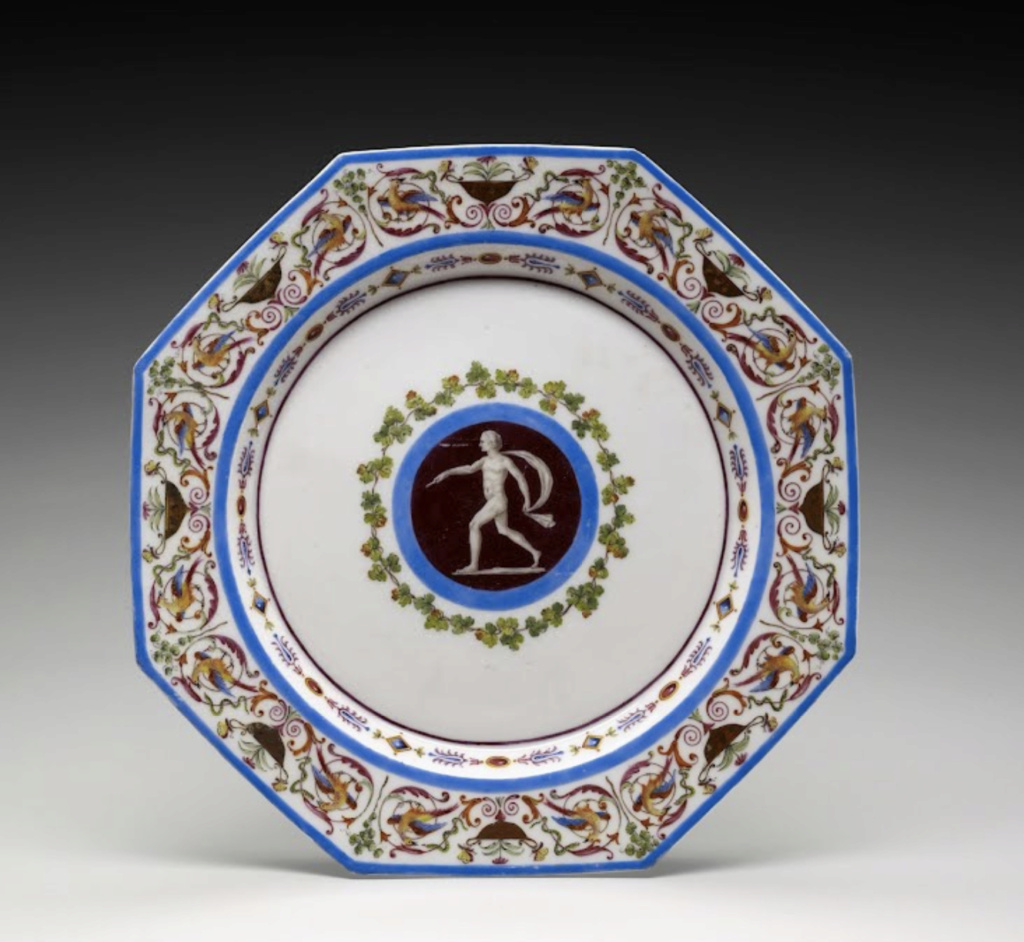
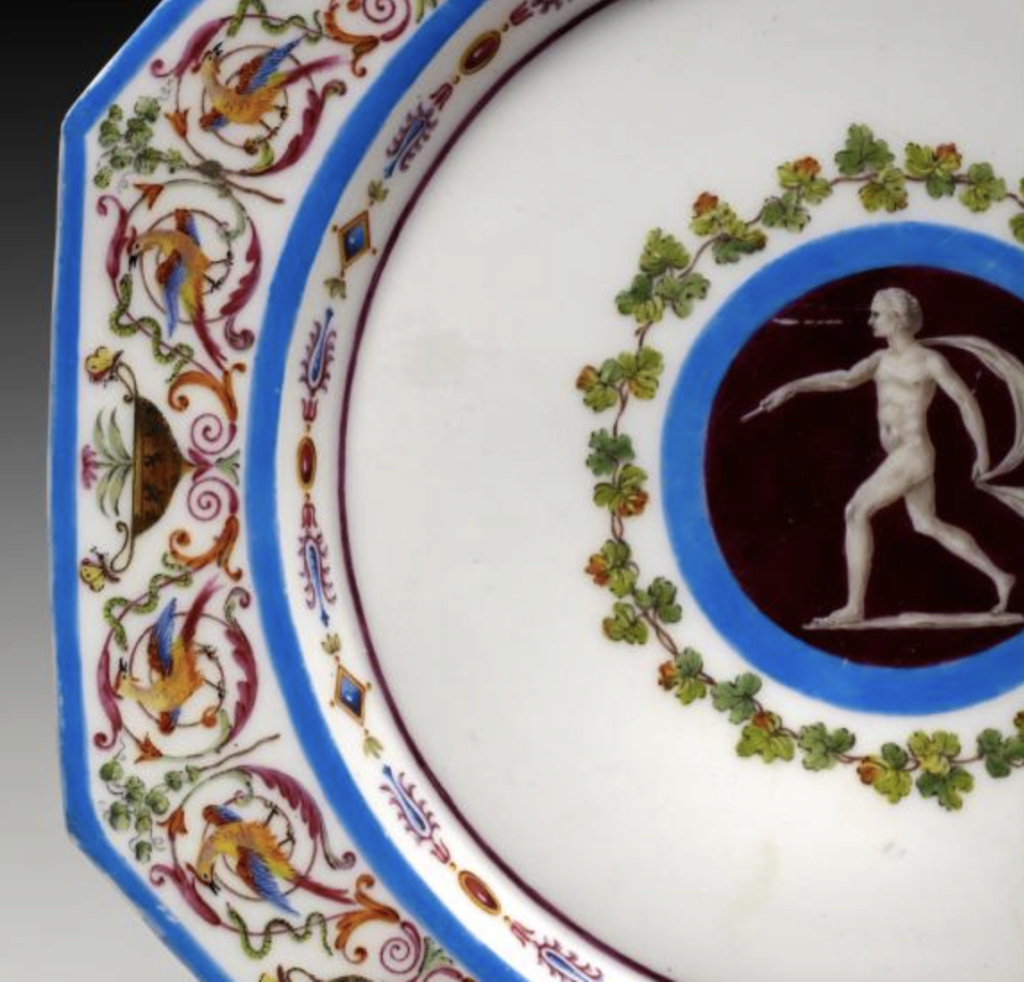
Images : The Museum of Fine Arts, Houston
Description du musée :
In 1782, Louis XVI commissioned from the Sèvres Porcelain Manufactory the last of three royal services, for use at the Château de Versailles. By the time of the French Revolution, more than 100 pieces had been completed.
The service was in the fashionable Neoclassical taste, complete with arabesque decoration based on details from frescoes in the Vatican by Raphael.
Because of the innovative nature of the service, with unusual new shapes and unique painting to each piece, production at Sèvres moved slowly.
Although the service was never completed amidst the turmoil of the French Revolution, in 1795 the existing pieces, which included 51 plates, were given to the Prussian foreign minister. This plate is one of only five from the original 51 known to have survived.

A Sèvres octogonal plate from the Arabesque Masson service
Sèvres Porcelain Manufactory
Circa 1785
Blue interlaced L's enclosing date letter HH for 1785, painter's mark for Fontaine and L'Ecot, incised 18
With a cameo medallion of an athlete carrying a baton on a maroon-ground, within a blue-ground keyfret border and a circlet of oak leaves and a border of stylized foliage and jewels, the rim with brightly enamelled arabesques of snakes-entwined foliage, exotic birds, dragonflies and classical urns within keyfret borders
9in. (23.8cm.) diameter
Image : Christie's (1999)
Lot Essay
From the third and final service commissioned by Louis XVI noted for its unique forms and neoclassical decoration.
One of fifty-one plates presented to Freiherr von Hardenberg, the Sèvres archives record only two plates from the present service decorated by both Fontaine and L'Ecot taken from the kiln on 21 December 1789.
Jacques Fontaine, active at Vincennes and Svres as a painter of flowers, figures, patterns and cameos and as a gilder, 1752-1800.
Louis-François L'Ecot, active at Svres as a painter of chinoiserie, arabesques and butterflies and as a gilder, 1761-1764 and 1772-1800.
 La photo ci-dessus est dégueulasse, mais je pense qu'il s'agit de l'assiette aujourd'hui conservée à l'Art Institute of Chicago. Cependant le diamètre est différent...
La photo ci-dessus est dégueulasse, mais je pense qu'il s'agit de l'assiette aujourd'hui conservée à l'Art Institute of Chicago. Cependant le diamètre est différent... 
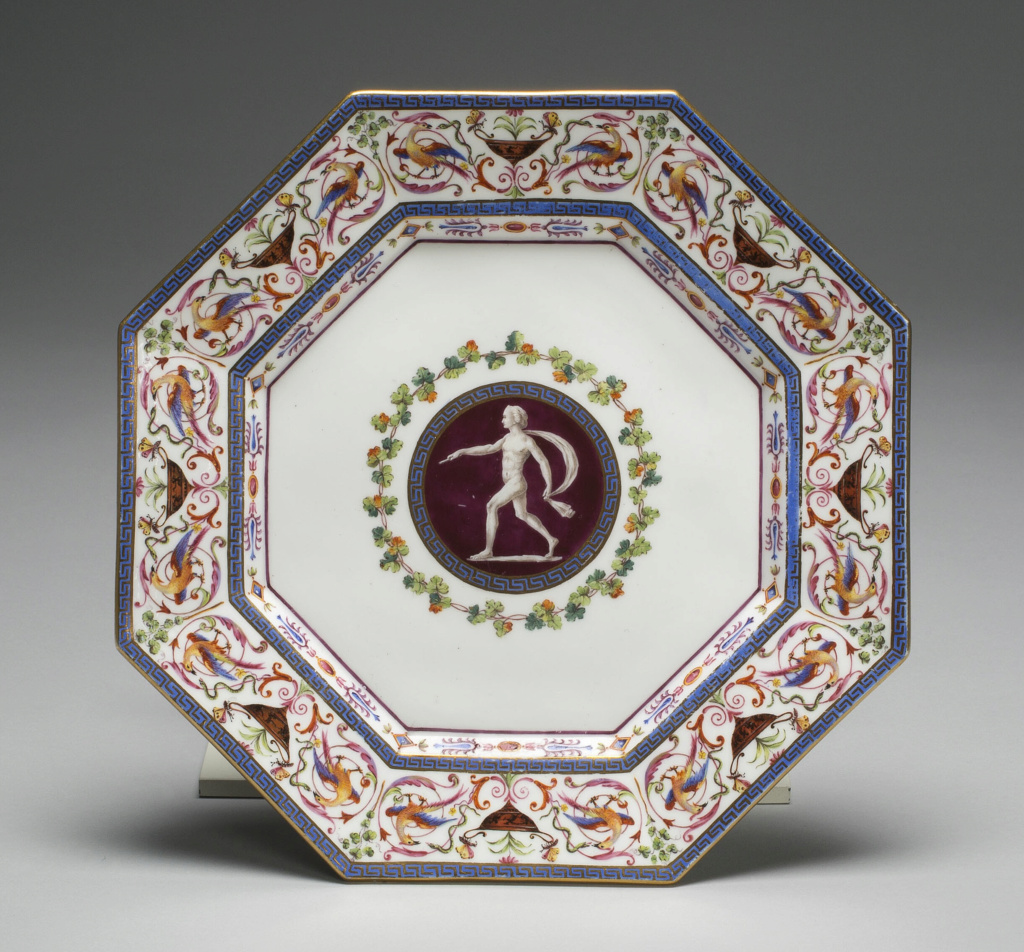

Plate from the Arabesque Service
Sèvres Porcelain Manufactory
1785
Painted by Jacques Fontaine (French, 1734/35-1807, active 1752-1800)
Gilded by Louis-Francois L’Ecot (French, active 1761-1764 and 1772-1800)
Soft-paste porcelain, polychrome enamels, and gilding
Diam. 25.7 cm (10 1/8 in.)
Image : Art Institute Chicago

Motif décoratif (frise, ornements) du service Arabesque dit 'Masson'
Louis Le Masson (1743-1829)
Dessin aquarellé, 18e siècle
Image : Sèvres - Manufacture et musée nationaux, Dist. RMN-Grand Palais / Le Studio Numérique
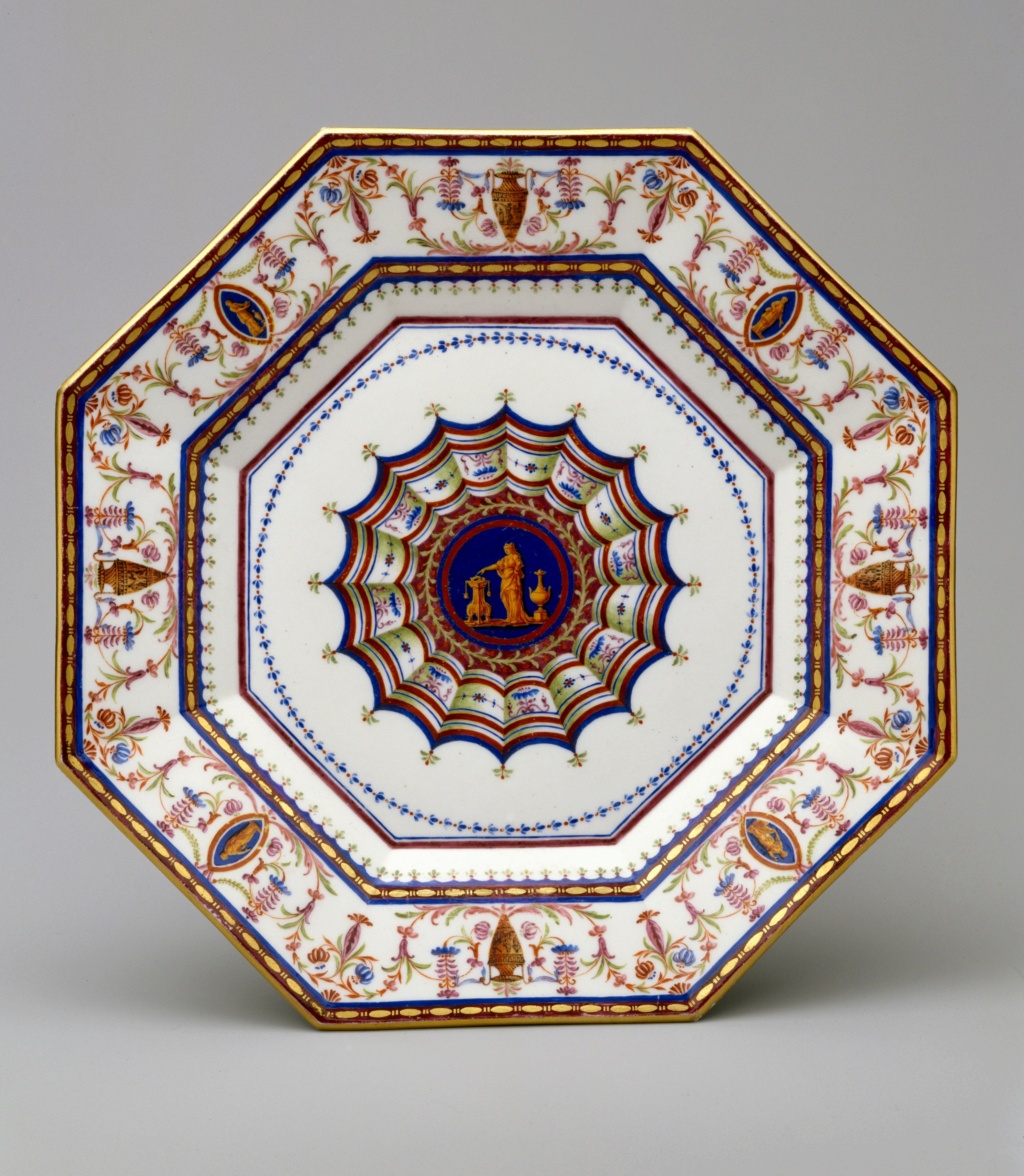
Plate (assiette octogone or assiette platte) from the "Service Arabesque"
France, Sèvres Manufactory
Soft-paste porcelain, ca. 1783–85
Designer : Louis Le Masson (French, 1743–1829)
Decorator: Jean Armand Fallot (French, active 1764–90)
Painted on underside in underglaze red enamel: interlaced Ls with crown above and F (Sèvres factory mark and painter's mark for Fallot)
Diameter: 9 3/8 in. (23.8 cm)
Image : The Metropolitan Museum of Art
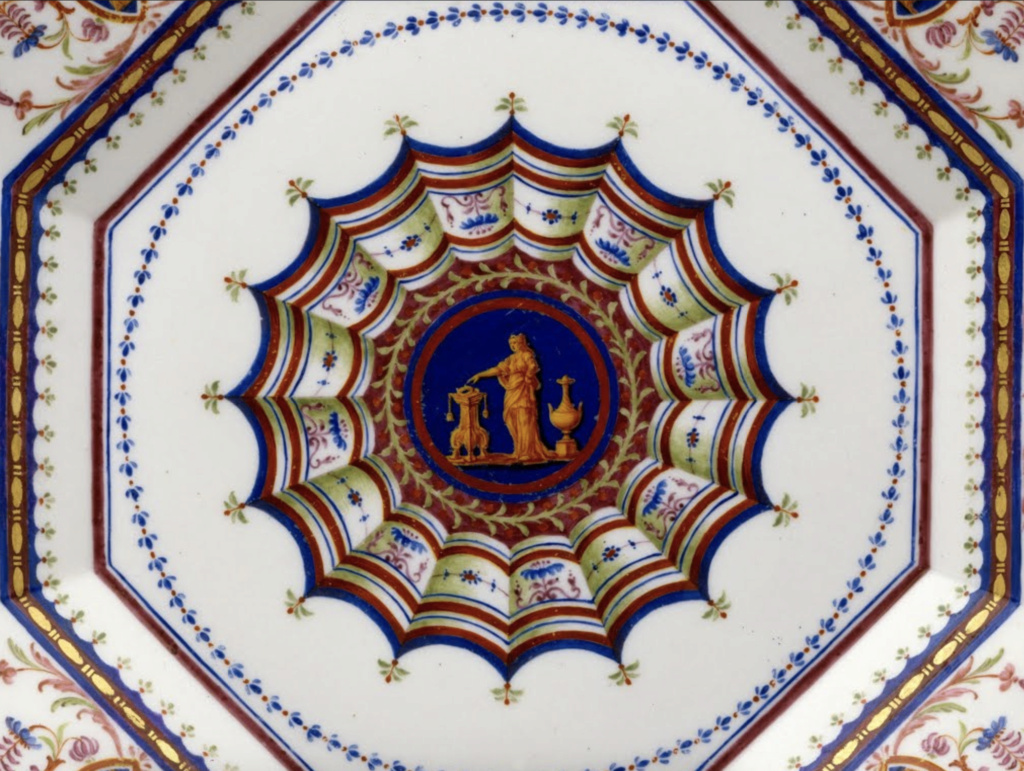
Image : The Metropolitan Museum of Art
Note du musée
This plate is from a remarkable service that reflected the most up-to-date Neoclassicism of the late eighteenth century. The shapes and the decoration were commissioned from the architect Louis le Masson who was instructed that the service should represent "the most rigorous antique taste."
The need for new forms and decorative schemes for the service delayed its production, and it remained incomplete at the outbreak of the Revolution. Less than twenty pieces from the service Arabesque are known today.

A Sevres (hard paste) Royal decagonal plate from the Service arabesque
1783
Crowned interlaced red LS enclosing date letter FF and red triangular Painter's mark for Dieu
9 7/8 in. (25.1 cm.) wide
Image : Christie's (2004)
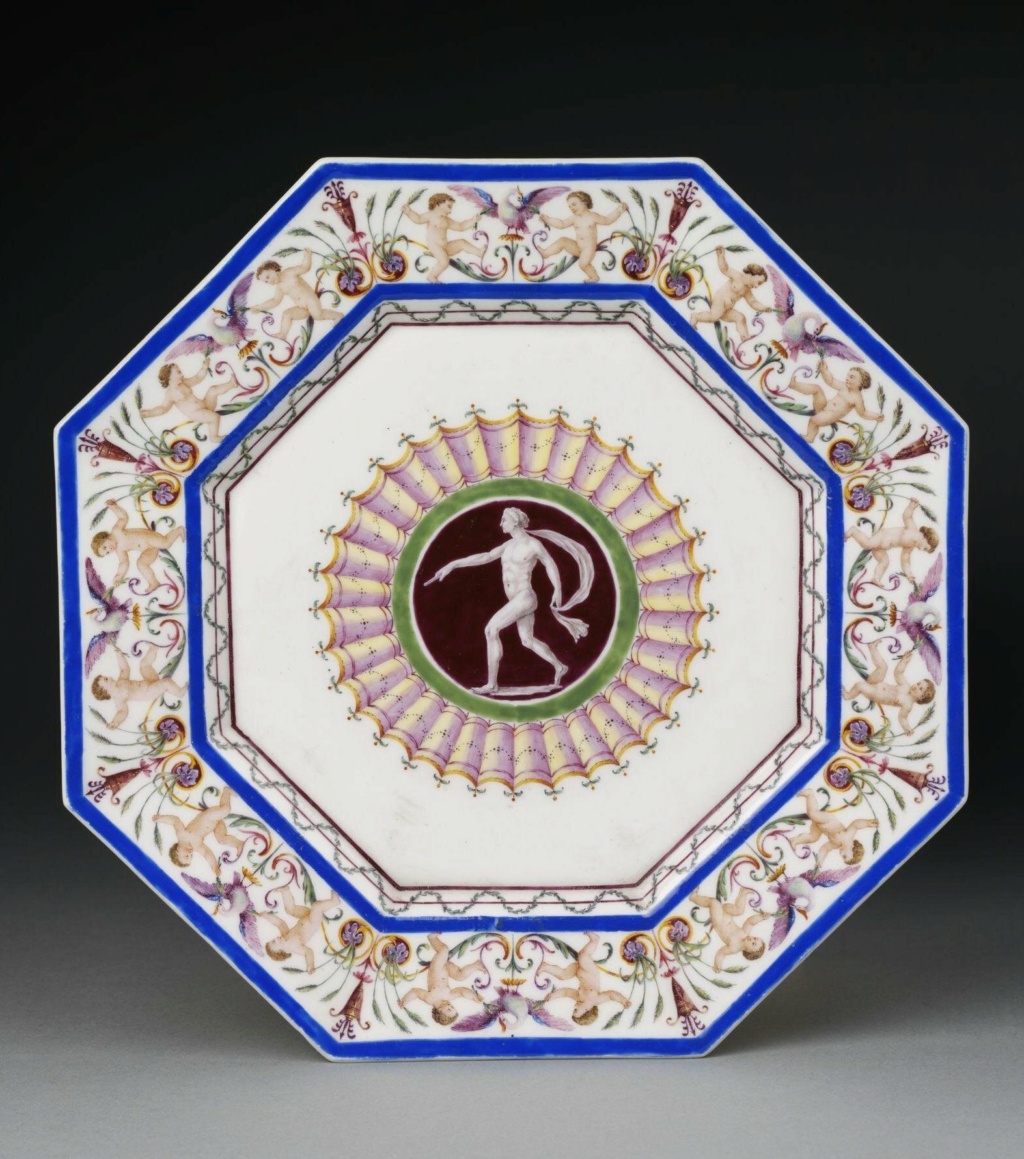
Assiette octagone
Sèvres Porcelain Factory (manufacturer)
Louis Le Masson (designer)
France, 1786
Interlaced 'L's enclosing date letter 'ii' (Maker's mark, in blue enamel with date letter 'ii')
'18' (incised mark)
soft paste porcelain, painted in enamels
Diameter : 24,2 cm
Image : Victoria and Albert Museum, London
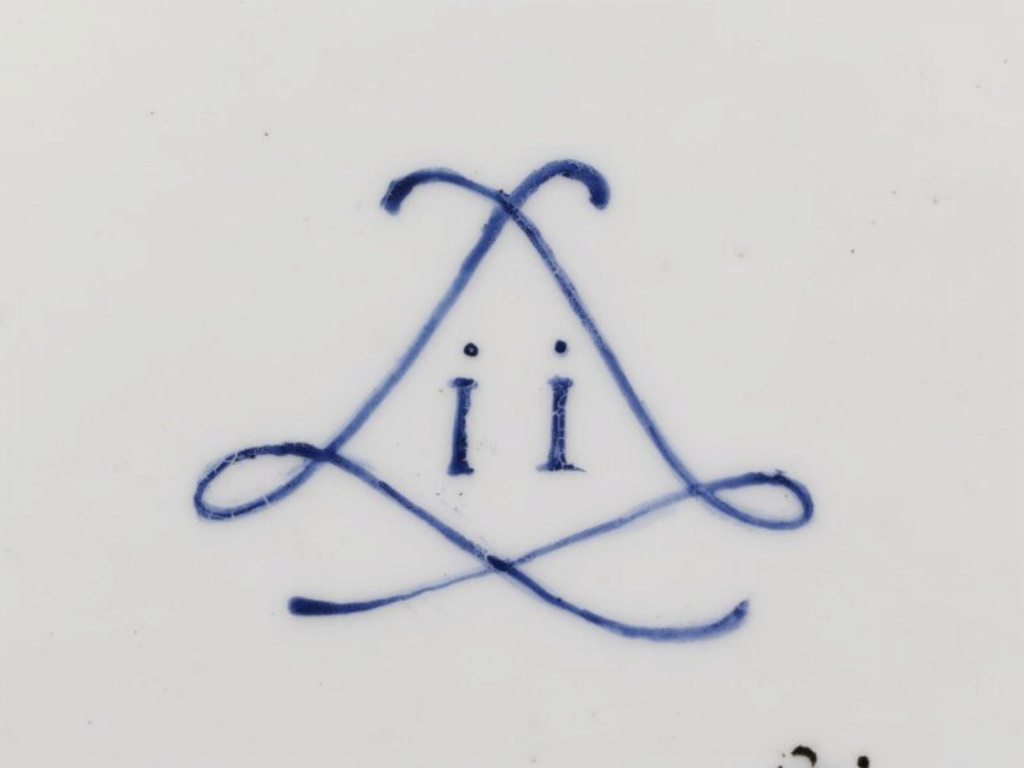
Image : Victoria and Albert Museum, London
Présentation du musée :
This rare Sèvres porcelain plate is from the ‘service arabesques’ commissioned by the French king, Louis XVI in 1783. The service was incomplete ten years later when the king was executed during the French Revolution. Two years later the Revolutionary government gave the service to the Minister of the King of Prussia, Karl-August, Freiherr von Hardenberg, who successfully negotiated peace between France and Prussia in 1795.
The service was designed by the architect Louis Le Masson who was steeped in the neo-classical tradition. He had travelled to Italy funded by a bursary from the crown and on his return in 1781 was appointed tutor in military and civil architecture to the young sons of the comte d'Artois (the future Charles X), the duc d'Angoulême (aged 6) and the duc de Berry (aged 3).

Image : Victoria & Albert Museum, London
His architectural projects are perhaps less well-known today than his work on this remarkable service for which he invented entirely new shapes and style of decoration.
Le Masson based his shapes on Antique marbles and other ornament he had seen in Italy. For the decoration he relied exclusively on the work of the Renaissance artists working under the supervision of Raphael in the Vatican loggia in Rome. This had been inspired by and copied from Nero's Golden House and other sites being excavated at the time whose decoration was characterised by scrolling arabesque and grottesque motifs.
Knowledge of the Vatican decoration had suddenly become available to connoisseurs in the 1770s due to the publication of a set of large-scale engravings by a group of engravers led by Giovanni Volpato. The King bought twelve copies of the publication, six of which were hand-coloured.
In the Sèvres archives today watercolour drawings survive for some shapes and decoration in the service. According to the records, in September 1783 Le Masson asked the Sèvres gilder Etienne-Charles Le Guay to travel to Versailles to copy some pages from the book of the loggia engravings.
The gilder Le Guay was soon joined by his son, Etienne-Charles, a painter who proved much better at copying the designs. The Leguays used the watercolours to design the decoration of the service, supervised by Le Masson. Today the surviving pieces of the service are scattered all over the world in museum and private collections.
* Information taken from an article by John Whitehead, The Sèvres 'arabesque' service and the Vatican Loggia engravings, The French Porcelain Society Journal, Volume III, 2007.

Motif décoratif (frise, ornements) du service Arabesque dit 'Masson'
Louis Le Masson (1743-1829)
Dessin aquarellé, 18e siècle
Image : Sèvres - Manufacture et musée nationaux, Dist. RMN-Grand Palais / Le Studio Numérique

Detail - Plate from the service Arabesque
Sèvres Porcelain Manufactory, 1784
Decorated by Jacques Fontaine (French, 1734–c. 1807)
Soft-paste porcelain
Crossed "L"s marked on the underside in blue with the date letters GG
15/16 × 9 3/8 × 9 3/8 in. (2.4 × 23.8 × 23.8 cm)
Image : The Museum of Fine Arts, Houston


Images : The Museum of Fine Arts, Houston
Description du musée :
In 1782, Louis XVI commissioned from the Sèvres Porcelain Manufactory the last of three royal services, for use at the Château de Versailles. By the time of the French Revolution, more than 100 pieces had been completed.
The service was in the fashionable Neoclassical taste, complete with arabesque decoration based on details from frescoes in the Vatican by Raphael.
Because of the innovative nature of the service, with unusual new shapes and unique painting to each piece, production at Sèvres moved slowly.
Although the service was never completed amidst the turmoil of the French Revolution, in 1795 the existing pieces, which included 51 plates, were given to the Prussian foreign minister. This plate is one of only five from the original 51 known to have survived.

A Sèvres octogonal plate from the Arabesque Masson service
Sèvres Porcelain Manufactory
Circa 1785
Blue interlaced L's enclosing date letter HH for 1785, painter's mark for Fontaine and L'Ecot, incised 18
With a cameo medallion of an athlete carrying a baton on a maroon-ground, within a blue-ground keyfret border and a circlet of oak leaves and a border of stylized foliage and jewels, the rim with brightly enamelled arabesques of snakes-entwined foliage, exotic birds, dragonflies and classical urns within keyfret borders
9in. (23.8cm.) diameter
Image : Christie's (1999)
Lot Essay
From the third and final service commissioned by Louis XVI noted for its unique forms and neoclassical decoration.
One of fifty-one plates presented to Freiherr von Hardenberg, the Sèvres archives record only two plates from the present service decorated by both Fontaine and L'Ecot taken from the kiln on 21 December 1789.

Jacques Fontaine, active at Vincennes and Svres as a painter of flowers, figures, patterns and cameos and as a gilder, 1752-1800.
Louis-François L'Ecot, active at Svres as a painter of chinoiserie, arabesques and butterflies and as a gilder, 1761-1764 and 1772-1800.



Plate from the Arabesque Service
Sèvres Porcelain Manufactory
1785
Painted by Jacques Fontaine (French, 1734/35-1807, active 1752-1800)
Gilded by Louis-Francois L’Ecot (French, active 1761-1764 and 1772-1800)
Soft-paste porcelain, polychrome enamels, and gilding
Diam. 25.7 cm (10 1/8 in.)
Image : Art Institute Chicago

Motif décoratif (frise, ornements) du service Arabesque dit 'Masson'
Louis Le Masson (1743-1829)
Dessin aquarellé, 18e siècle
Image : Sèvres - Manufacture et musée nationaux, Dist. RMN-Grand Palais / Le Studio Numérique

Plate (assiette octogone or assiette platte) from the "Service Arabesque"
France, Sèvres Manufactory
Soft-paste porcelain, ca. 1783–85
Designer : Louis Le Masson (French, 1743–1829)
Decorator: Jean Armand Fallot (French, active 1764–90)
Painted on underside in underglaze red enamel: interlaced Ls with crown above and F (Sèvres factory mark and painter's mark for Fallot)
Diameter: 9 3/8 in. (23.8 cm)
Image : The Metropolitan Museum of Art

Image : The Metropolitan Museum of Art
Note du musée
This plate is from a remarkable service that reflected the most up-to-date Neoclassicism of the late eighteenth century. The shapes and the decoration were commissioned from the architect Louis le Masson who was instructed that the service should represent "the most rigorous antique taste."
The need for new forms and decorative schemes for the service delayed its production, and it remained incomplete at the outbreak of the Revolution. Less than twenty pieces from the service Arabesque are known today.

A Sevres (hard paste) Royal decagonal plate from the Service arabesque
1783
Crowned interlaced red LS enclosing date letter FF and red triangular Painter's mark for Dieu
9 7/8 in. (25.1 cm.) wide
Image : Christie's (2004)

Assiette octagone
Sèvres Porcelain Factory (manufacturer)
Louis Le Masson (designer)
France, 1786
Interlaced 'L's enclosing date letter 'ii' (Maker's mark, in blue enamel with date letter 'ii')
'18' (incised mark)
soft paste porcelain, painted in enamels
Diameter : 24,2 cm
Image : Victoria and Albert Museum, London

Image : Victoria and Albert Museum, London
Présentation du musée :
This rare Sèvres porcelain plate is from the ‘service arabesques’ commissioned by the French king, Louis XVI in 1783. The service was incomplete ten years later when the king was executed during the French Revolution. Two years later the Revolutionary government gave the service to the Minister of the King of Prussia, Karl-August, Freiherr von Hardenberg, who successfully negotiated peace between France and Prussia in 1795.
The service was designed by the architect Louis Le Masson who was steeped in the neo-classical tradition. He had travelled to Italy funded by a bursary from the crown and on his return in 1781 was appointed tutor in military and civil architecture to the young sons of the comte d'Artois (the future Charles X), the duc d'Angoulême (aged 6) and the duc de Berry (aged 3).

Image : Victoria & Albert Museum, London
His architectural projects are perhaps less well-known today than his work on this remarkable service for which he invented entirely new shapes and style of decoration.
Le Masson based his shapes on Antique marbles and other ornament he had seen in Italy. For the decoration he relied exclusively on the work of the Renaissance artists working under the supervision of Raphael in the Vatican loggia in Rome. This had been inspired by and copied from Nero's Golden House and other sites being excavated at the time whose decoration was characterised by scrolling arabesque and grottesque motifs.
Knowledge of the Vatican decoration had suddenly become available to connoisseurs in the 1770s due to the publication of a set of large-scale engravings by a group of engravers led by Giovanni Volpato. The King bought twelve copies of the publication, six of which were hand-coloured.
In the Sèvres archives today watercolour drawings survive for some shapes and decoration in the service. According to the records, in September 1783 Le Masson asked the Sèvres gilder Etienne-Charles Le Guay to travel to Versailles to copy some pages from the book of the loggia engravings.
The gilder Le Guay was soon joined by his son, Etienne-Charles, a painter who proved much better at copying the designs. The Leguays used the watercolours to design the decoration of the service, supervised by Le Masson. Today the surviving pieces of the service are scattered all over the world in museum and private collections.
* Information taken from an article by John Whitehead, The Sèvres 'arabesque' service and the Vatican Loggia engravings, The French Porcelain Society Journal, Volume III, 2007.

La nuit, la neige- Messages : 18132
Date d'inscription : 21/12/2013
 Re: Les porcelaines de Sèvres du roi Louis XVI (services et divers)
Re: Les porcelaines de Sèvres du roi Louis XVI (services et divers)
Suite à la présentation ci-dessus des services de table de " style arabesque ", dont celui commandé par Louis XVI...
 Voici deux vases exceptionnels vendus aux enchères que nous annoncions, il y a quelques jours, et avec de très belles images en exclusivité, dans notre sujet :
Voici deux vases exceptionnels vendus aux enchères que nous annoncions, il y a quelques jours, et avec de très belles images en exclusivité, dans notre sujet :
 Sotheby's Paris - Vente Hôtel Lambert, une collection princière
Sotheby's Paris - Vente Hôtel Lambert, une collection princière
A diplomatic gift from King Louis XVI to the Princess of Asturias, the future Queen of Spain
A pair of gilt-bronze mounted hard paste Sèvres porcelain 'arabesques' vases,
the porcelain by Pierre-André Leguay after designs by Jean-Jacques Lagrenée,
the mounts Louis XVI attributed to Pierre-Philippe Thomire
Circa 1785-1786
Decorated with arabesques, the central panel of each vase decorated with a medallion with a polychrome mythological subject in a gilded border, Cupid and Comedy on the first and Threatened Cupid on the other, surrounded by rich scrolling foliage and arabesques with cupids, the backs decorated monochrome antique figures on a blue background representing Vestals at the altar of Love, surrounded by sirens with scrolling foliate tails terminating in elegant arabesques, the collar decorated with a wide green band with a Greek border intertwined with vines
Height 14½in.; width 10½in.; 37 cm; 27 cm.

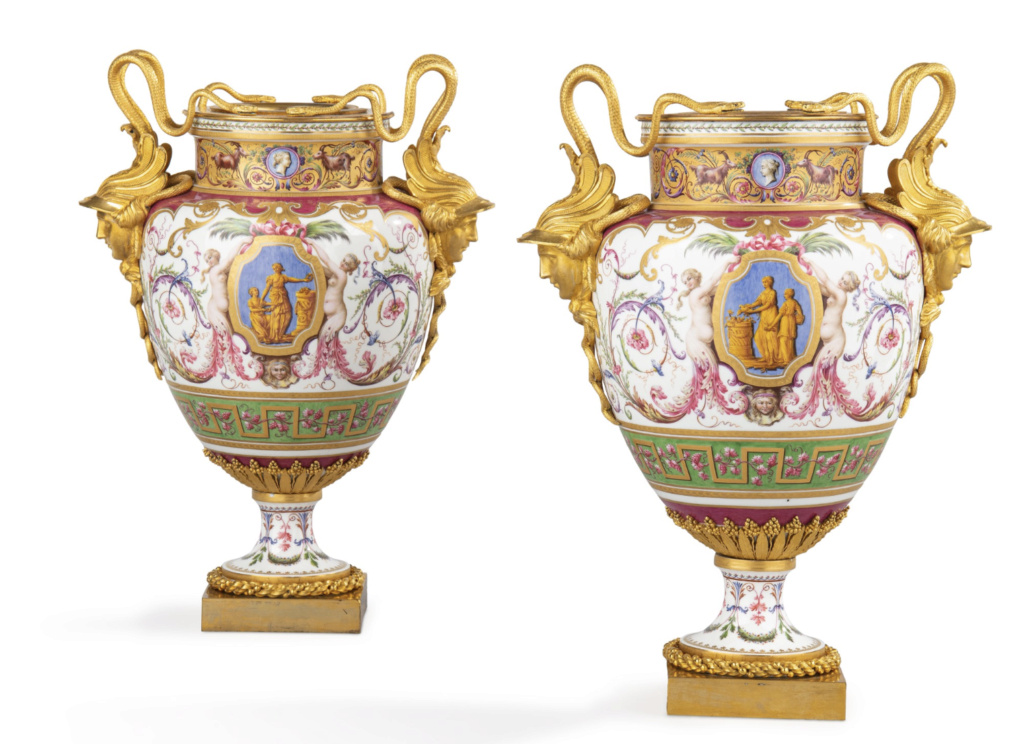
Provenance :
Sold in 1786 to the Comte de Vergennes (1719-1787), Foreign Minister of King Louis XVI, for the use of the Ministère des Affaires étrangères du roi Louis XVI, responsible for diplomatic gifts made by the King to other courts;
Sent to the Comte de Montmorin (1745-1792), French Ambassador to the Spanish Court, to be presented to Charles III's daughter-in-law, the Princess of Asturias, wife of the future Charles IV of Spain (...)
Catalogue Note
This exceptional pair of vases arabesques with gilt-bronze mounts were clearly intended as a highly prestigious commission. They bear the letter mark of 1786 and Pierre André Leguay’s gold mark. Leguay was working after JeanJacques Lagrenée’s drawings. The richness and the extreme quality of their painted decoration and bronzes attributed to Thomire facilitates their identification among the highest value items in the sales register of the Sèvres factory.
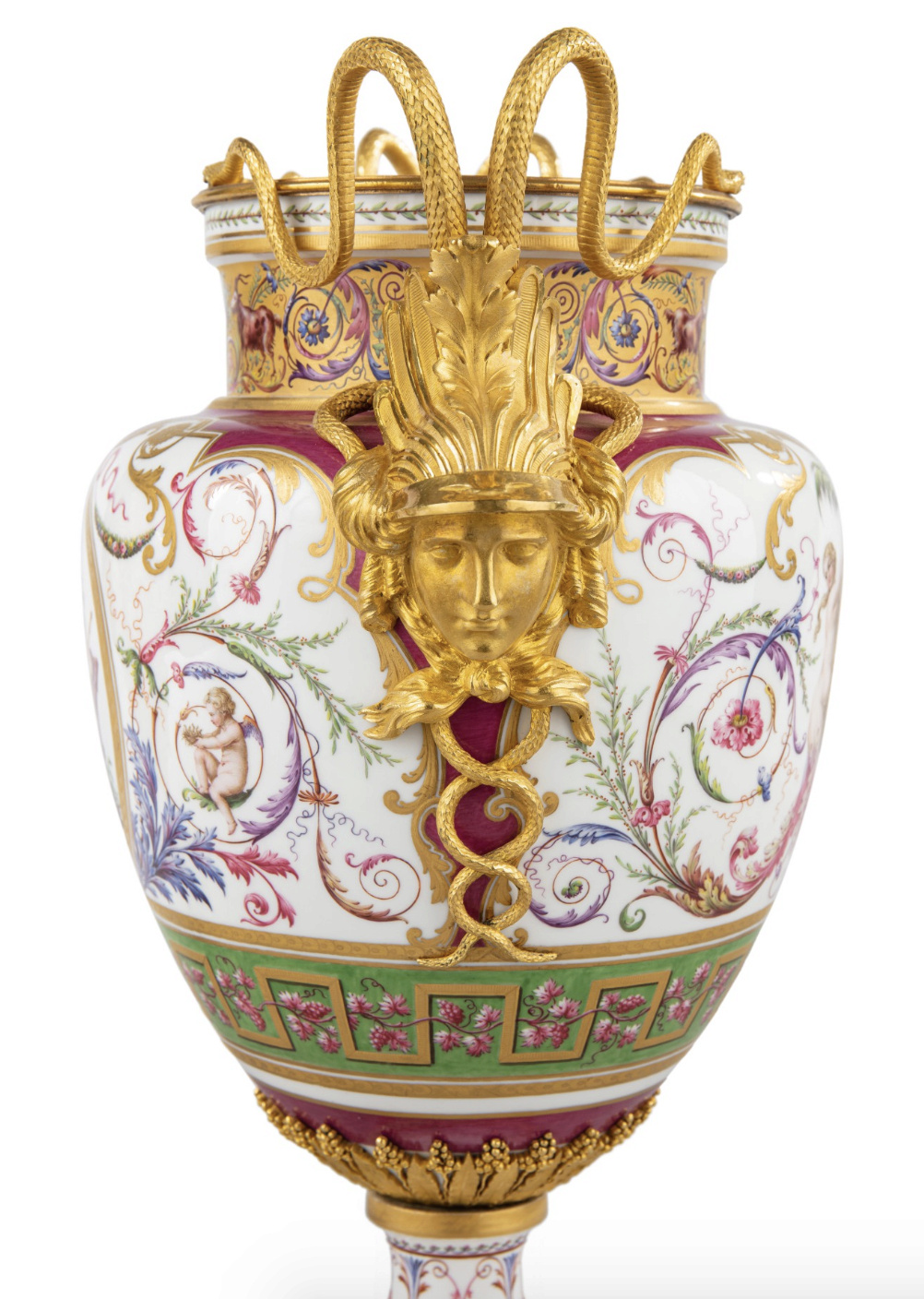
Among the most expensive vases sold by la manufacture de Sèvres in 1786, we find:
- Two vases arabesques with ormolu mounts sold for 1200 livres each to Louis XVI who gave them to his brother-in-law the Archduke Ferdinand of Austria, governor of Lombardy who was travelling in France with his wife Beatrice of Este under the pseudonym of the Earl and Countess of Nellembourg.
- Two vases sold for 1500 livres each to Louis XVI for his personal collection at the Royal exhibition of Versailles in December 1786.
- Two vases with bas-reliefs sold 1500 livres each to the Comte d’Artois, Louis XVI youngest brother.
- Two vases arabesques sold 1500 livres each to the Comte de Vergennes, Foreign Minister of King Louis XVI. The payments register of Sèvres shows that Leguay received an extraordinary payment of 720 livres in November 1786 for two vases arabesques. Such a sum is unusually high and could only be related to an exceptional commission. For example, Sinsson another well-known painter of la manufacture de Sèvres, was paid 240 livres in 1787 for two ‘very rich vases arabesques’.
The present pieces are the vases which were sold in December 1786 to the comte de Vergennes, not for his personal use but for the Foreign Office which was responsible for the diplomatic gifts made by the King to the other courts.

Charles Gravier, comte de Vergennes
Antoine-François Callet
Huile sur toile, 1780
Commandé par le Ministère des Affaires étrangères, 1780 ; présenté au Salon de 1781, n°150.
Image : Château de Versailles, Dist. RMN / Christophe Fouin
The register of royal gifts for 1786, conserved in the records of the French Foreign Office, indicates that our vases were sent to the Comte de Montmorin, Louis XVI’s ambassador to the Spanish Court, in order to be given to Charles III’s daughter in law, Maria Luisa of Parma (1751-1819), Princess of Asturias, wife of the future Charles IV of Spain. She had become Princess of Asturias when she married the heir to the throne in 1765.
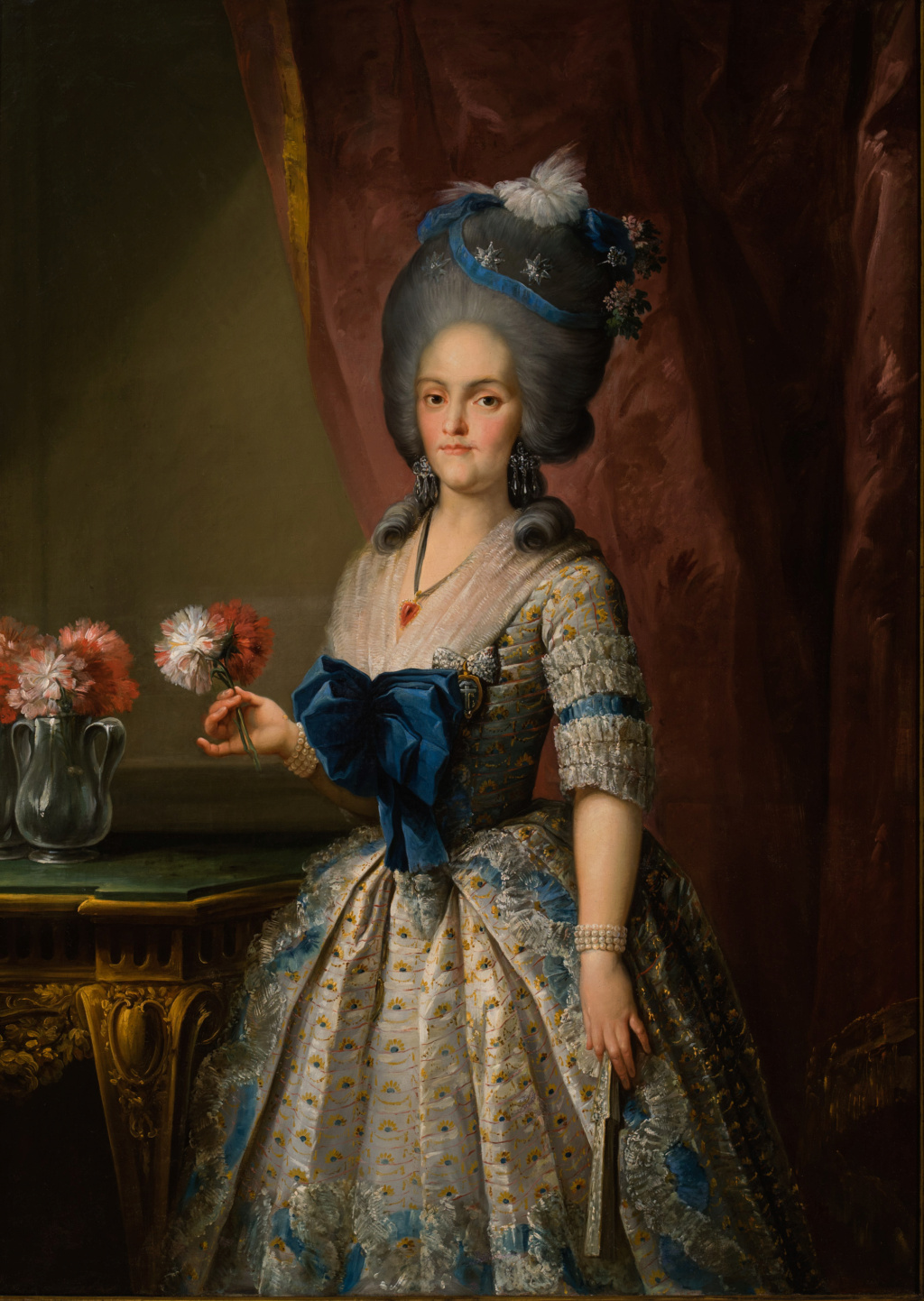
Retrato de María Luisa de Parma como princesa de Asturias
Mariano Salvator Maella
Óleo sobre lienzo, ca 1782
152,5 x 115 cm
Image : Real Academia de Bellas Artes de San Fernando. c/ Alcalá, 13. Madrid
Notre sujet : Les Bourbons d'Espagne et le royaume d'Etrurie
Such diplomatic gifts, considered private offerings rather than part of the Civil List, were often treated as personal property and thus free to be sold, which is why these vases were able to leave the Spanish Royal Collections at an unknown date.
Several other vases arabesques are presently recorded:
- A pair of vases Boizot dated 1782 in the British Royal Collections, illustrated in ‘Sèvres porcelain of Buckingham Palace and Windsor Castle’ no. 296a, pl. 62.
- Another pair is in the Boudoir room, circa 1782-1784, with handles in the form of a goat standing on a grotesque head. Like the current pair, these vases (vase de milieu de Duplessis fils) rank amongst the finest pieces of Sèvres porcelain produced by the manufactory in the Louis XVI style. The delicate polychrome arabesque painting and the finely chased giltbronze mounts are of exceptional quality.
- A pair of closely related gilt-bronze mounted Sèvres vases is in the Spanish Royal Collection, exhibited at the Palacio Real in Madrid.
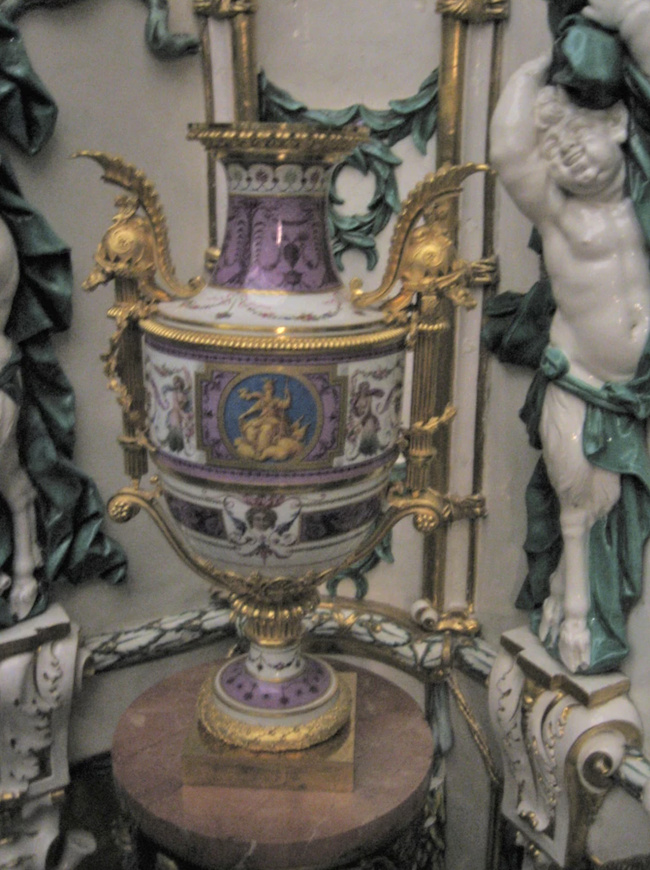
Vue d'une paire, Palais royal de Madrid
Image : Archives privées / Sotheby's
The superbly cast and chased gilt-bronze mounts demonstrate a highly ambitious project. Interestingly, the mounts of the vases in the Hodgkins collection were then attributed to Pierre Gouthière, the outstanding Parisian ciseleur-doreur. However, recent research by Pierre Verlet, reveals that many of Gouthière’s mounts were in fact made by the hand of his apprentice, Pierre-Philippe Thomire (1751- 1843), who is most likely bronzier for the mounts on the offered vases. After training with Pierre Gouthiere, the latter quickly established a reputation for finely chased gilt-bronze and was responsible for designing and fitting giltbronze mounts at the Sèvres factory from 1783.

This pair of vases appears to be one of the factory’s most successful realisations in the neoclassical taste of the 1780s and ‘illustre le haut degré de raffinement et de technicité atteint par la Manufacture de Sèvres à la fin du 18e siècle et la conjonction des meilleurs talents du temps pour répondre à l’évolution du goût’ (Virginie Desrante, ‘Le service de MarieAntoinette pour la laiterie de Rambouillet’, Sèvres Cité de la Céramique, Février 2011).
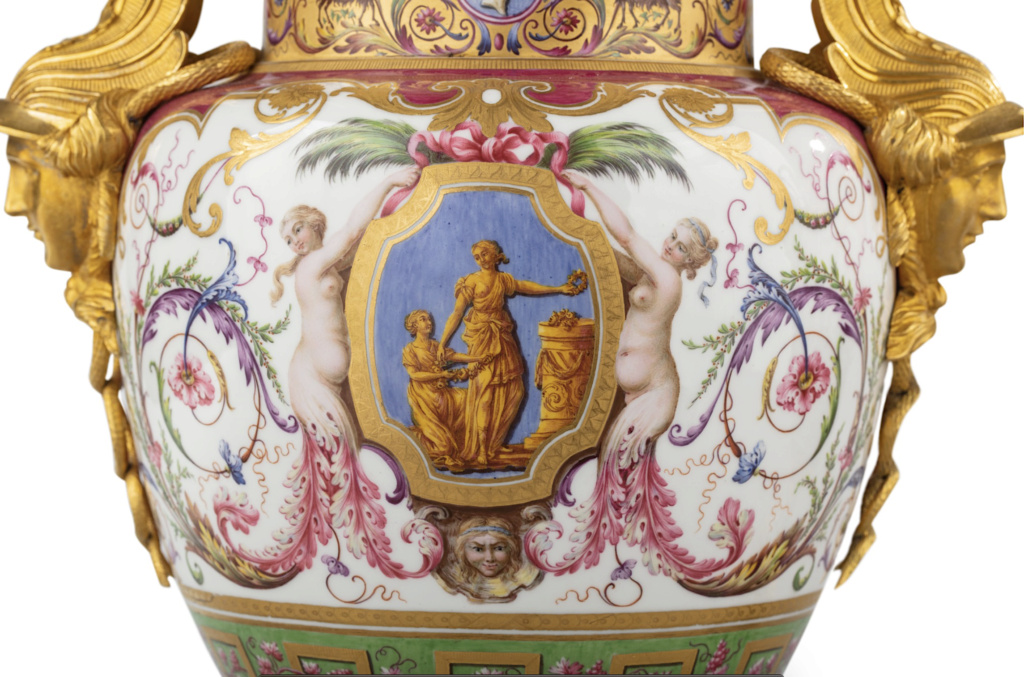
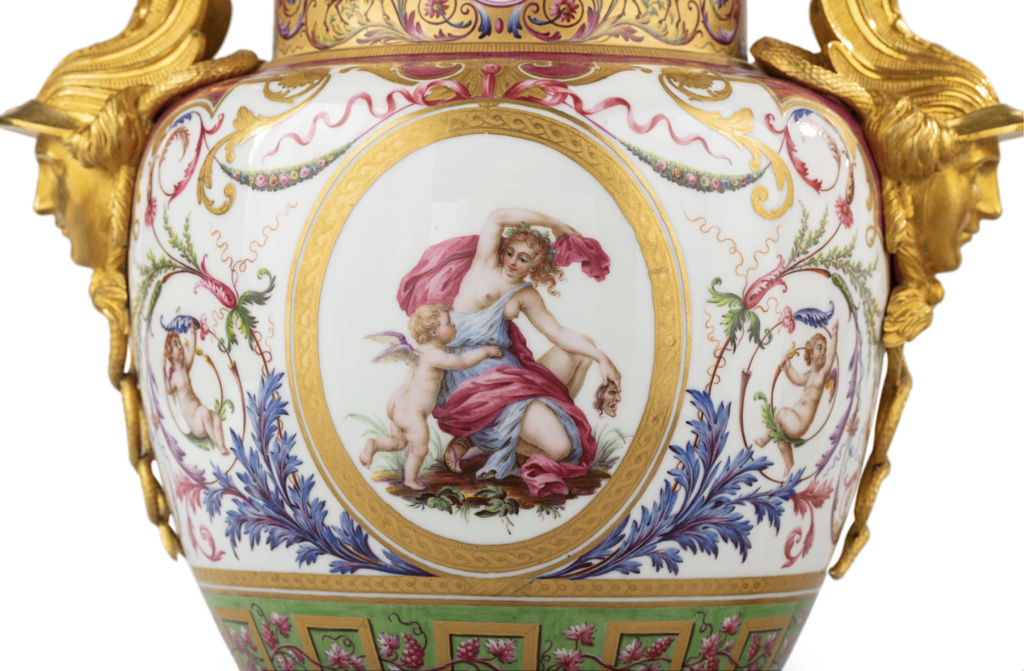
* Source et infos complémentaires : Sotheby's Paris - Hôtel Lambert, une collection princière
A suivre d'autres vases aux décors de " style arabesque "...
A diplomatic gift from King Louis XVI to the Princess of Asturias, the future Queen of Spain
A pair of gilt-bronze mounted hard paste Sèvres porcelain 'arabesques' vases,
the porcelain by Pierre-André Leguay after designs by Jean-Jacques Lagrenée,
the mounts Louis XVI attributed to Pierre-Philippe Thomire
Circa 1785-1786
Decorated with arabesques, the central panel of each vase decorated with a medallion with a polychrome mythological subject in a gilded border, Cupid and Comedy on the first and Threatened Cupid on the other, surrounded by rich scrolling foliage and arabesques with cupids, the backs decorated monochrome antique figures on a blue background representing Vestals at the altar of Love, surrounded by sirens with scrolling foliate tails terminating in elegant arabesques, the collar decorated with a wide green band with a Greek border intertwined with vines
Height 14½in.; width 10½in.; 37 cm; 27 cm.


Provenance :
Sold in 1786 to the Comte de Vergennes (1719-1787), Foreign Minister of King Louis XVI, for the use of the Ministère des Affaires étrangères du roi Louis XVI, responsible for diplomatic gifts made by the King to other courts;
Sent to the Comte de Montmorin (1745-1792), French Ambassador to the Spanish Court, to be presented to Charles III's daughter-in-law, the Princess of Asturias, wife of the future Charles IV of Spain (...)
Catalogue Note
This exceptional pair of vases arabesques with gilt-bronze mounts were clearly intended as a highly prestigious commission. They bear the letter mark of 1786 and Pierre André Leguay’s gold mark. Leguay was working after JeanJacques Lagrenée’s drawings. The richness and the extreme quality of their painted decoration and bronzes attributed to Thomire facilitates their identification among the highest value items in the sales register of the Sèvres factory.

Among the most expensive vases sold by la manufacture de Sèvres in 1786, we find:
- Two vases arabesques with ormolu mounts sold for 1200 livres each to Louis XVI who gave them to his brother-in-law the Archduke Ferdinand of Austria, governor of Lombardy who was travelling in France with his wife Beatrice of Este under the pseudonym of the Earl and Countess of Nellembourg.
- Two vases sold for 1500 livres each to Louis XVI for his personal collection at the Royal exhibition of Versailles in December 1786.
- Two vases with bas-reliefs sold 1500 livres each to the Comte d’Artois, Louis XVI youngest brother.
- Two vases arabesques sold 1500 livres each to the Comte de Vergennes, Foreign Minister of King Louis XVI. The payments register of Sèvres shows that Leguay received an extraordinary payment of 720 livres in November 1786 for two vases arabesques. Such a sum is unusually high and could only be related to an exceptional commission. For example, Sinsson another well-known painter of la manufacture de Sèvres, was paid 240 livres in 1787 for two ‘very rich vases arabesques’.
The present pieces are the vases which were sold in December 1786 to the comte de Vergennes, not for his personal use but for the Foreign Office which was responsible for the diplomatic gifts made by the King to the other courts.

Charles Gravier, comte de Vergennes
Antoine-François Callet
Huile sur toile, 1780
Commandé par le Ministère des Affaires étrangères, 1780 ; présenté au Salon de 1781, n°150.
Image : Château de Versailles, Dist. RMN / Christophe Fouin
The register of royal gifts for 1786, conserved in the records of the French Foreign Office, indicates that our vases were sent to the Comte de Montmorin, Louis XVI’s ambassador to the Spanish Court, in order to be given to Charles III’s daughter in law, Maria Luisa of Parma (1751-1819), Princess of Asturias, wife of the future Charles IV of Spain. She had become Princess of Asturias when she married the heir to the throne in 1765.

Retrato de María Luisa de Parma como princesa de Asturias
Mariano Salvator Maella
Óleo sobre lienzo, ca 1782
152,5 x 115 cm
Image : Real Academia de Bellas Artes de San Fernando. c/ Alcalá, 13. Madrid
Notre sujet : Les Bourbons d'Espagne et le royaume d'Etrurie
Such diplomatic gifts, considered private offerings rather than part of the Civil List, were often treated as personal property and thus free to be sold, which is why these vases were able to leave the Spanish Royal Collections at an unknown date.

Several other vases arabesques are presently recorded:
- A pair of vases Boizot dated 1782 in the British Royal Collections, illustrated in ‘Sèvres porcelain of Buckingham Palace and Windsor Castle’ no. 296a, pl. 62.
- Another pair is in the Boudoir room, circa 1782-1784, with handles in the form of a goat standing on a grotesque head. Like the current pair, these vases (vase de milieu de Duplessis fils) rank amongst the finest pieces of Sèvres porcelain produced by the manufactory in the Louis XVI style. The delicate polychrome arabesque painting and the finely chased giltbronze mounts are of exceptional quality.
- A pair of closely related gilt-bronze mounted Sèvres vases is in the Spanish Royal Collection, exhibited at the Palacio Real in Madrid.

Vue d'une paire, Palais royal de Madrid
Image : Archives privées / Sotheby's
The superbly cast and chased gilt-bronze mounts demonstrate a highly ambitious project. Interestingly, the mounts of the vases in the Hodgkins collection were then attributed to Pierre Gouthière, the outstanding Parisian ciseleur-doreur. However, recent research by Pierre Verlet, reveals that many of Gouthière’s mounts were in fact made by the hand of his apprentice, Pierre-Philippe Thomire (1751- 1843), who is most likely bronzier for the mounts on the offered vases. After training with Pierre Gouthiere, the latter quickly established a reputation for finely chased gilt-bronze and was responsible for designing and fitting giltbronze mounts at the Sèvres factory from 1783.

This pair of vases appears to be one of the factory’s most successful realisations in the neoclassical taste of the 1780s and ‘illustre le haut degré de raffinement et de technicité atteint par la Manufacture de Sèvres à la fin du 18e siècle et la conjonction des meilleurs talents du temps pour répondre à l’évolution du goût’ (Virginie Desrante, ‘Le service de MarieAntoinette pour la laiterie de Rambouillet’, Sèvres Cité de la Céramique, Février 2011).


* Source et infos complémentaires : Sotheby's Paris - Hôtel Lambert, une collection princière
A suivre d'autres vases aux décors de " style arabesque "...


La nuit, la neige- Messages : 18132
Date d'inscription : 21/12/2013
 Re: Les porcelaines de Sèvres du roi Louis XVI (services et divers)
Re: Les porcelaines de Sèvres du roi Louis XVI (services et divers)
Description Sotheby's a écrit:
Several other vases arabesques are presently recorded:
- A pair of closely related gilt-bronze mounted Sèvres vases is in the Spanish Royal Collection, exhibited at the Palacio Real in Madrid.
- A pair of vases Boizot dated 1782 in the British Royal Collections, illustrated in ‘Sèvres porcelain of Buckingham Palace and Windsor Castle’ no. 296a, pl. 62.
- Another pair is in the Boudoir room, circa 1782-1784, with handles in the form of a goat standing on a grotesque head. Like the current pair, these vases (vase de milieu de Duplessis fils) rank amongst the finest pieces of Sèvres porcelain produced by the manufactory in the Louis XVI style. The delicate polychrome arabesque painting and the finely chased giltbronze mounts are of exceptional quality.
revenons chez les anglo-saxons qui eux, musées ou maisons de vente, sont capables de proposer aux internautes des photos de bonne résolution et de rédiger des notes explicatives en ligne de plus de trois mots !!

A pair of gilt-bronze-mounted Sèvres soft-paste porcelain `Vases Medici'
almost certainly supplied by the marchand-mercier Dominique Daguerre
the mounts attributed to Pierre-Philippe Thomire (1751-1843)
Louis XVI, circa 1788-1790
Vases without the mounts each 37.2cm high, with mounts 42.8cm high; 1ft. 2½in., 1ft. 5in.
superbly painted on a pale blue ground with 'rich arabesques' including, on the upper part, draped tables supporting steaming brûle-parfums alternating with others hanging from draped baldaquins, the lower part with urns filled with flowers and overflowing with water, held within a delicate and elaborate décor of foliage, grapevine and feather arabesques, on a grey-marbleised square base, the mounts with an egg and dart rimmed bowl and twin scrolled handles cast with fruiting vine tracery; the vases cracked, the ormolu with some repair and losses
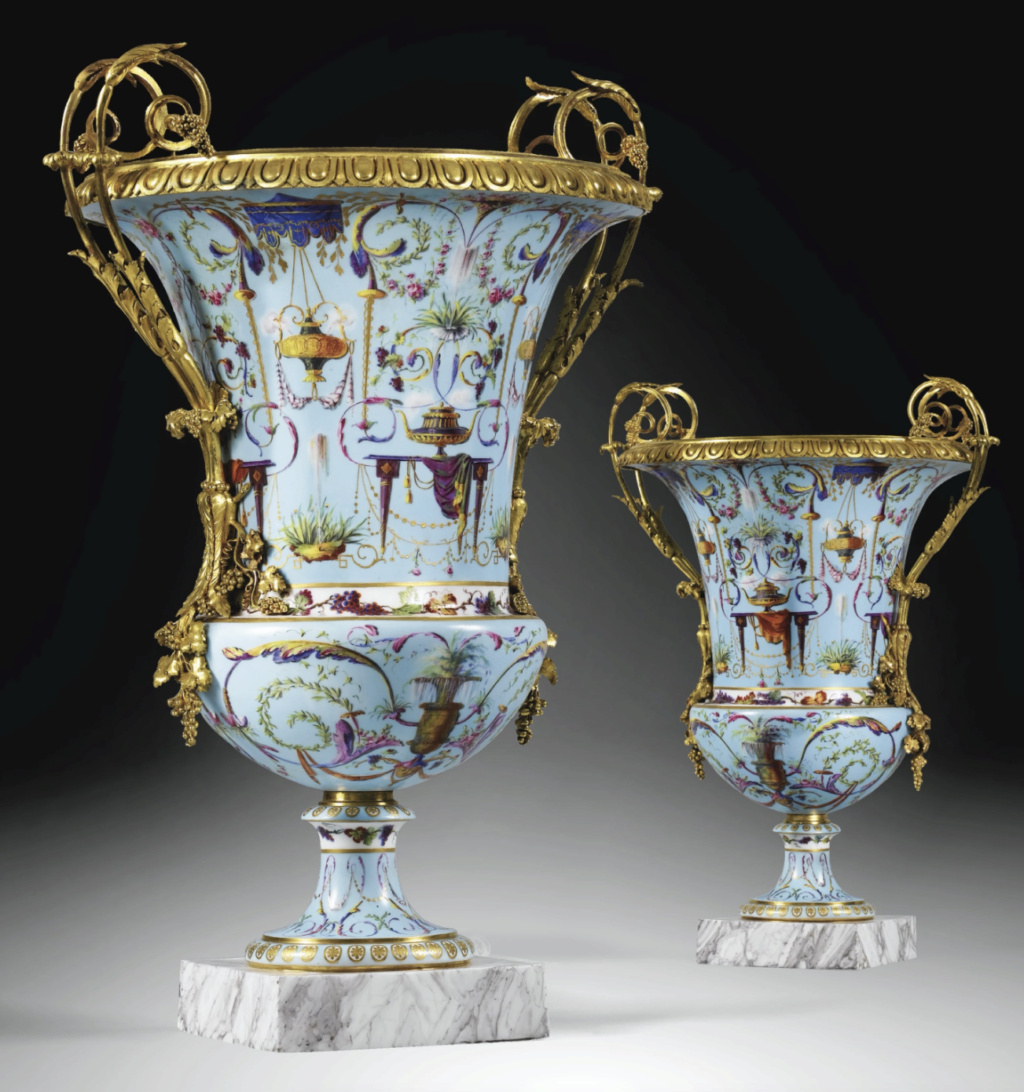
Catalogue Note
This magnificent pair of vases are exceptional in both their form and their decoration, although it has proved challenging to identify them in the Kiln records or Artist's records of the Royal Manufacture of Sèvres. The rarity of their ground colour makes it hard to know what phrase might have been used to describe them, and though they evidently date from the Neo-classical period at the very end of the reign of Louis XVI, the lack of a date code or painter's marks further complicates matters.
First used by the factory circa 1755 (1) and then falling out of favour for a couple of decades, the revised Medici vase form had been reintroduced by 1781, by Louis-Simon Boizot who designed it possibly for the birth of the Dauphin and called it "vase jardin à dauphins", now in the Musée du Louvre (2). The model was then developed in three different sizes in the following years. A plaster model for the vases is still at the factory, inscribed in pencil "Vase Medicis / 3me grandeur/1802" -the date probably having been added during the first inventory of the museum made by Alexandre Brongniart.
Copied directly from Antique models taken from the Louvre museum, this renewed form was part of a larger programme of revolutionary change in style at the Sèvres factory, led by its director the comte d'Angiviller. The latter believed that good taste and true beauty resided in the art of antiquity, and he was keen on introducing to France the 'style étrusque', an archaeological Neo-classical style based on actual objects that were being excavated in southern Italy in the second half of the 18th century and were – incorrectly believed to have been made by the Etruscans (3).

Charles Claude de Flahaut (1730–1809), comte d'Angiviller
Jean-Baptiste Greuze
Oil on canvas, 1763
Image : The Metropolitan Museum of Art
Louis XVI offered a wonderful opportunity to the comte to develop this new neo-classical taste.
In 1783, the king bought the property of Rambouillet, where he wanted to build an idealised dairy for Marie-Antoinette and her court to disport themselves as Arcadian milkmaids and rustics, in the latest fashion, as the Queen had already begun doing in the Hameau de La Reine.
D'Angiviller employed the finest artists and craftsmen for the Rambouillet project, coordinated by the painter Hubert Robert, and especially the painter Jean-Jacques Lagrenée as co-artistic director of the manufactory, to produce a service with new designs for both decoration and forms. The sky blue ground on the present pair of vases is one of these new pastel colours (others included lilac, grey, green and yellow) specifically created for the service and seems likely to be the colour referred to in the archives as fond petit bleu. See for example, the famous bowl in the shape of a woman's breast now in the Musée de Sevres and other sketch.
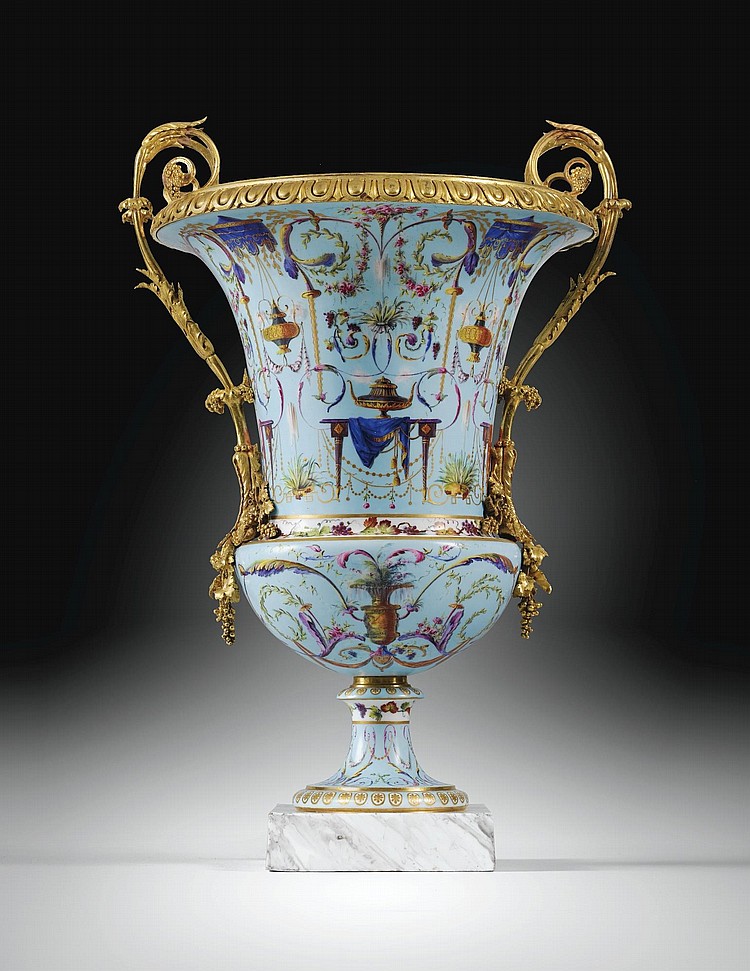
The profusion of elaborate ornaments on the present pair of vases, however, more closely echoes another very ambitious project of the period, the service arabesque (voir introduction de ce sujet).
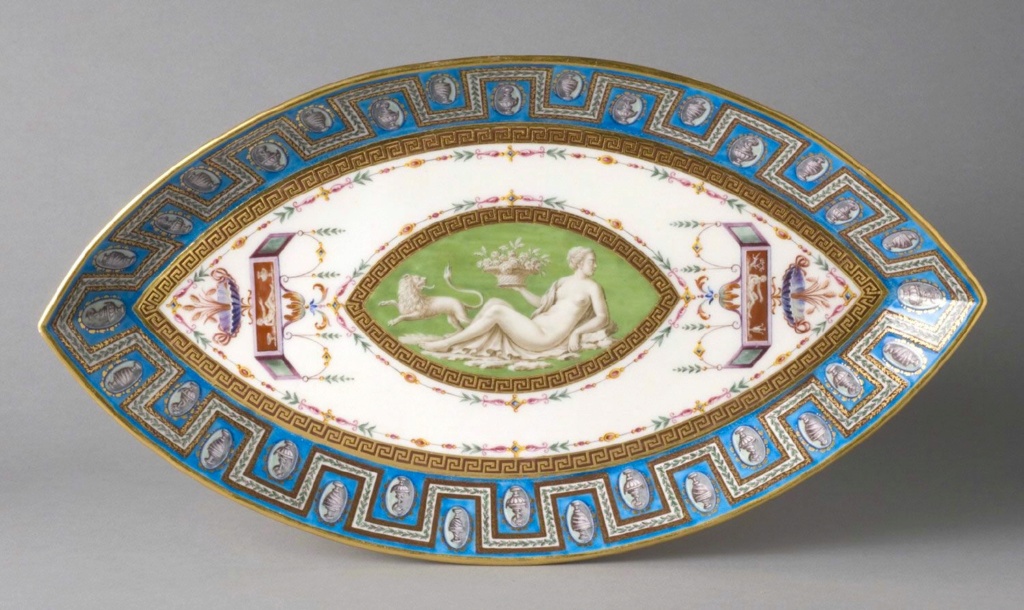
Dish from the "Arabesque" Service
Made by Sèvres porcelain factory
Decoration designed by Louis Le Masson, (French, 1743–1829)
Painted by Pierre-Antoine Méreaud, (French, active 1754–1791)
Image : Philadelphia Museum of Art
Produced from 1783 to 1787, this exceptional commission was composed of unique forms individually decorated with arabesques after Raphael. The engineer and architect Louis Le Masson was employed to design classical forms and intricate decorative motifs inspired by Roman and Pompeian models, and watercolour sketches were produced for the individual items of the service, each probably having its own decorative pattern. In 1795, the Comité de Salut Public had admired this service for its superb quality, and chose it as the perfect diplomatic gift to a minister, von Hardenberg, of Friedrich Wilhelm II, the King of Prussia (4).
The Arabesque service was sadly to remain in the Sèvres factory's reserves. Furthermore, the Neoclassical fashion was by now as its peak and the sketches were used for other projects at the Sèvres factory, between 1786 and 1792. See for example a pair of hard-paste porcelain 'vases en cornet', circa 1786, sold Sotheby's Paris, 18 October 2006, lot 80.
A "service petit bleu arabesque" was produced between 1789 and 1791 and painted (after Lagrenée's sketches) by various artists of the factory, including Guillaume Buteux and Theodore Buteux (5). The decoration of that service is however considerably less ambitious than that on the present lot, and only the border of the plates bears a pattern of arabesques en camaieu on a petit bleu background.
As to the likely painters of our vases, one candidate may be Pierre-André Le Guay, called Le Jeune, who was directly involved in the Service Arabesques, and who painted in 1788, a pair of porcelain vases also with a pastel ground, the fond petit verd, and very similar arabesque decoration, but with a central hunting scene en camaieu (now in Versailles).
This pair was then bought by Louis XVI himself, during the Factory exhibition in 1789.
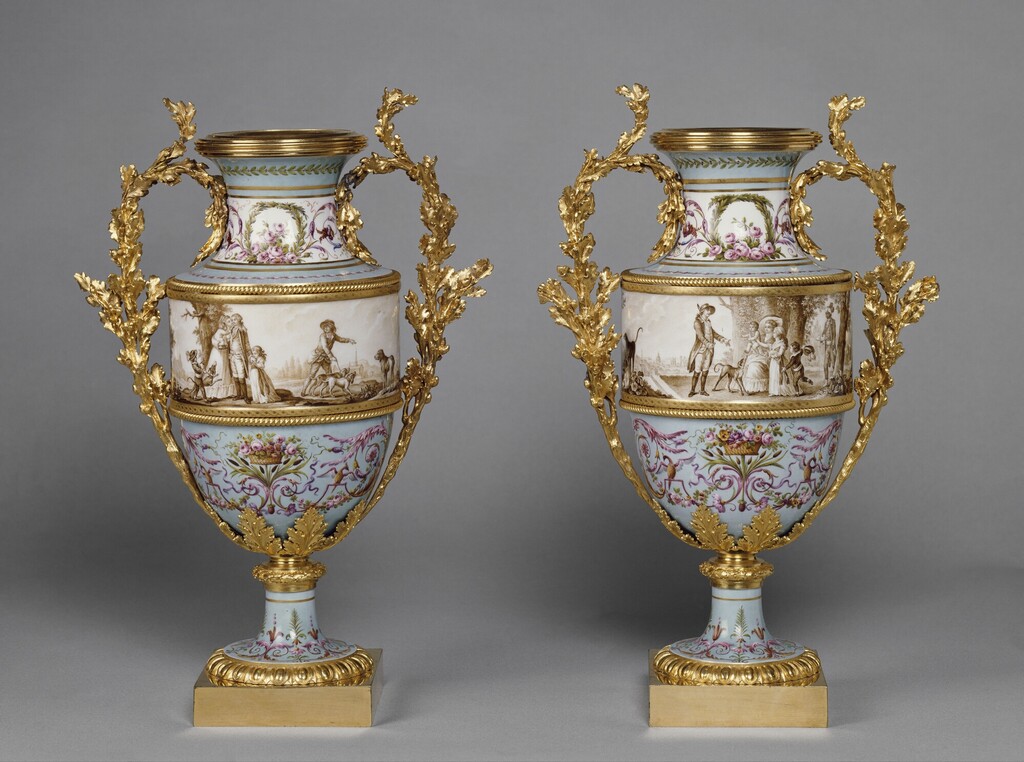
Vases " Le départ à la chasse "
Paire acquise par Louis XVI en 1789 ; la paire déposée au Louvre en juillet 1793 et destinée au Muséum
Manufacture de Sèvres (fabricant)
Porcelaine dure, bronze ciselé et doré, 1787-1789
Le Guay, Pierre-André (peintre sur porcelaine), d'après Lamprecht, Georges (peintre)
Montures attribuées à Thomire, Pierre-Philippe (bronzier)
Image : RMN-GP (Château de Versailles) / Gérard Blot
In 1788, Le Guay Le Jeune also painted a pair of vases Medicis with similar but smaller arabesque friezes and essentially the same shape and gilt mounts, illustrated in 1909 when part of the Hodgkins collection (6).
A third pair of vases echoed this neoclassical taste and décor, now in the Cité de La Ceramique, Sèvres Museum (7).


Paire de vases d'ornement de forme balustre
Manufacture de Sèvres, vers 1780-90
Prévost Henri-Martin, l'Aîné (1757-1797), doreur sur porcelaine
Thomire Pierre-Philippe (1751-1843) (attribué à), bronzier
Image : RMN-Grand Palais (Sèvres - Manufacture et musée nationaux) / Martine Beck-Coppola
These bear only the gilder's mark of Henri Prevost but their shape and ornament is in close relation to these others, in the same period. Le Guay Le Jeune was most celebrated for his figure painting and it may be that several artists were involved both in these pieces, and in our own pair.
Another candidate must be considered: Nicolas Sinsson, celebrated for the general excellence of his painting. Certainly, the motifs of the arabesques, particularly the scalloped drapes and the draped table supporting a vase, are echoed on a hard paste punch bowl, dated 1790, in the Royal collection. 8
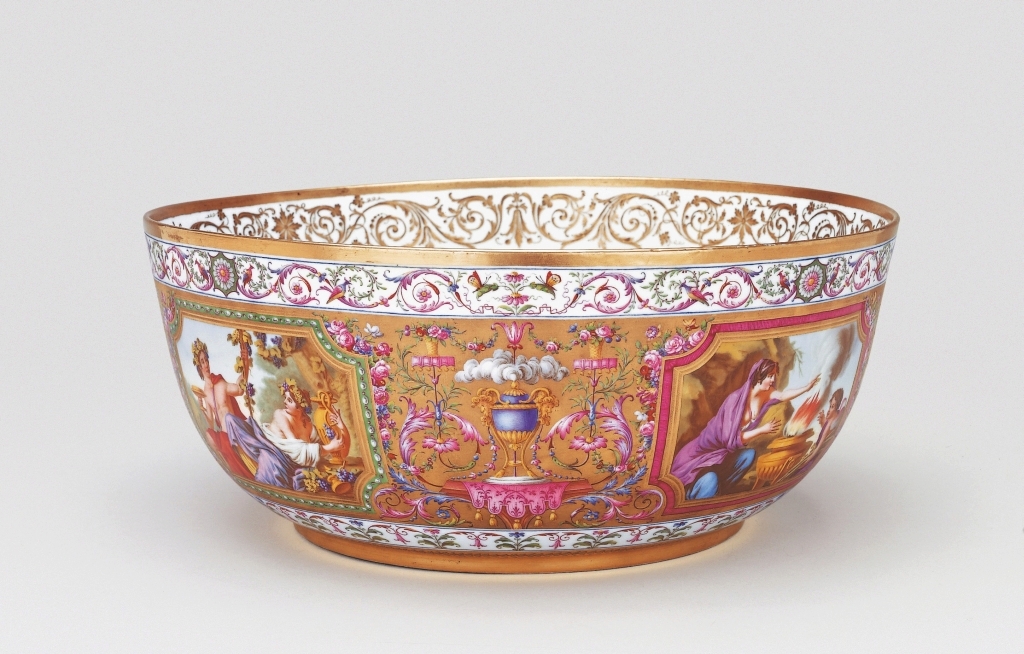

Jatte à punch
Hard paste porcelain and gilded decoration
Sèvres porcelain factory (porcelain manufacturer)
Nicolas Sinnesson (active 1773-95) (porcelain painter)
André-Joseph Foinet La France (active 1773-1825) (porcelain painter)
France, 1790
14.5 x 33.5 x 33.5 cm
Images : The Royal Collection Trust
Provenance :
The total value of the consignment, which was destined for Maria Luisa of Parma, Queen of Spain, the wife of Charles IV, amounted to 10,800 livres . The circumstances which appear to have prompted this gift from Louis XVI was the birth of a daughter, Maria-Theresa, to the Queen on 16 February 1791.
(...)
Then after, George IV, King of the United Kingdom (1762-1830)
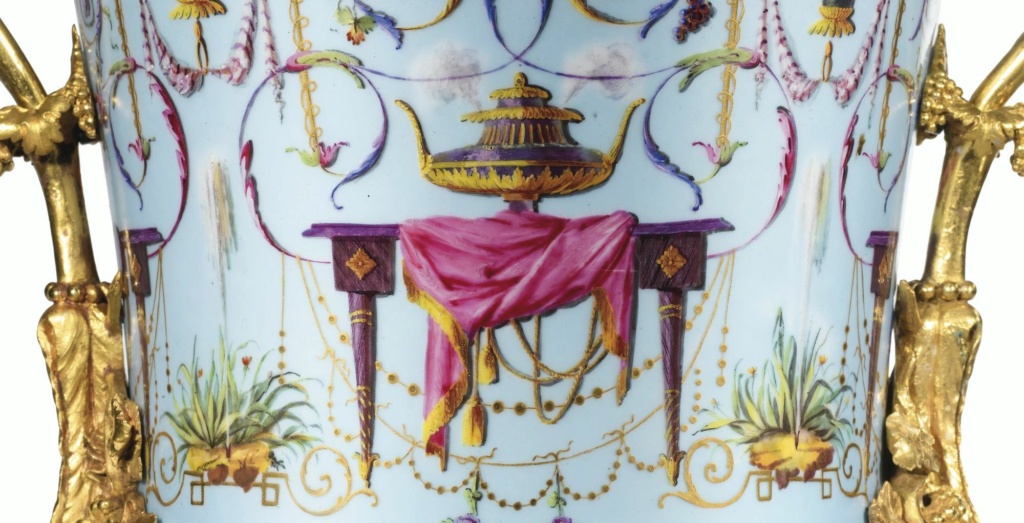
The painter came to specialize in friezes and arabesques and was one of those who worked on the Service Arabesque. He also, for example, completed in the 1790's vases by P-A Le Guay to which he added the arabesques. Moreover, he is known to have decorated pieces with the pastel ground colours, including petit verd and petit bleu.(9)
Two entries in the Sèvres decorator's records, for example, read: "24 May 1788, 2 vases en deux pieces chacun, Riches arabesques" and "27 July 1788, 2 vases en deux pieces chacun, riche arabesques". Could the present vases perhaps represent the most ambitious work of Nicolas Sinsson? (10).
The superbly cast and chased gilt-bronze mounts demonstrate a most ambitious project. Interestingly, the mounts of the vases in the Hodgkins collection, previously mentioned, were then attributed to Pierre Gouthière, the outstanding Parisian ciseleur-doreur. However, recent research by Pierre Verlet, reveals that many of Gouthière's mounts were in fact made by the hand of his apprentice, Pierre-Philippe Thomire (1751-1843), who is most likely bronzier for the mounts on the offered vases. After training with Pierre Gouthiere, the latter quickly established a reputation for finely chased gilt-bronze and was responsible for designing and fitting gilt-bronze mounts at the Sèvres factory from 1783.
This pair of vases appears to be one of the most ambitious and most complete projects in the 1780's-90's neoclassical fashion, and "illustre le haut degré de raffinement et de technicite atteint par la Manufacture de Sèvres à la fin du 18th century et la conjonction des meilleurs talents du temps pour répondre à l'évolution du goût" (11).
Pierre-PhilippeThomire (1751-1843):
- Spoiler:
- Along with his master, Pierre Gouthière, Thomire was the most celebrated bronzier during the reign of Louis XVI. He was the son of a ciseleur but also received training under the sculptors A. Pajou (1730-1809) and J.-A. Houdon (1741-1828) and he cast bronze portrait busts for both. The former was also a pupil at the Académie de Saint-Luc. He was already working for the Royal family by 1775 and collaborated with Jean-Louis Prieur ciseleur et doreur du Roi, on the bronze mounts for the coronation coach of Louis XVI. He set up his own atelier the following year and in 1783, Thomire was appointed as the modeller to the Manufacture de Sèvres, succeeding Jean-Claude Duplessis. He cast and chased bronzes the following year, which were designed by the sculptor, L.-S Boizot, for a monumental vase in dark blue porcelain intended for the Musée Centrale des Arts, which is now in the Louvre (cat. no. 407). He was still working for Sèvres during the Napoleonic period.
In the accounts of the Garde-Meuble de la Couronne, his name appears frequently from 1784 as a maker of furniture mounts. He also collaborated in particular with Beneman on some pieces made for the Crown, aswell as Boulard and others, on a large screen made for Louis XVI's bedchamber at Compiègne in 1786 (now in the Louvre). He was also well known for bronzes d'ameublement such as the two sets of chenets for Marie-Antoinette's apartments at Versailles in 1786 (now in the Louvre cat.nos. 369 and 370) and the set of wall lights for Compiègne in 1787 (four are now in the Wallace Collection, London, Cat. Nos. 366-369 and two at Waddesdon Manor).
Additionally he made chimney mounts for Thierry de Ville d'Avray, the contrôleur-général des Meubles de la Couronne. He also undertook other commissions for example, he executed for the City of Paris in 1785, a set of monumental candelabra for presentation to General Lafayette to celebrate the Declaration of Independence. His other patrons included the Comte d'Artois, for furnishings for the château de Bagatelle.
During the Revolution, his atelier was used for the production of arms, but in 1804 he reverted to his former profession when he acquired the premises and business of the marchand-mercier Éloy Lignereux, the former partner and successor to Dominique Daguerre. His business flourished during the Empire period, and was renamed Thomire, Dutherme et Cie and in 1807, he is recorded as employing at least seven hundred workers. He enjoyed prestigious commissions from both the City of Paris and the Emperor including an important toilet service for presentation to Empress Marie-Louise on the occasion of her marriage and also the celebrated cradle for the King of Rome. He retired from business in 1823, and was awarded the Légion d'Honneur in 1834 and died in his 92nd year.
His style is more purely neo-classical than Gouthière's and he utilised motifs such as Victories, sphinxes and neo-classical incense burners quite early in his career. When he made mounts for the monumental Sèvres vase in 1783, he was already using the anthemion motif. During the Louis XVI period, he appears to have sometimes cast the works himself but at other times used fondeurs such as Forestier who also worked after models he provided. He is also recorded as gilding his own bronzes and sometimes employing others to do so, such as the fondeur-ciseleur Chaudron.
His work pre-revolution is to be found in all the major collections including the Louvre, Versailles, Fontainebleau, Compiègne, the Pitti Palace, Florence, the Wallace collection and Waddesdon Manor.
The marchands-merciers and Dominique Daguerre:
- Spoiler:
- The marchands-merciers were great innovators and entrepreneurs in 18th century Paris. They played an important role in instigating fashion trends during the latter part of the reign of Louis XV and in particular during the reign of Louis XVI. Their success depended in no small part upon their ability to harness many different trades resulting in innovative and superlatively executed pieces of furniture and luxury objects that satisfied the insatiable appetite of collectors.
Those at the forefront of establishing taste included Darnault, Hébert, Duvaux, Poirier, and his successor Daguerre and led the way in setting the trends in interior decoration and furnishings in the second half of the 18th century. They invented new techniques and instigated new designs. It was they who created a market in objets de luxe, by mounting oriental and French porcelain to fit effortlessly into French interiors and also mounting French Sèvres porcelain on furniture by some of the leading ébénistes of the day.
They worked not only for their most important clientèle, the French Court, but also private clients. Lazare Duvaux's main client was Madame de Pompadour. The success of Poirier was almost solely down to Madame du Barry and his successor Dominique Daguerre became the chief supplier to the Court of Louis XVI. As early as 1760, Poirier had established a virtual monopoly in buying plaques of soft-paste porcelain from the Manufacture Royale de Sèvres. This monopoly resulted in a large production of Sèvres-mounted pieces of furniture. Poirier and Daguerre were instrumental in supervising the employment of porcelain plaques on pieces of furniture from the leading 18th century Parisian ébénistes such as Adam Weisweiler, Martin Carlin, Roger Vandercruse and these pieces were often fitted with fine gilt-bronze mounts by Pierre Gouthière.
Dominique Daguerre was one of the most celebrated Parisian marchand-mercier who was in partnership from 1772 with Simon-Philippe Poirier. Daguerre took over Poirier's business at La Couronne d'Or in the Faubourg Saint-Honoré in 1777/78.
In 1778, Daguerre moved to London, and went into partnership with Martin-Eloi Lignereux, who remained in Paris. Daguerre's premises were in Sloane Street, Chelsea and he supplied furniture to George, Prince of Wales, around 1787-89 for the interiors at Carlton House, where his account in 1787 for furniture and furnishings totalled £14,565 13s 6d and at Brighton Pavilion. Surviving bills record that chimneypieces were imported from Paris, to be adjusted by craftsmen in London. At Carlton House, and Woburn Abbey, and for Earl Spencer at Althorp (1790), Daguerre worked in collaboration with the architect Henry Holland and sets of mahogany chairs by Georges Jacob, with openwork backs in lozenges and circles, are in the Royal Collection and in the Library at Woburn, where Holland was executing alterations; they are likely to have been supplied through Daguerre.
Notes
- Spoiler:
- 1 Vase dit Le Boiteux, Brunet et Preaud, Sèvres des origines a nos jours, Fribourg, 1978, fig. 70.
2 This vase was offered in 1997 to the Musée du Louvre, see Louis-Simon Boizot, 1743-1809, exhibition catalogue, Versailles, 2001, p. 261, fig. 3.
3 Selma Schwartz, "The 'Etruscan' style at Sèvres, A bowl from Marie-Antoinette's dairy at Rambouillet", The Metropolitan Museum Journal N. 37, 2002, pp. 259-266.
4 David Peters, op. cit., pp. 1085-1095.
5 Choisy, Drouet, Massy, Philippine Cadet, Taillandier,Viellard fils. David Peters, op. cit., pp. 1049-1051.
6 Chavagnac in his article in Les Arts describes the date letter as LL which was thought to be then 1789.
7 MCN, 25, 493, 1-2
8 G. de Bellaigue, op. cit., no. 176
9 R. Savill, op. cit.,p. 1066-1067.
10 Another entry however records that the painter Jean-Pierre Fumez on 23rd July 1788 painted "2 collet et pieds a deux vases de Sinsson, Arabesques".
11 Virginie Desrante, "Le service de Marie-Antoinette pour la laiterie de Rambouillet", Sevres Cite de la ceramique, Fevrier 2011
* Source : Sotheby's is very grateful to David Peters for his help in cataloguing this lot / Sotheby's

La nuit, la neige- Messages : 18132
Date d'inscription : 21/12/2013
 Re: Les porcelaines de Sèvres du roi Louis XVI (services et divers)
Re: Les porcelaines de Sèvres du roi Louis XVI (services et divers)
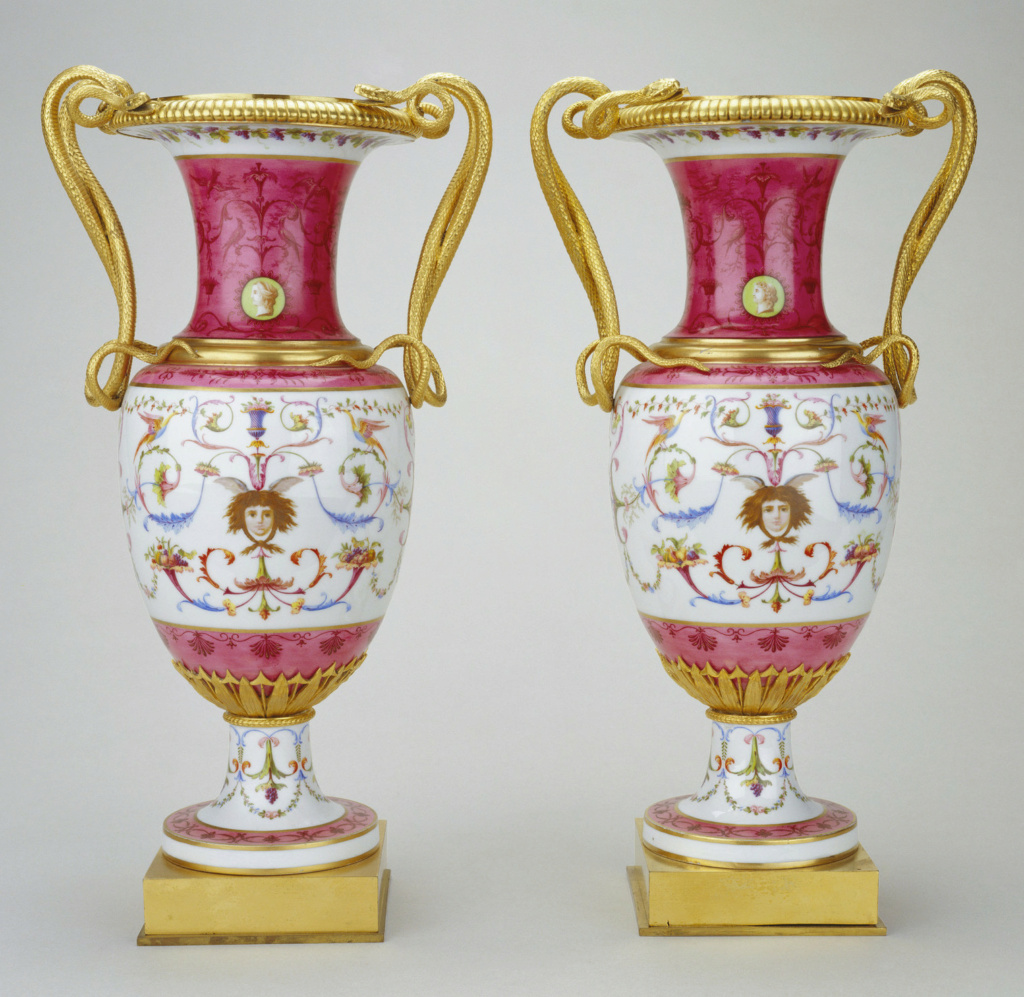
Vases Boizot
Soft-paste porcelain, pink/mauve ground, gilded decoration and gilt bronze
Sèvres porcelain factory (porcelain manufacturer)
France, 1787
Jean-Nicolas Le Bel le jeune père (active 1773-93) (artist) ; Étienne-Henry Bono (active 1754-81) (metalworker) ; H J Hatfield & Sons (metalworker) ; Pierre-Philippe Thomire (1751-1843) (bronze maker)
1 33.4 x 17.2 x 11.7, .2 33.8 x 17.5 x 12.1 cm
Image : The Royal Collection Trust
Provenance :
Acquired by George IV. Their purchase must pre-date 9 July 1803, if they have been correctly identified in a bill of this date submitted by Benjamin Vulliamy covering repairs: ‘For Unmounting a Pair of Arabesque China Vases regilding the bottom plinths and cleaning all the rest of the Gilding like new £2 2s’.
Description
This pair of vases is painted in registers with arabesques in a pinkish mauve colour on a ground of a lighter hue and with polychrome arabesques on a white ground. The gilt bronze mounts include double serpent handles, a gadrooned rim, a beaded leaf-and-dart cup and a plain square plinth. Loose gilt bronze cups forming linings fit in the mouth of each vase.
- Spoiler:
- The egg-shaped vase, which has a slender neck and trumpet-shaped mouth, rests in a gilt bronze leaf-and-dart cup above a separately moulded short splayed stem and circular foot. The arabesques, which incorporate foliage, birds, garlands and cornucopias of fruit and flowers, are accompanied by palmettes and stiff-leaf foliage. They are interrupted on the neck by two green roundels painted with classical heads in grisaille (two male on .1, one male and one female on .2). The polychrome arabesques on the body of the vase are centred at the front on a winged head of Mercury and at the back on an urn. On the underside of the lip of the vase is a white band painted in colours with a vine trail laden with grapes. The white stem is painted with swags of grapes and garlands. A gilded moulding runs round the vase above the shoulders.
The Raphaelesque character of the decoration, which includes heads of Mercury, cornucopias and stiff-leaf trails, could well have been inspired by engravings of Roman murals in, for example, the Palazzo Bernini and the Baths of Titus, which were engraved by Marco Carlone after drawings by Francesco Smugliewicz. Leaves from this series published by Ludovico Mirri in 1776 are still preserved in the Sèvres Archives.

The mounts can plausibly be attributed to Pierre-Philippe Thomire who, following Jean-Claude-Thomas Duplessis’ death on 24 August 1783, became the manufactory’s accredited supplier of bronzes. Included in a list of work undertaken by Thomire for Sèvres in 1785 is an entry dated 24 September for ‘une garniture de Vases à Petits Serpents Genre Chinois portant 11 pces de hauteur pour model, Cizelure, Monture, fonte, Dorure au matte Employ de L’or une once et façon 500 [reduced to 400] ’.
Pierre-Philippe Thomire
- Spoiler:
- Pierre-Philippe Thomire was the outstanding Parisian bronzeur and gilder of the early nineteenth century. He supplied finely chased mounts to leading Parisien ébénistes for furniture, clocks and the Sèvres porcelain factory. He was much patronised by Napoleon who made him Ciseleur de l'Empereur. His work represents some of the finest examples of Empire style.
In 1804 he acquired business of the marchand-mercier, Martin-Eloi Lignereux. The company employed a large workforce in a workshop at rue Boucherat and a showroom at rue Taitbout, from where Thomire retailed a large range of decorative objects inspired by antiquity including candelabra, extravagant centrepieces, clock cases and monumental Greek and Roman style urns and vases.
Thomire collaborated with three partners, renaming the business for a time Thomire, Duterme et Cie. The business suffered as a result of France's continuing European hostilities and to avoid bankruptcy the firm was granted dispensation to trade with the Prince Regent . Soon after 1815 the partnership with Duterme was dissolved and, under the old style, Thomire et Cie thrived once more under the restored Bourbons.
Thomire retired in 1823 and his two sons-in-law, Louis-Auguste-Cesar Carbonelle and André-Antoine Beauvisage, continued the business until 1852. Thomire continued to work as a sculptor and exhibited regularly at the Salon until 1834.
* Text adapted from French Porcelain for English Palaces, Sèvres from the Royal Collection, London, 2009
Source : The Royal Collection Trust
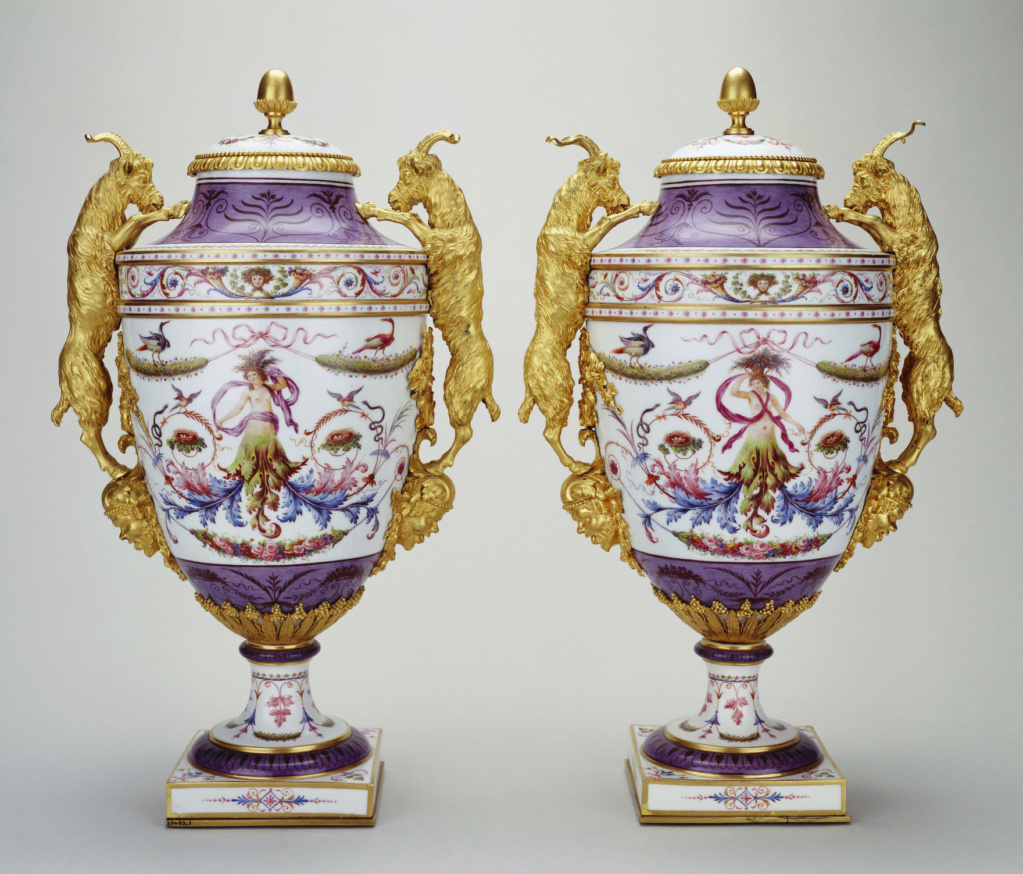
Vases de milieu de Duplessis fils ?
Hard paste porcelain, white ground with mauve decoration, gilded decoration and gilt bronze
Sèvres porcelain factory (porcelain manufacturer)
France, 1782
Attributed to Pierre-Philippe Thomire (1751-1843) (bronze maker) ; Robert Fogg (c. 1761-1823) (dealer)
1 42.1 x 25.6 x 17.8, .2 42.5 x 25.8 x 17.9 cm (whole object)
Image : The Royal Collection Trust
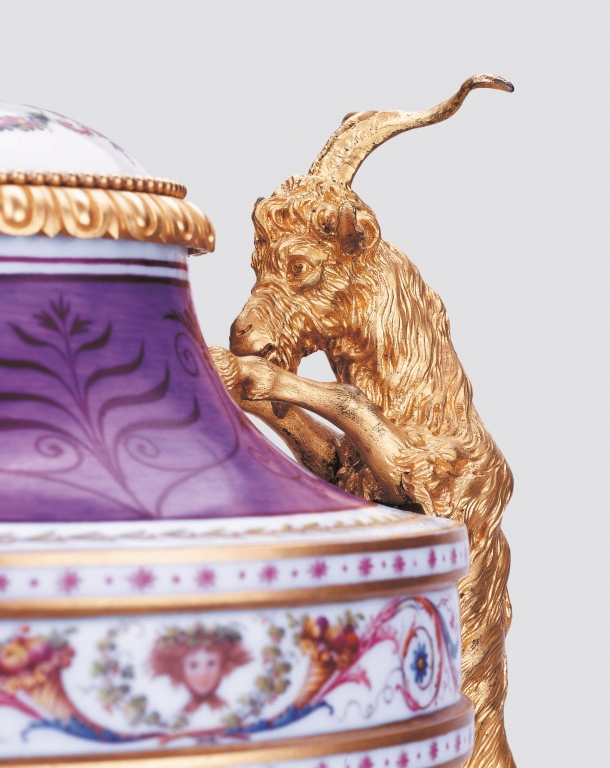
Image : The Royal Collection Trust
Voir aussi notre sujet : Les vases à " tête de bouc " et " têtes de bélier "
Provenance :
Sold by the Revolutionary government in 1797 and bought by George IV from Robert Fogg for £157 10s; the entry in his bill dated 28 September 1812 reads: ‘2 Sèvres Vases, Arabesque finely mounted’.
Description (extraits) :
The vases rank among the finest pieces of Sèvres porcelain produced by the manufactory in the Louis XVI style. The delicate polychrome arabesque painting and the finely chased gilt bronze mounts, which may have been supplied by Pierre-Philippe Thomire (1751-1833), are of exceptional quality.
The vases once belonged to Louis XVI and formed part of the furnishings of the Ancienne Pièce du Café on the first floor of the King’s private apartments at Versailles.
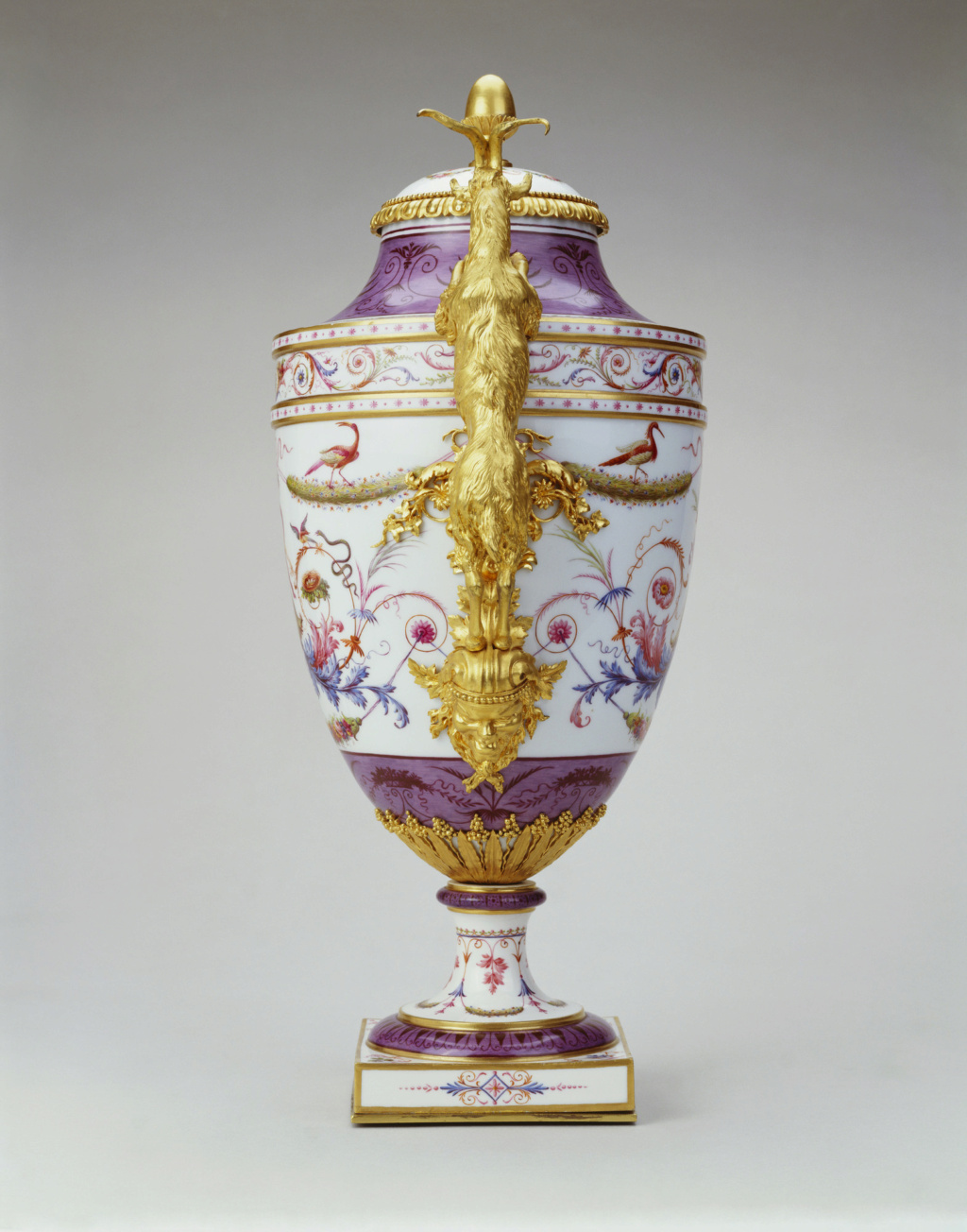


Images : The Royal Collection Trust
(...)
* Text adapted from French Porcelain for English Palaces, Sèvres from the Royal Collection, London, 2009
Source : The Royal Collection Trust

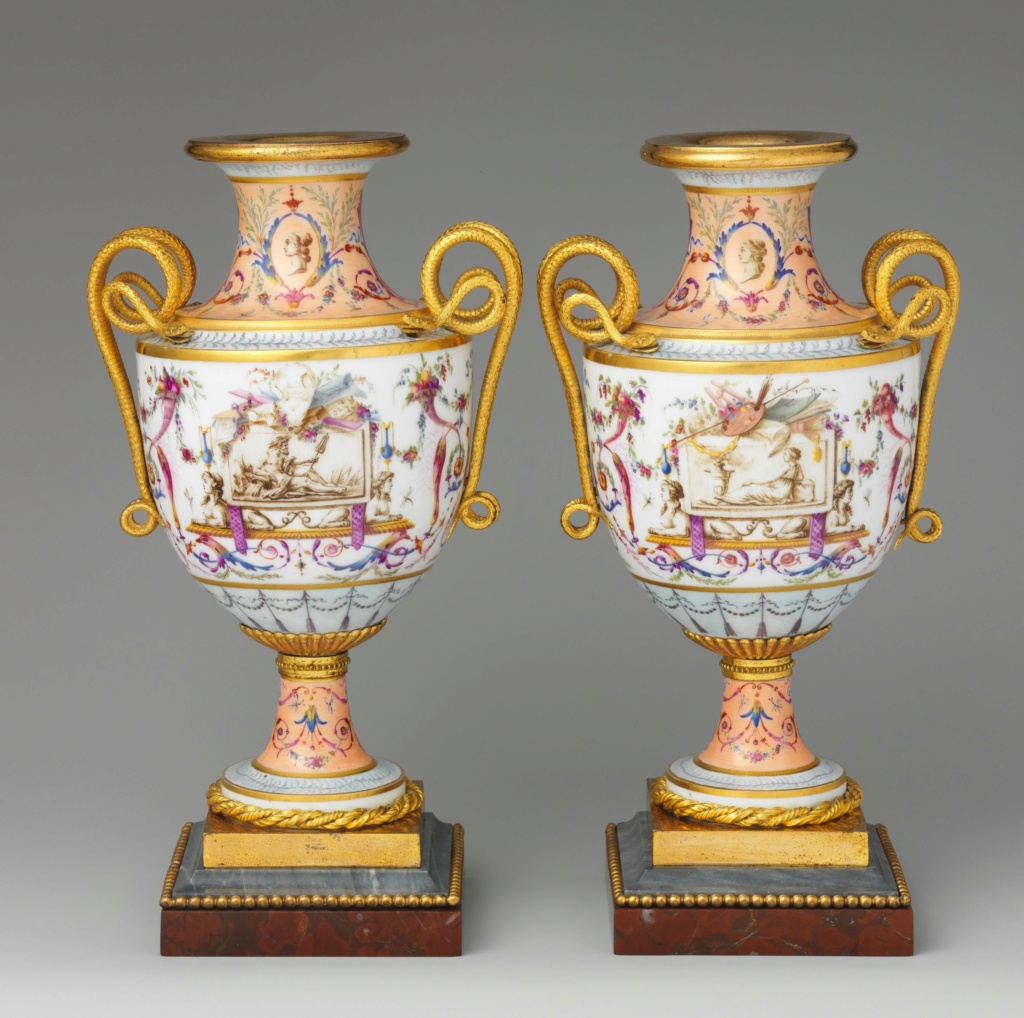
Pair of vases
Hard-paste porcelain; gilt bronze, marble
Sèvres Manufactory, 1789
Painted in red enamel: [1] interlaced Ls with a crown above flanked by mm and enclosing an anchor (Sèvres factory mark denoting hard paste with date letters for 1789 and unidentified painter's mark; painted in purple enamel: [2] traces of interlaced Ls
Images : Metropolitan Museum of Art
Description :
Made in 1789, on the eve of the French Revolution, this pair of vases reflects the superb quality and luxuriousness achieved by the Royal Porcelain Manufactory at Sèvres at the peak of its production. The vases were made to be purely decorative, and their diminutive scale was especially well suited to the intimate interiors that were in vogue in late eighteenth century France. They are painted with delicate scrolls that incorporate vegetal motifs, cornucopias, and birds’ heads.
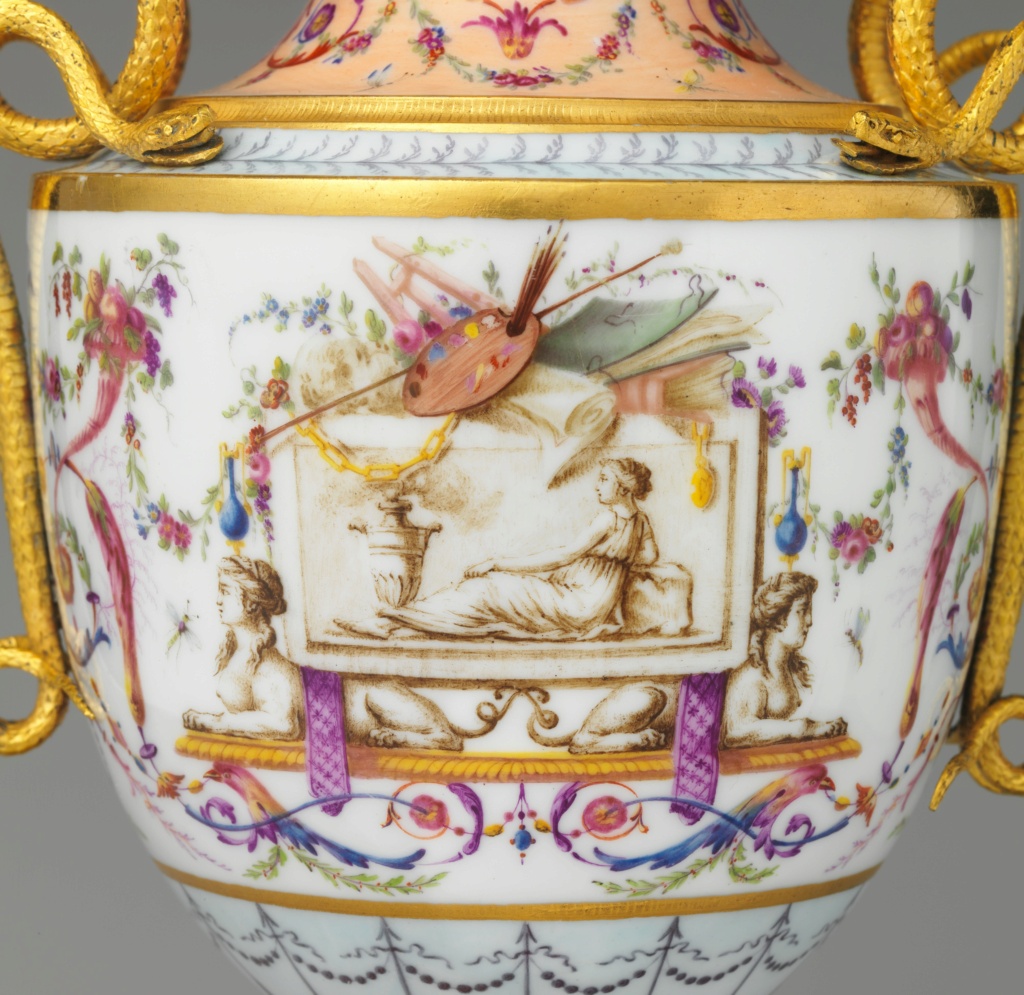
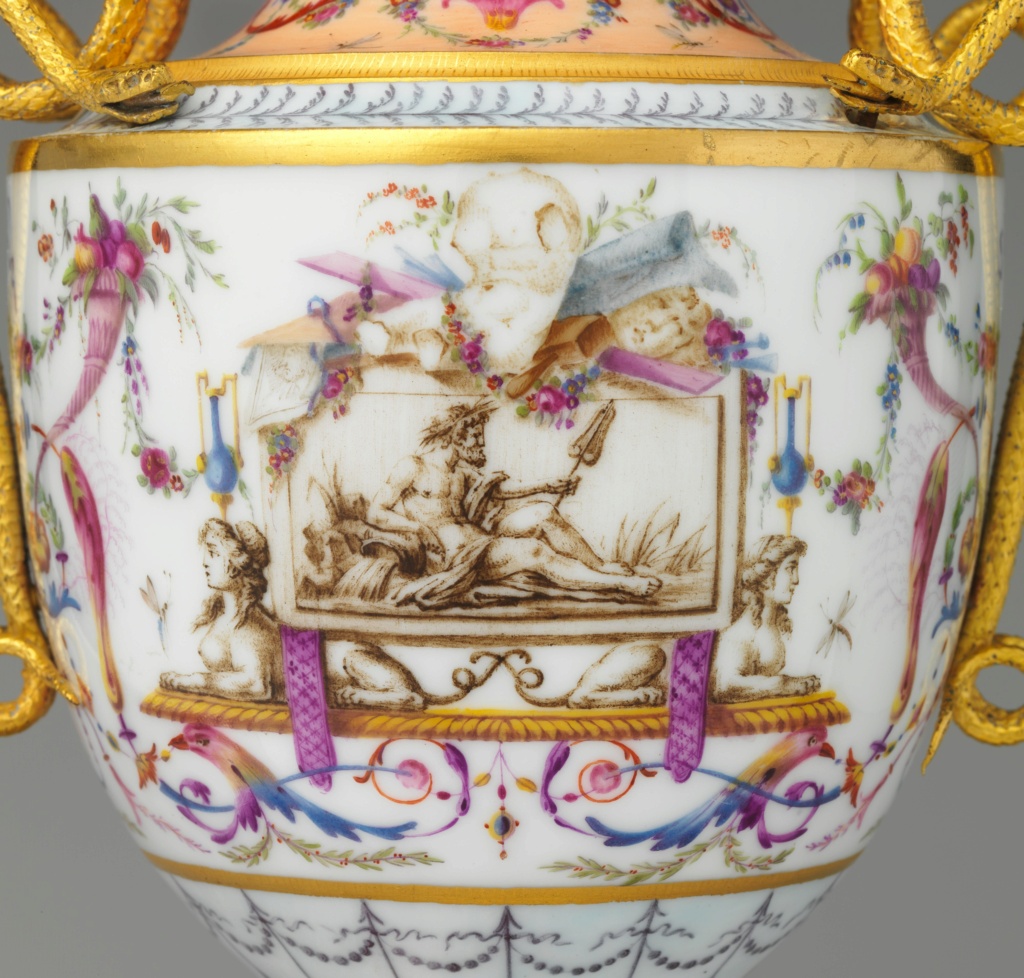
Images : Metropolitan Museum of Art
This type of decoration, known as the arabesque style, was very much in fashion in the 1780s not only throughout the decorative arts but also in interior decoration. On these vases the scrolling motifs surround panels painted to resemble prints depicting a male river god and a woman in classical dress. The richness of the decoration is enhanced by the two colors of marble employed for the base and by the finely worked coiling snakes that form the handles.
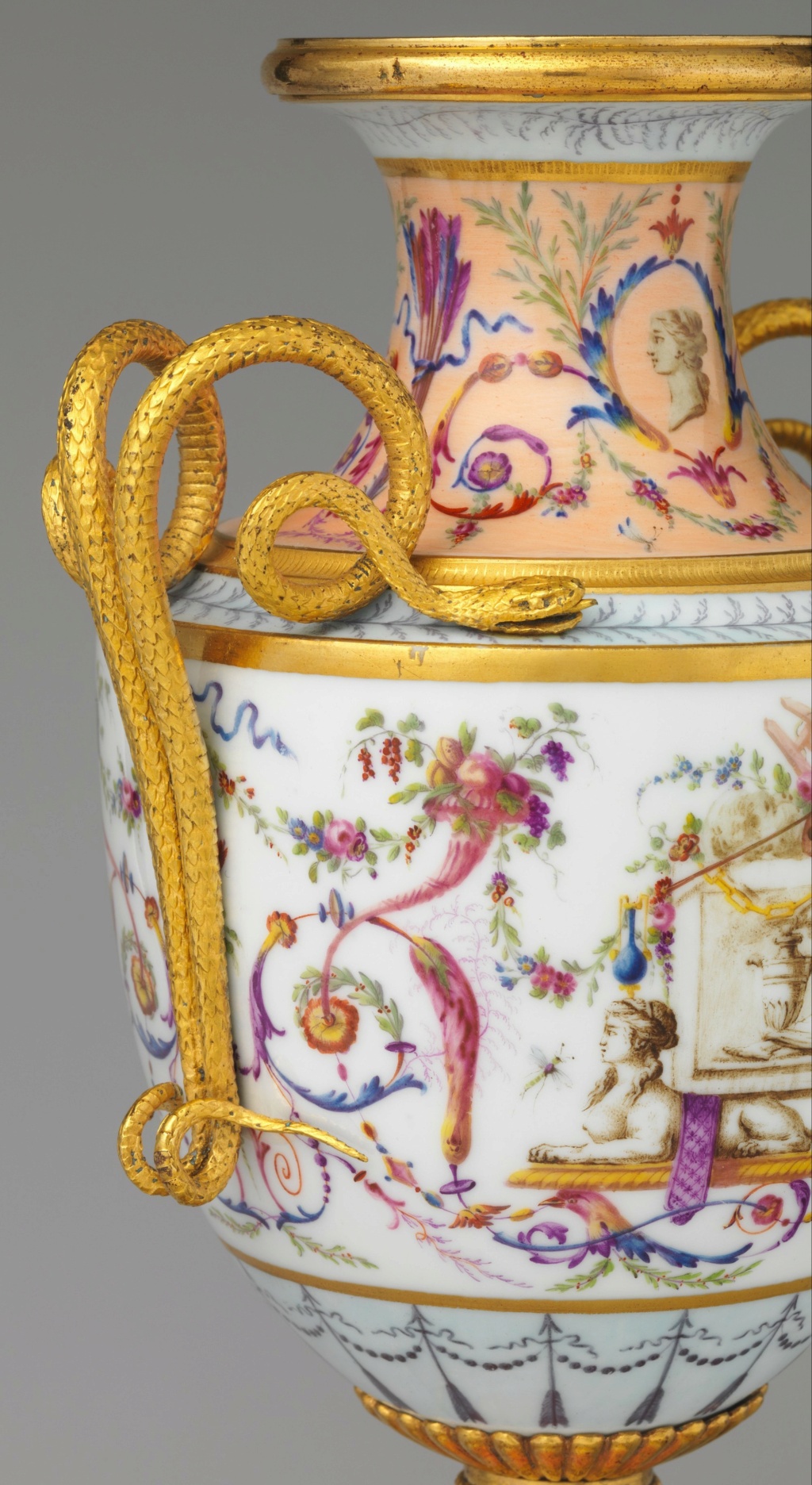
Image : Metropolitan Museum of Art

La nuit, la neige- Messages : 18132
Date d'inscription : 21/12/2013
 Sèvres et le goût de Louis XVI pour le style néoclassique à décors " d'arabesques "
Sèvres et le goût de Louis XVI pour le style néoclassique à décors " d'arabesques "

Cuvettes courteille (X 2)
Soft-paste porcelain, bue céleste ground and gilded decoration
Sèvres porcelain factory (porcelain manufacturer)
Louis-François Lécot (active 1764-1802) (gilder)
France, 1787
1 18.4 x 29.4 x 15.7, .2 18.9 x 29.7 x 16.0 cm (whole object)
Image : The Royal Collection Trust

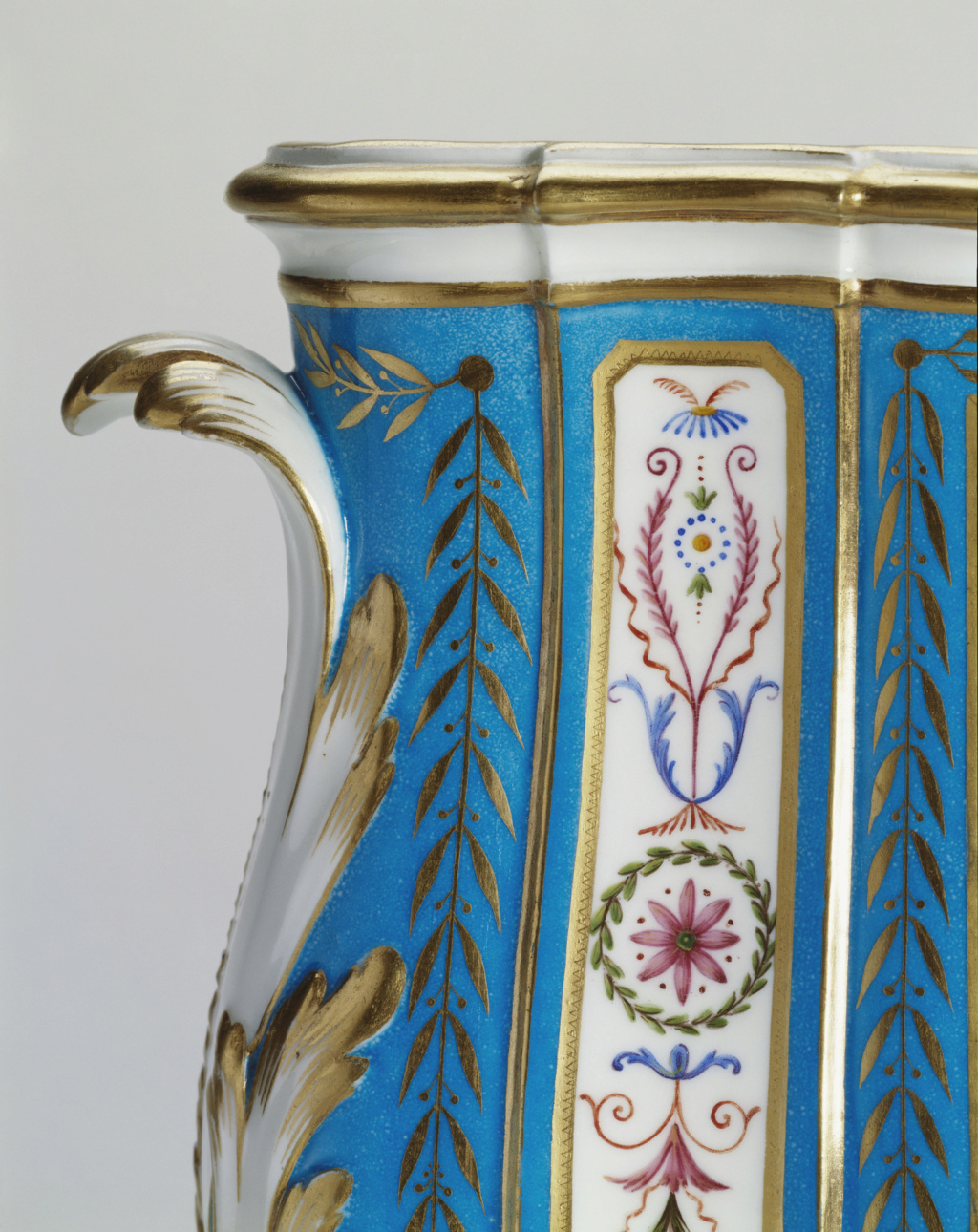
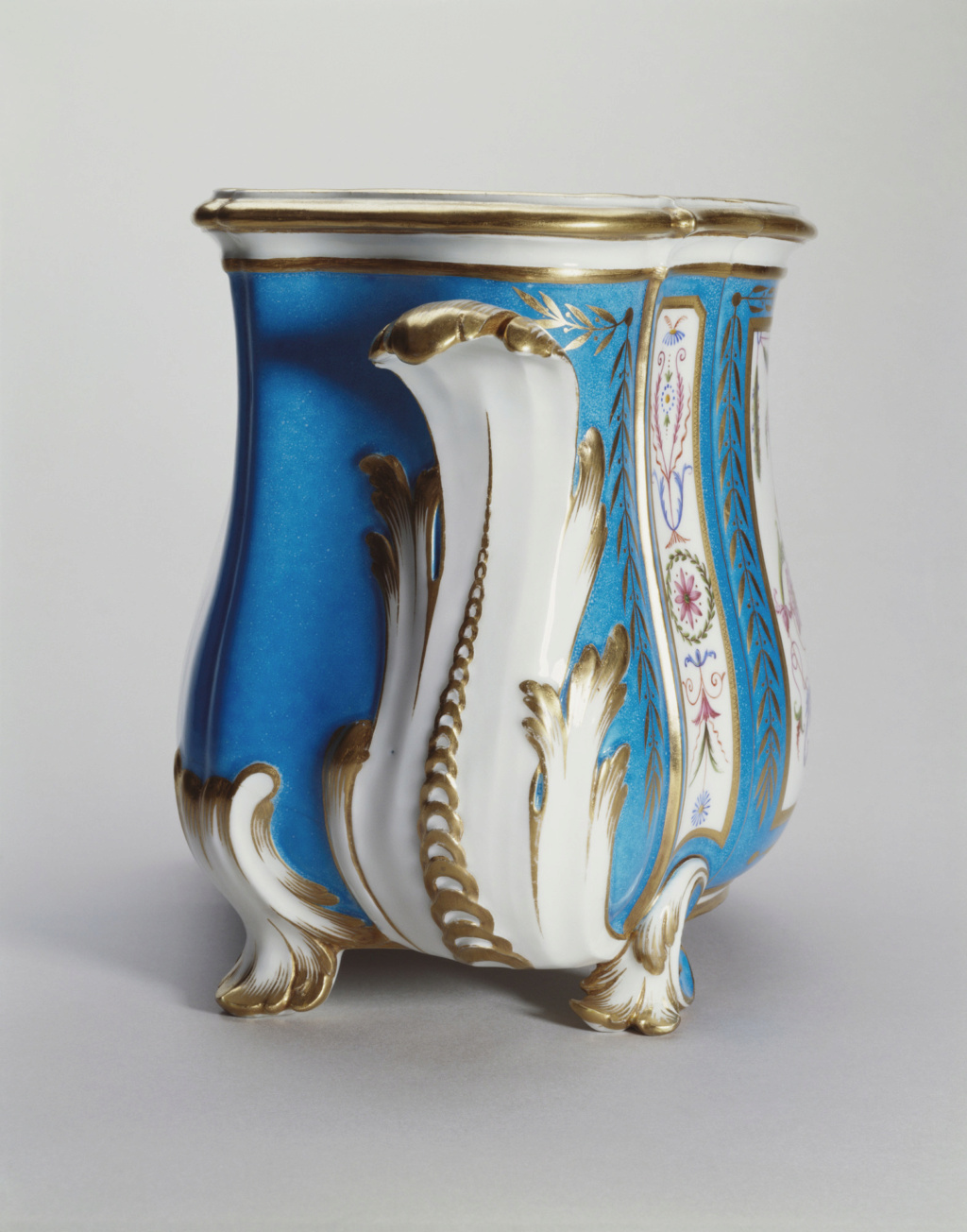
Images : The Royal Collection Trust
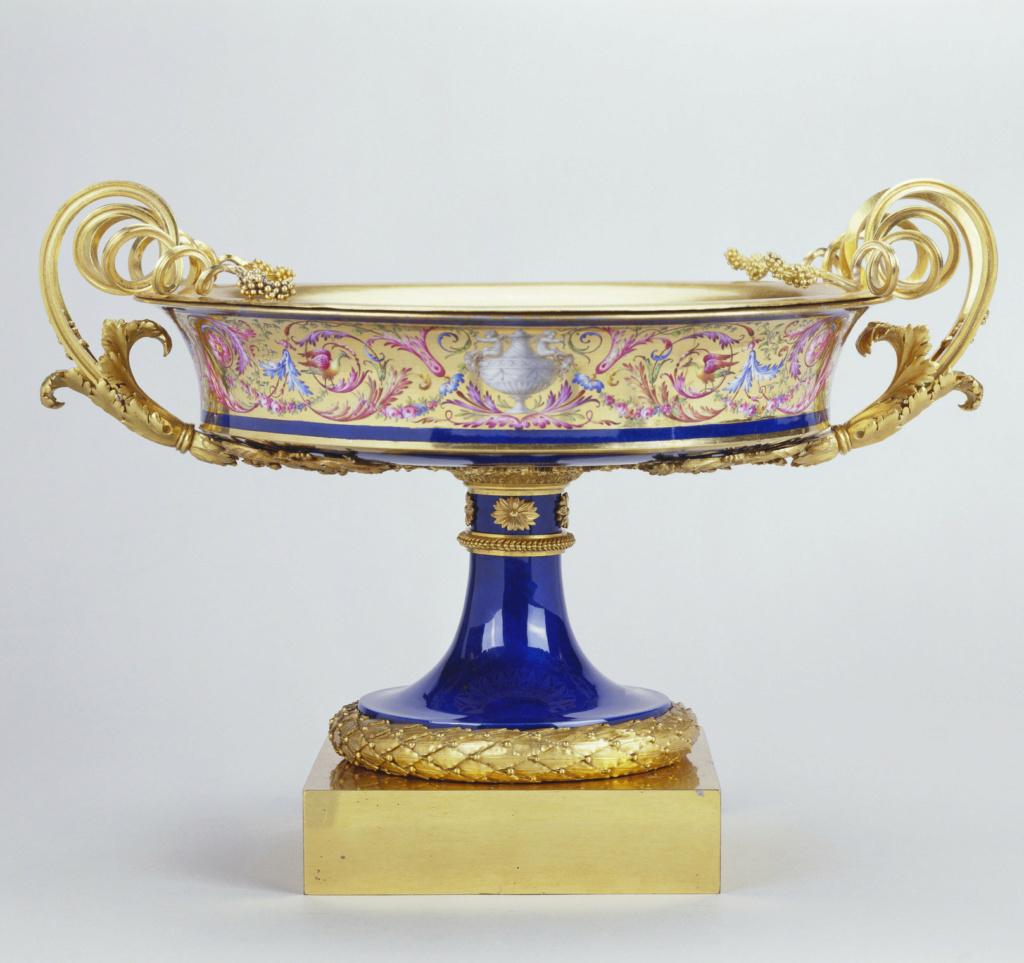
Mounted tazza,
Sèvres porcelain factory
Pierre-Philippe Thomire
France, late 18th century
Hard paste porcelain, gold ground, gilded decoration and gilt bronze
27.5 x 31 x 38.5 cm (whole object)
Image : The Royal Collection Trust
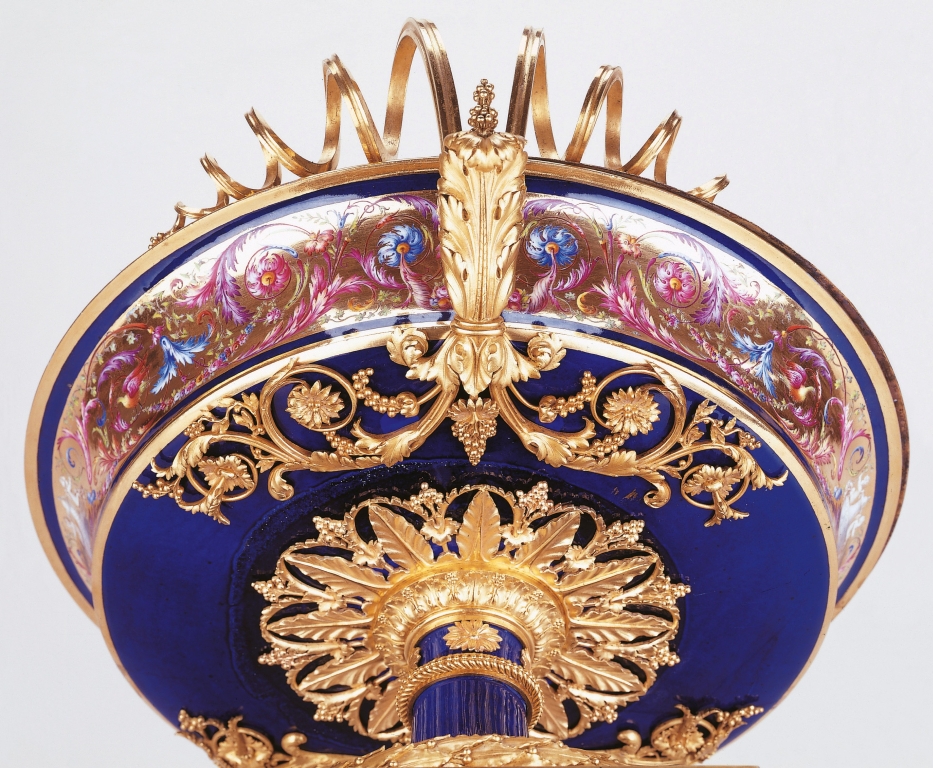
Image : The Royal Collection Trust

Jatte à punch
Hard paste porcelain and gilded decoration
Sèvres porcelain factory (porcelain manufacturer)
Nicolas Sinnesson (active 1773-95) (porcelain painter)
André-Joseph Foinet La France (active 1773-1825) (porcelain painter)
France, 1790
14.5 x 33.5 x 33.5 cm
Image : The Royal Collection Trust
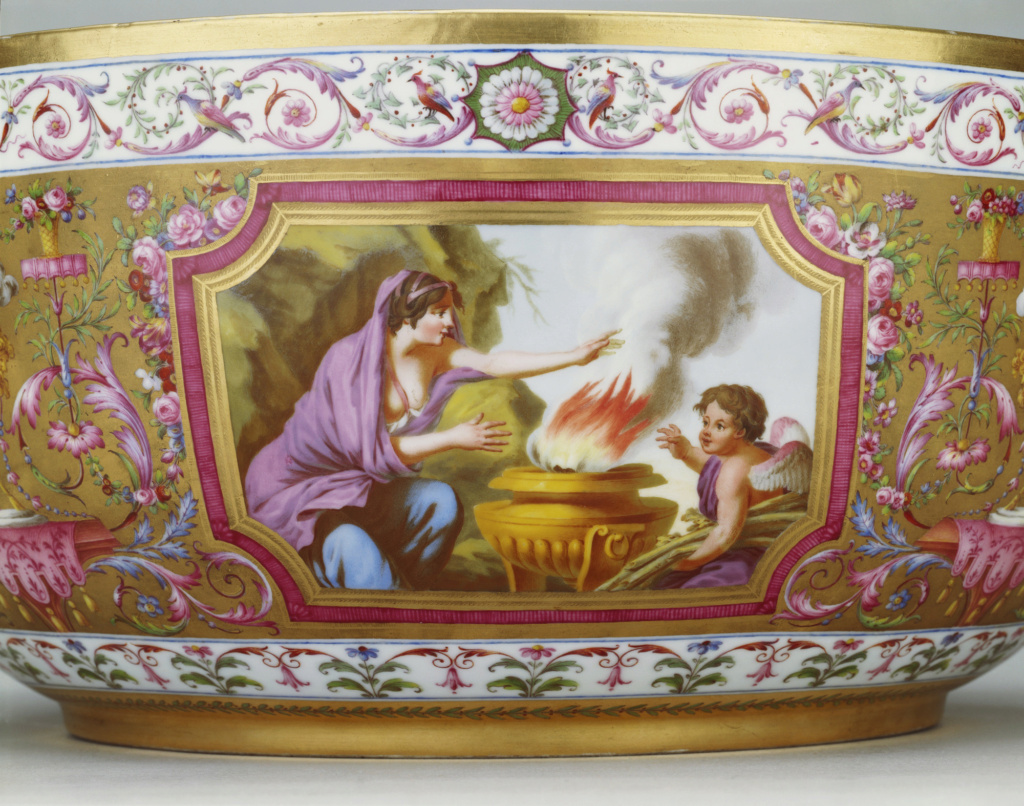
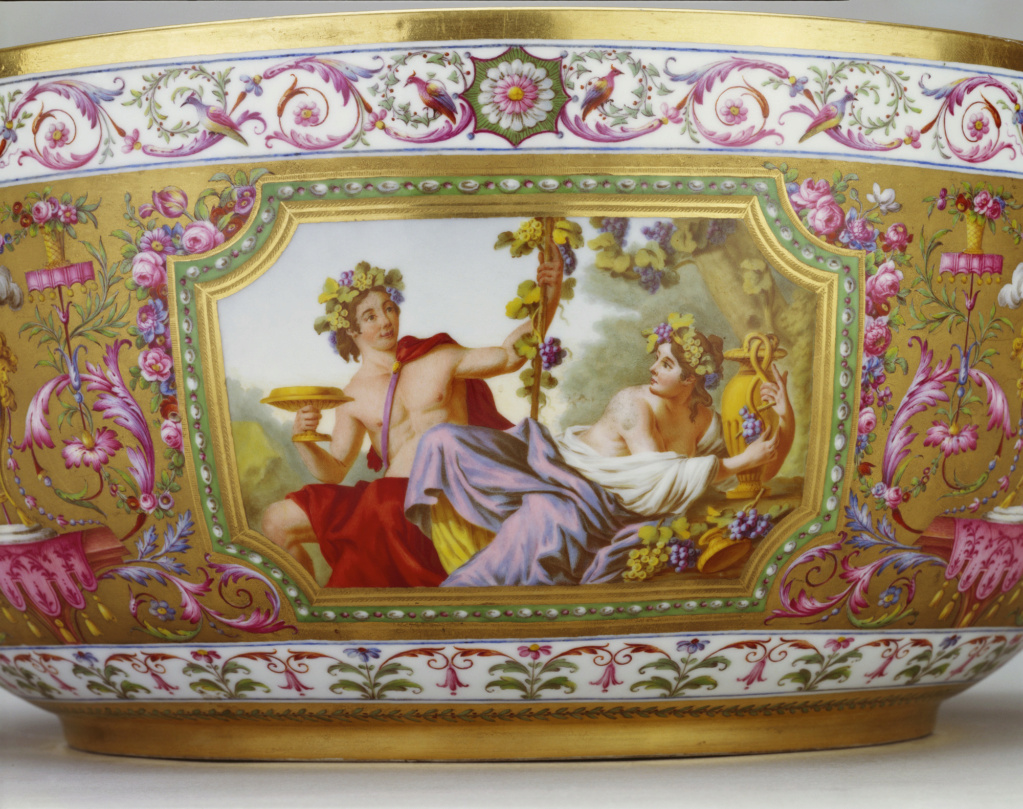
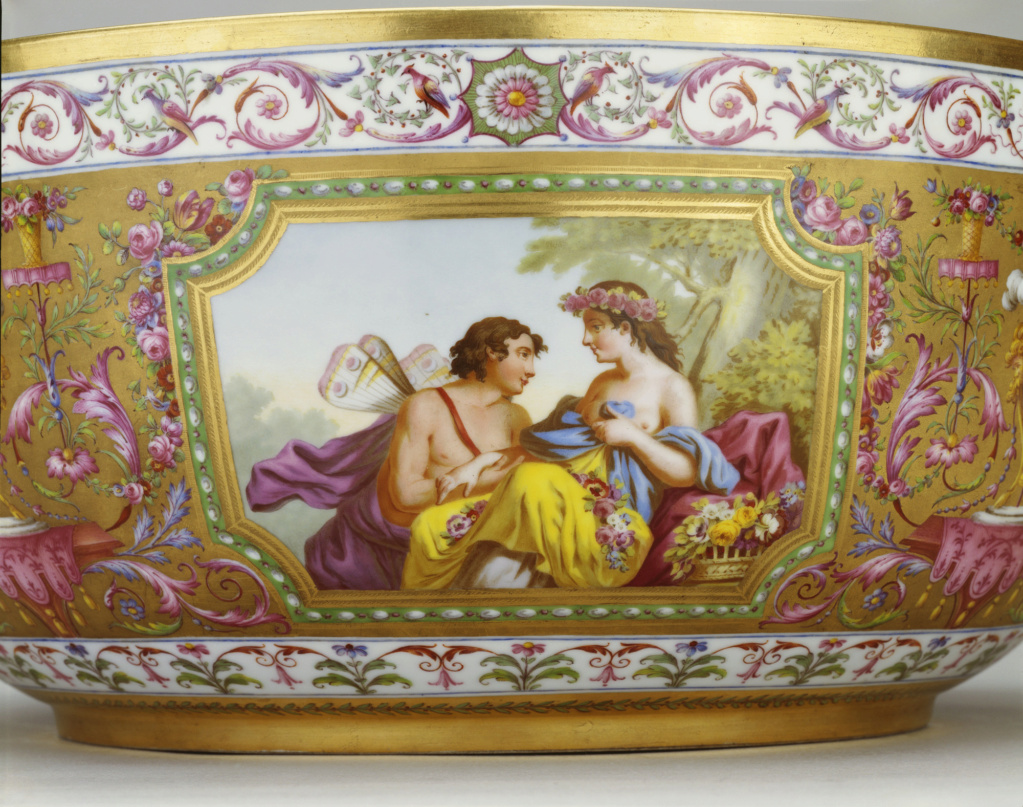
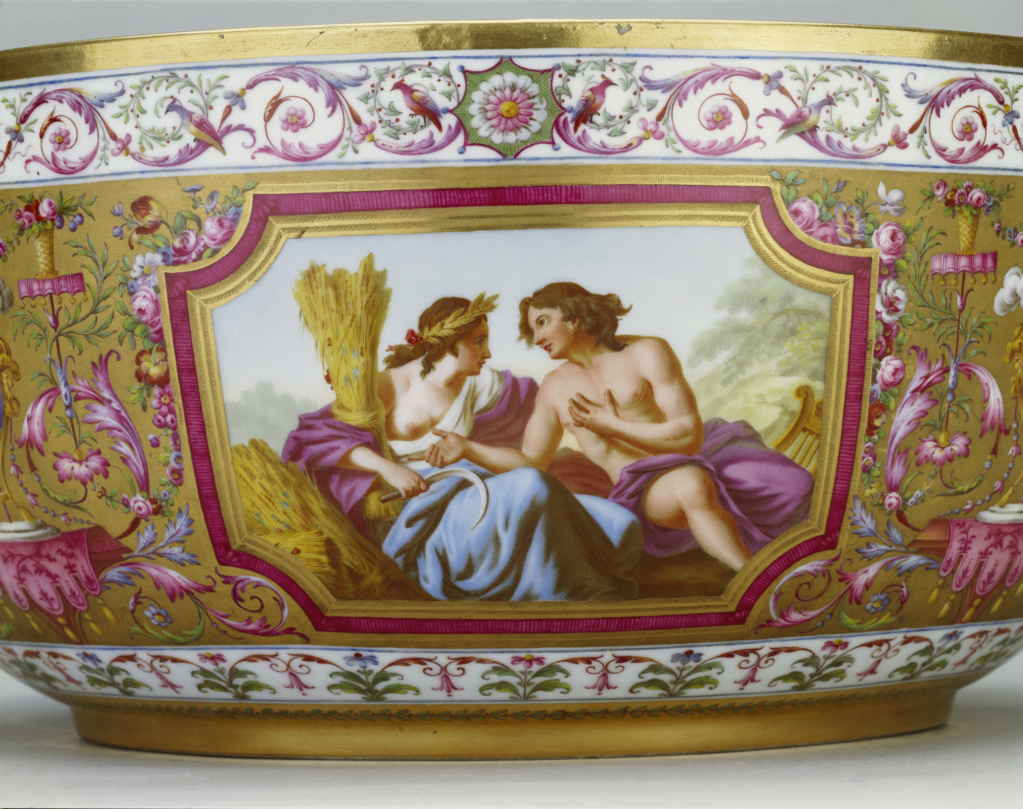
Images : The Royal Collection Trust

Vases japon (a pair)
Hard paste porcelain, porphyry ground, gilded decoration and gilt bronze
France, ca 1792-93
Sèvres porcelain factory
H J Hatfield & Sons (metalworker)
Jean Jacques Lagrenée le jeune (1739-1821) (artist)
After
Jean Michel Moreau le jeune (1741-1814) (engraver)
1 62.7 x 37.0 x 25.3, .2 62.8 x 37 x 25.7 cm (with fittings)
Image : The Royal Collection Trust


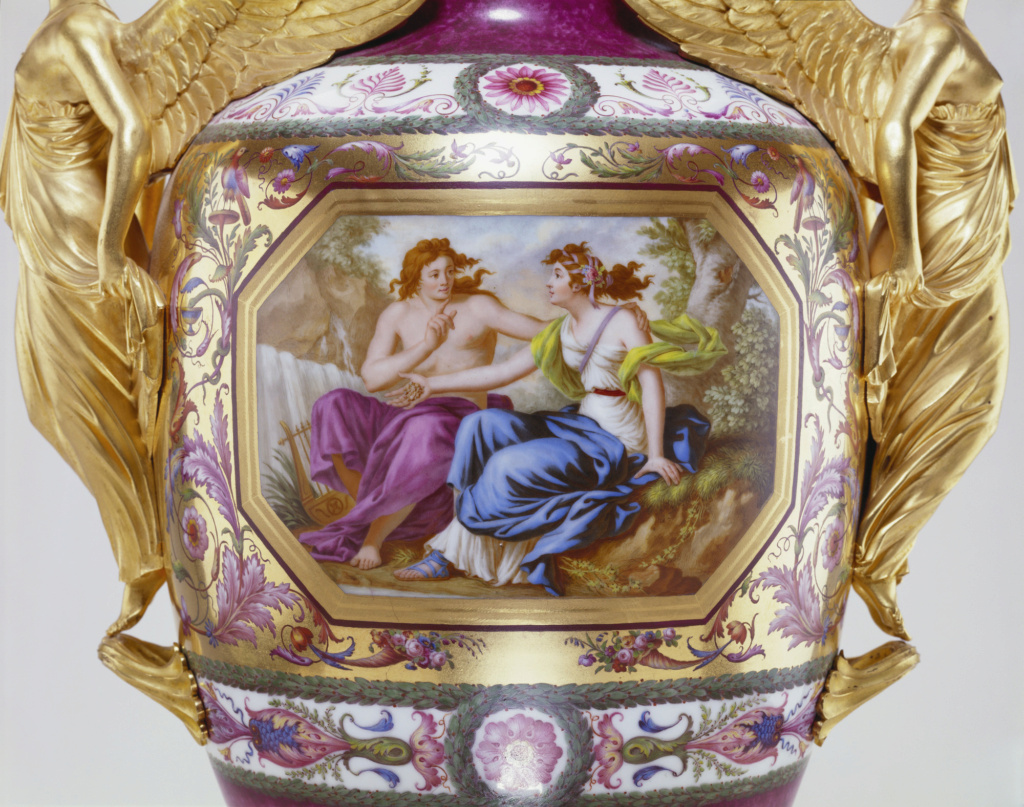
Images : The Royal Collection Trust
Dernière édition par La nuit, la neige le Sam 13 Mai 2023, 17:19, édité 1 fois

La nuit, la neige- Messages : 18132
Date d'inscription : 21/12/2013
 Re: Les porcelaines de Sèvres du roi Louis XVI (services et divers)
Re: Les porcelaines de Sèvres du roi Louis XVI (services et divers)
Merci pour ces belles images... Les vases du Met, de la royal collection et de machine de Parme (hôtel Lambert) sont ceux qui me plaisent le plus.
Je pourrais vendre mon âme au diable pour en posséder une paire (Belzébuth, si tu me lis... ).
).
Je crois qu'on parle non seulement de style "arabesque" mais aussi de décor "à la Salembier" pour nommer ce type d'ornements. Henri Salembier est un ornemaniste qui a dessiné /développé/ imaginé ces décors inspirés de l'Antique, notamment les frises de volutes et rinceaux si plaisants à l'oeil.
Je pourrais vendre mon âme au diable pour en posséder une paire (Belzébuth, si tu me lis...
 ).
). Je crois qu'on parle non seulement de style "arabesque" mais aussi de décor "à la Salembier" pour nommer ce type d'ornements. Henri Salembier est un ornemaniste qui a dessiné /développé/ imaginé ces décors inspirés de l'Antique, notamment les frises de volutes et rinceaux si plaisants à l'oeil.

Duc d'Ostrogothie- Messages : 3227
Date d'inscription : 04/11/2017
 Re: Les porcelaines de Sèvres du roi Louis XVI (services et divers)
Re: Les porcelaines de Sèvres du roi Louis XVI (services et divers)
Il s'agit de l'un des lots phares qui seront prochainement présentés à l'occasion de la vente aux enchères de la collection Jacques Garcia, château de Champ de Bataille :
Service de table, à dessert et services à thé composites, modèle "roses et feuillages" en porcelaine de Sèvres et en porcelaine
en majorité deuxième moitié du XVIIIe siècle
Le décor peint de diverses roses dans des guirlandes de feuilles de laurier et baies, comprenant :
un mortier en pâte dure, 1776, provenant du service pour le comte d'Artois, marque bleue aux deux L entrelacés couronnés, lettre-date Y en rouge, marque de doreur pour Weydinger ; un seau à bouteille en porcelaine dure ; un seaux à demi-bouteille à pâte dure ; deux autres seaux à demi-bouteille ; deux verrières à pâte dure, seau crénelé ; un seau a liqueur ovale ; deux glacières à pâte dure, leur couvercle et leur doublure, seaux à glace ; trois aiguières couvertes et leur bassin, pot à l'eau ordinaire et jatte ovale ; une aiguière, broc ordinaire ; une écuelle à deux anses, couvercle et présentoir, écuelle 'ronde tournée' et plateau 'ovale' ; deux écuelles à deux anses, un couvercle et deux présentoirs, écuelle 'ronde tournée' et plateau 'rond' ; une écuelle à deux anses et présentoir, écuelle nouvelle forme et plateau ; une petite écuelle à deux anses, couvercle et présentoir, bouillon couvert et plateau ; un beurrier, son couvercle et sa soucoupe ; une paire de confituriers, leur couvercle et leur présentoir, plateaus à deux pots de confiture; un huilier vinaigrier, porte huilier à carcasses ; seize assiettes de table ; une soucoupe de tasse à glace, soucoupe à pied ; un plateau octogonal ; deux comptiers, compotiers rond ; un compotier coquille ; un plateau ovale ; une salière triple ;
Services à thé : cinq théières couvertes, théière calabre quatre pots à lait, pot à lait à trois pieds ; un sucrier couvert et son plateau adhérent, sucrier ‘Monsieur le Premier’ ; sept sucriers et six couvercles , pot à sucre ; dix-huit tasses variées, gobelet 'litron' ; cinq coupes, gobelet Bouillard et vingt-cinq soucoupes ; une tasse à glace ; trois petits pots et leur couvercle, pot à jus ; une tasse à thé une verseuse et son couvercle
Diverses marques aux LL entrelacés, lettres-dates et marques de peintres
On ajoute une casserole couverte, poêlon
Haut. du mortier: 16 cm
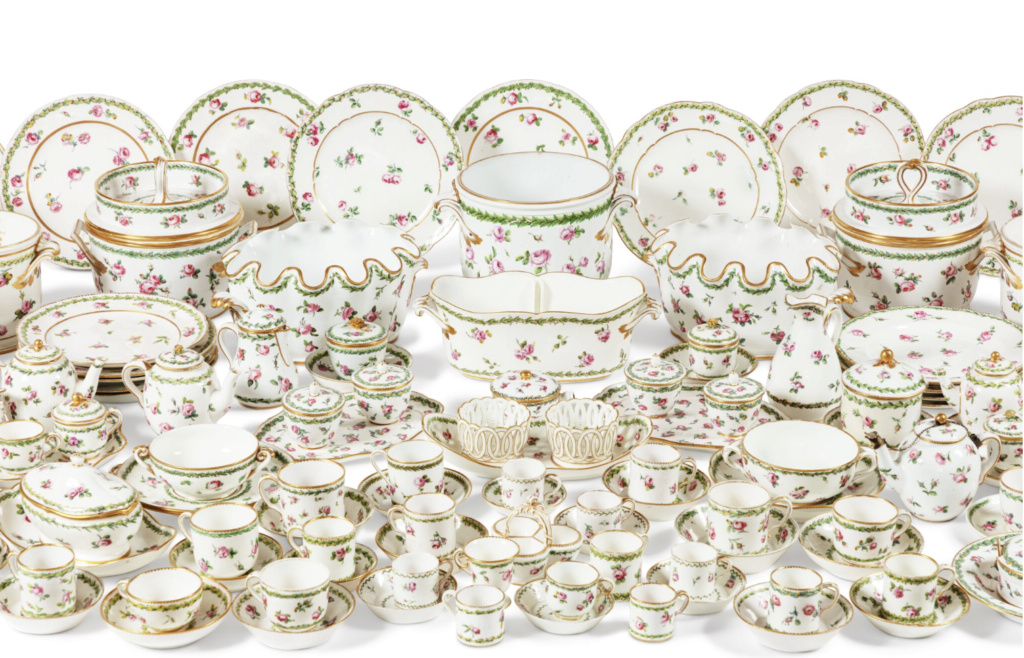
Provenance :
La paire de glacières est mentionnée dans la commande livrée en 1775 pour le service de Louis XVI.
Plusieurs mortiers sont mentionnés dans la commande livrée en 1777 au comte d'Artois, un dans chaque service prévu pour les châteaux de Saint Germain, Maison et le Temple.
Le mortier, Adrian Sassoon, Londres ; Le seau à liqueur ovale, Christie’s New York, 9 avril, 2019, lot 150 ;
Un broc ordinaire, Galerie Vandermeersch, Paris, avec son étiquette.
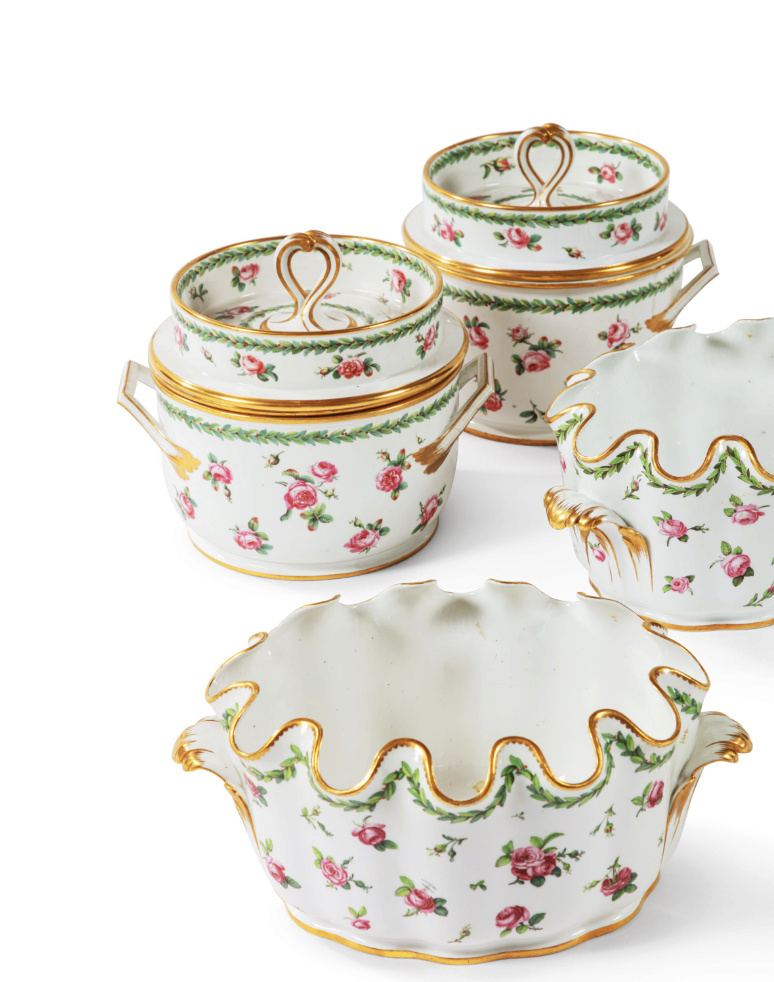
Note au catalogue
Le service "rose et feuillages" est livré à Louis XVI en 1775 sans précision de date dans les archives de Sèvres. Ce premier service comprenait plus de 280 pièces dont quatre pots-à-oille, vingt seaux à bouteille et deux glacières. Au vu du nombre de pièces réalisées, il est fort probable que la commande du service soit dûe à Louis XV qui n'aura pas l'occasion de le voir, le souverain mourant le 10 mai 1774.
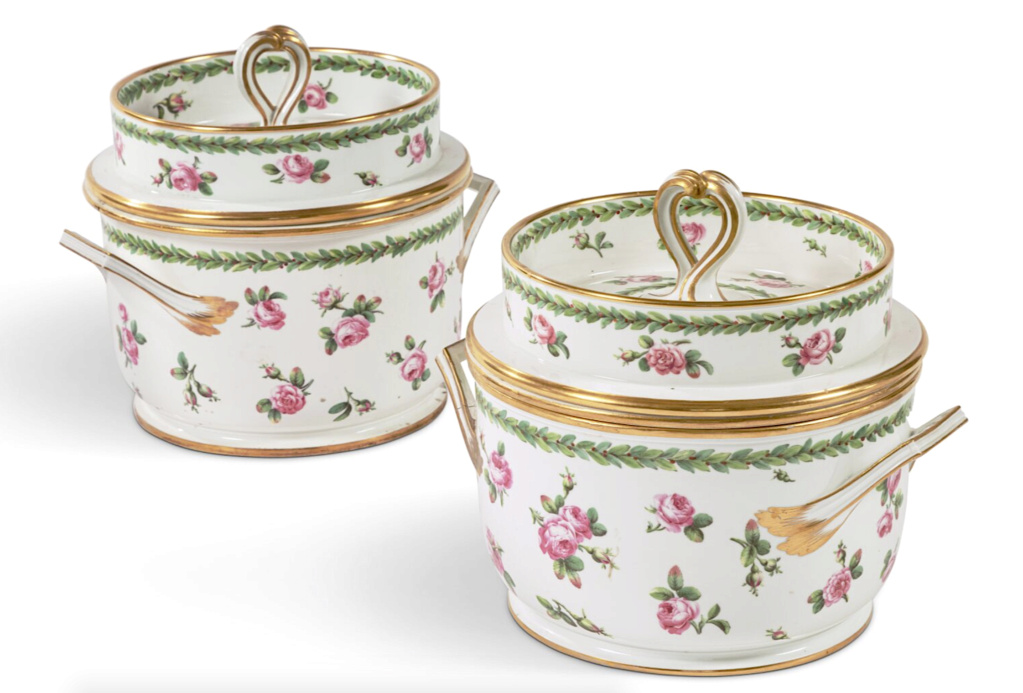
Mais le service semble plaire au jeune souverain qui le complète lors de plusieurs commandes successives. Ainsi le 12 avril 1779 il se fait livrer deux seaux à bouteille, puis en avril 1783 plus de 130 pièces complètent l'ensemble avec notamment des tasses à glace et des maronnières. En avril 1785, Louis XVI achète encore quelques pièces "pour le château de Versailles".
Son frère cadet, le comte d'Artois se fait lui aussi livrer le 26 juin 1777 un service à dessert modèle "roses et feuillages" de plus de 220 pièces pour le château de Saint Germain, le même service pour le Temple et un dernier de près de 150 pièces pour le château de Maison. Il s'agit donc d'un modèle particulièrement apprécié par le jeune comte, toujours à la pointe de la mode avec sa belle-soeur Marie-Antoinette.
Des pièces de ce service sont régulièrement proposées en vente aux enchères comme par exemple une partie de ce service (cinquante-trois pièces) qui a été présenté chez Christie's New York, The Elizabeth Stafford Collection, 31 octobre 2018, lot 1151. Une assiette a été vendue chez Sotheby's, New York, 25 octobre 1991, lot 371.
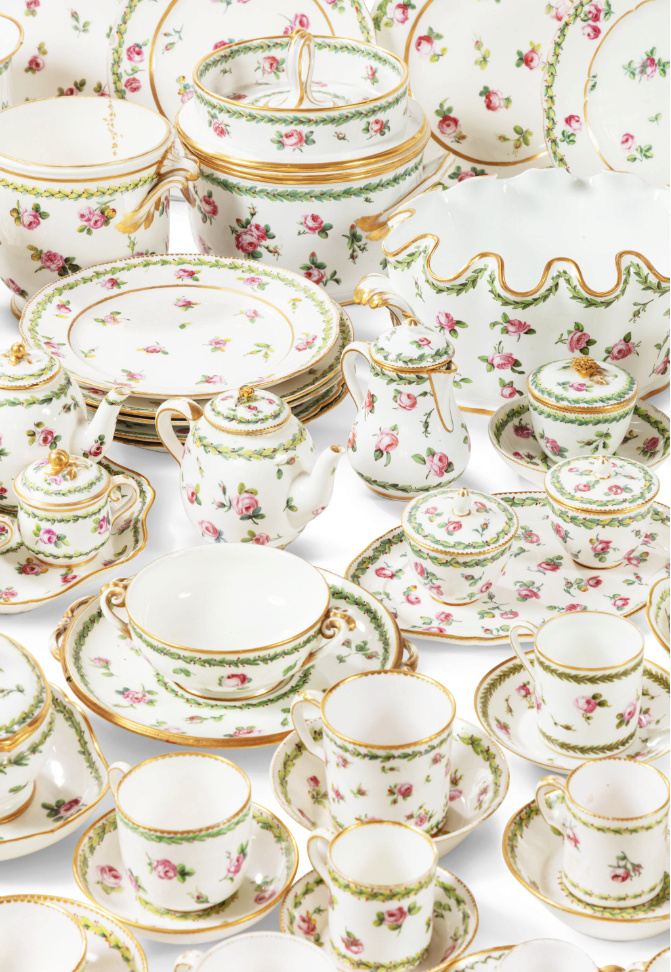

* Source et infos complémentaires : Sotheby's - Paris, vente du 16 mai 2023
 Le château de Versailles possède quelques pièces de ce service, décrites comme :
Le château de Versailles possède quelques pièces de ce service, décrites comme :
Pièces d'un service " roses et feuillages " commandé par Louis XV en 1774, livré en 1775 et constamment réassorti de 1777 à 1790
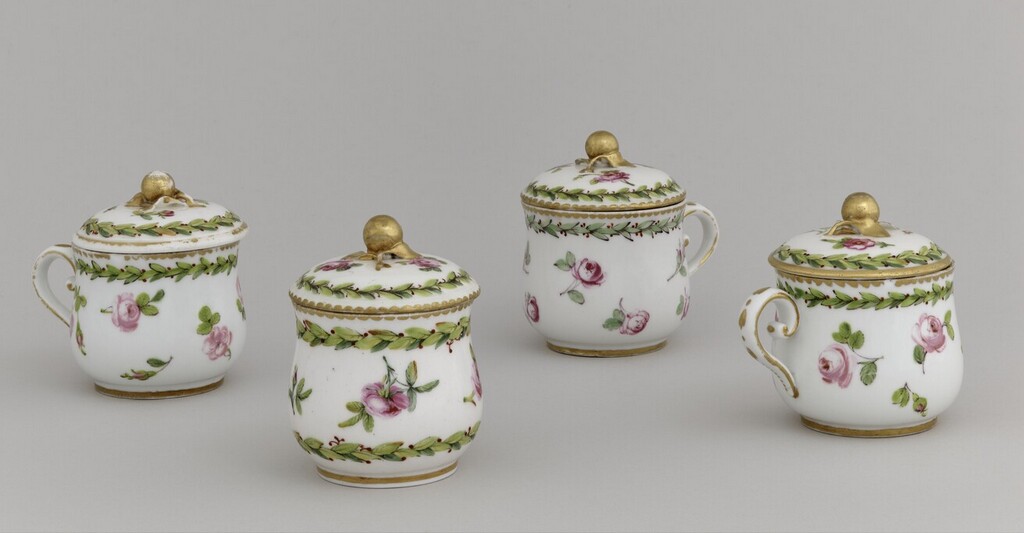
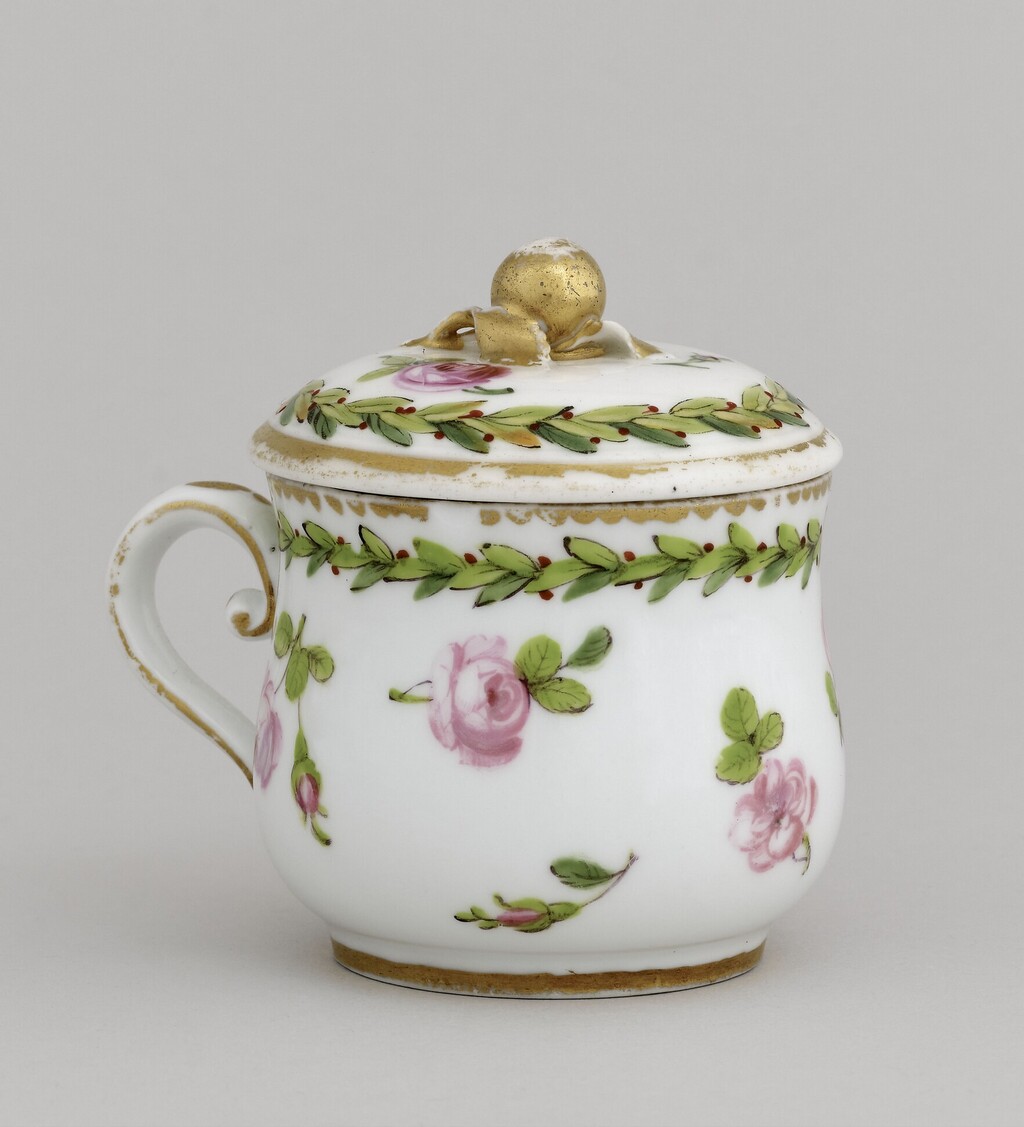

4 pot à jus (1780 ; 1784 ; 1788) et une tasse à glace (1783)
Manufacture de Sèvres, porcelaine tendre
Image : RMN-GP (Château de Versailles) / Franck Raux
Service de table, à dessert et services à thé composites, modèle "roses et feuillages" en porcelaine de Sèvres et en porcelaine
en majorité deuxième moitié du XVIIIe siècle
Le décor peint de diverses roses dans des guirlandes de feuilles de laurier et baies, comprenant :
un mortier en pâte dure, 1776, provenant du service pour le comte d'Artois, marque bleue aux deux L entrelacés couronnés, lettre-date Y en rouge, marque de doreur pour Weydinger ; un seau à bouteille en porcelaine dure ; un seaux à demi-bouteille à pâte dure ; deux autres seaux à demi-bouteille ; deux verrières à pâte dure, seau crénelé ; un seau a liqueur ovale ; deux glacières à pâte dure, leur couvercle et leur doublure, seaux à glace ; trois aiguières couvertes et leur bassin, pot à l'eau ordinaire et jatte ovale ; une aiguière, broc ordinaire ; une écuelle à deux anses, couvercle et présentoir, écuelle 'ronde tournée' et plateau 'ovale' ; deux écuelles à deux anses, un couvercle et deux présentoirs, écuelle 'ronde tournée' et plateau 'rond' ; une écuelle à deux anses et présentoir, écuelle nouvelle forme et plateau ; une petite écuelle à deux anses, couvercle et présentoir, bouillon couvert et plateau ; un beurrier, son couvercle et sa soucoupe ; une paire de confituriers, leur couvercle et leur présentoir, plateaus à deux pots de confiture; un huilier vinaigrier, porte huilier à carcasses ; seize assiettes de table ; une soucoupe de tasse à glace, soucoupe à pied ; un plateau octogonal ; deux comptiers, compotiers rond ; un compotier coquille ; un plateau ovale ; une salière triple ;
Services à thé : cinq théières couvertes, théière calabre quatre pots à lait, pot à lait à trois pieds ; un sucrier couvert et son plateau adhérent, sucrier ‘Monsieur le Premier’ ; sept sucriers et six couvercles , pot à sucre ; dix-huit tasses variées, gobelet 'litron' ; cinq coupes, gobelet Bouillard et vingt-cinq soucoupes ; une tasse à glace ; trois petits pots et leur couvercle, pot à jus ; une tasse à thé une verseuse et son couvercle
Diverses marques aux LL entrelacés, lettres-dates et marques de peintres
On ajoute une casserole couverte, poêlon
Haut. du mortier: 16 cm

Provenance :
La paire de glacières est mentionnée dans la commande livrée en 1775 pour le service de Louis XVI.
Plusieurs mortiers sont mentionnés dans la commande livrée en 1777 au comte d'Artois, un dans chaque service prévu pour les châteaux de Saint Germain, Maison et le Temple.
Le mortier, Adrian Sassoon, Londres ; Le seau à liqueur ovale, Christie’s New York, 9 avril, 2019, lot 150 ;
Un broc ordinaire, Galerie Vandermeersch, Paris, avec son étiquette.

Note au catalogue
Le service "rose et feuillages" est livré à Louis XVI en 1775 sans précision de date dans les archives de Sèvres. Ce premier service comprenait plus de 280 pièces dont quatre pots-à-oille, vingt seaux à bouteille et deux glacières. Au vu du nombre de pièces réalisées, il est fort probable que la commande du service soit dûe à Louis XV qui n'aura pas l'occasion de le voir, le souverain mourant le 10 mai 1774.

Mais le service semble plaire au jeune souverain qui le complète lors de plusieurs commandes successives. Ainsi le 12 avril 1779 il se fait livrer deux seaux à bouteille, puis en avril 1783 plus de 130 pièces complètent l'ensemble avec notamment des tasses à glace et des maronnières. En avril 1785, Louis XVI achète encore quelques pièces "pour le château de Versailles".
Son frère cadet, le comte d'Artois se fait lui aussi livrer le 26 juin 1777 un service à dessert modèle "roses et feuillages" de plus de 220 pièces pour le château de Saint Germain, le même service pour le Temple et un dernier de près de 150 pièces pour le château de Maison. Il s'agit donc d'un modèle particulièrement apprécié par le jeune comte, toujours à la pointe de la mode avec sa belle-soeur Marie-Antoinette.
Des pièces de ce service sont régulièrement proposées en vente aux enchères comme par exemple une partie de ce service (cinquante-trois pièces) qui a été présenté chez Christie's New York, The Elizabeth Stafford Collection, 31 octobre 2018, lot 1151. Une assiette a été vendue chez Sotheby's, New York, 25 octobre 1991, lot 371.


* Source et infos complémentaires : Sotheby's - Paris, vente du 16 mai 2023
___________________
Pièces d'un service " roses et feuillages " commandé par Louis XV en 1774, livré en 1775 et constamment réassorti de 1777 à 1790



4 pot à jus (1780 ; 1784 ; 1788) et une tasse à glace (1783)
Manufacture de Sèvres, porcelaine tendre
Image : RMN-GP (Château de Versailles) / Franck Raux

La nuit, la neige- Messages : 18132
Date d'inscription : 21/12/2013

Gouverneur Morris- Messages : 11795
Date d'inscription : 21/12/2013
 Re: Les porcelaines de Sèvres du roi Louis XVI (services et divers)
Re: Les porcelaines de Sèvres du roi Louis XVI (services et divers)
Merci beaucoup, cher Gouv' ! Il est partout... 
J'avoue que je comprends mal l'engouement de Louis XV et de deux de ses petits-fils pour ce service. Il est charmant, mais bon, de là à procéder à tant de commandes...

J'avoue que je comprends mal l'engouement de Louis XV et de deux de ses petits-fils pour ce service. Il est charmant, mais bon, de là à procéder à tant de commandes...

La nuit, la neige- Messages : 18132
Date d'inscription : 21/12/2013
 Sèvres - Service Arabesque commandé par Louis XVI
Sèvres - Service Arabesque commandé par Louis XVI
A Sèvres Porcelain Navette-Form Stand from the 'Service Arabesque' made for Louis XVI (Plateau de saucière)
Circa 1784
Blue interlaced L marks enclosing date letter GG
Painters mark for G Noel, incised 30, designed by L. Le Masson
The center painted en grisaille with a reclining nude female holding a basket of flowers, attended by a lion, on a green-ground within a border of flowers, further with foliate scrolls and scalloped arches, the border with cartouches of further foliate scrolls and putti spaced by squares of Greek key
131⁄2 in. (34.3 cm.) long
Provenance : Ordered by Louis XVI, 1783 ; Gift of the Revolutionary Government of France to Karl August Freiherr von Hardenberg (1750-1822), Prussian Secretary of State, delivered 1795. (...)

Lot Essay
The present sauceboat stand from the Service Arabesque is one of only three recorded by David Peters and the only example still in private hands. Of the remaining two, one is now in the collection of the Philadelphia Museum of Art (Christie's, Paris, 24 June 2003, lot 507); the third is at Versailles (Christie's, Paris, 17 April 2012, lot 34).
The Service Arabesque was the last service commissioned by Louis XVI. Ordered in 1783, the political unrest of the French Revolution intervened, and production ceased around 1787, the order incomplete. In 1795, it was presented by the Committee for Public Safety of the revolutionary French government to Karl-August Freiherr von Hardenburg, Minister of State for Frederick William of Prussia in thanks for his diplomatic assistance in drawing up the Treaty of Basel, ending war between the two countries.

Sèvres employed the architect and engineer Louis Le Masson to design the service. He, in turn, looked to Antiquity for inspiration, basing many of the shapes on Antique forms. For the decoration, he studied the recently discovered frescoes at Pompeii and Herculaneum. Le Masson made a series of designs and two artists from Sèvres then produced drawings from these for the painters at Sèvres to use. It was hoped that the 'Roman' style of the service, which also bears many similarities with the 'Grotesques Antiques' designs published in George Richardson's, Livre de Plat-Fonds (London, 1776), would be of seminal importance. Even though the service appears not to have been completed, some of the forms were indeed used again in other services. See S. Eriksen and G. de Bellaigue, Sèvres Porcelain(London, 1987, pp. 124-25).

On 7th May 1785, Le Masson is recorded as having been paid a bonus of 1,200 livres for his designs 'qu'il a donné pour le service dans le genre arabesque'. [Eriksen and Bellaigue, ibid, p. 125]. The whole project was overseen by the director of the factory and the Bâtiments du Roi, Charles-Claude Flahaut de la Billardie, comte d'Angiviller, and painters were paid between 60 and 74 livres per plate. The factory records also show that the majority of entries do not record a gilder, and it is possible that many of the plates, as is true of the present sauceboat stand, were never intended to be gilt.


Bibliography
See D. Peters, "Les Services de Porcelaine de Louis XV et Louis XVI", Versailles et les Tables Royales en Europe, XVIIème - XIXème siècles, exhibition catalogue, Versailles, Musée National des Châteaux de Versailles et de Trianon, 1993-1994, p. 121 and Sèvres Plates and Services of the 18th Century, 2005, vol. V, no. 95-6, 11 frimaire IV (2.12.1795) for a detailed analysis of the history of the service, its design and production. See Yvonne de Guillebon-Le Masson, Louis Le Masson et François Masson: Architecte et sculpteur 1770-1820, 2022, pp. 130-131 for illustrations of the of the examples in Philadelphia and Versailles.
* Source et infos complémentaires : Christie's New York - Online Sale from 5 Jun. to 18 Jun.
__________________
Nous présentons longuement ce service, qui n'a jamais été livré à Louis XVI


La nuit, la neige- Messages : 18132
Date d'inscription : 21/12/2013
 Re: Les porcelaines de Sèvres du roi Louis XVI (services et divers)
Re: Les porcelaines de Sèvres du roi Louis XVI (services et divers)
Une terrine spectaculaire, conservé au Metropolitan Museum et décrite comme...
Terrine épis de blé or épis en or et plateau

Tureen with cover
Decorators : François Antoine Pfeiffer, Nicolas Sinsson
Gilded by Henri-François Vincent
Sèvres Manufactory, c. 1777-85
Hard-paste porcelain decorated in polychrome enamels, gold
Dimensions: 33.2 × 41.6 × 29.5 cm
Description
Dining etiquette in eighteenth-century French aristocratic households required the table to be set with an array of serving dishes arranged in a decorative pattern. The diners helped themselves from the dishes and vessels close at hand, and servants reset the table for each course. This style of dining, in which all the components of a course were displayed on the table rather than presented by servants to the diners, was known as the service à la française (service in the French manner), as the custom was codified in France in the seventeenth century. It became the dominant mode of fashionable dining in Europe until the early nineteenth century, when it was supplanted by the service à la Russe (service in the Russian manner), in which the guests no longer served themselves but rather were waited upon by servants.
An important component of the first course of a dinner was commonly a stew or a soup, and the tureens in which they were served were the most prominent feature of the table setting.

The imposing scale and elaborate decoration of this porcelain tureen and stand reflect the role it played not only as a vessel to contain an important element of the meal but also in terms of providing a focal point in the decorative placement of dishes on the table. For especially important dinners at court or in aristocratic households in the eighteenth century, drawings were made to demonstrate the proper arrangement of serving dishes on the table for each course; these drawings indicate serving dishes of various shapes were commonly grouped symmetrically around the tureen, which dictated placement and the layout of the table.
The tureens used in court circles during the second half of the eighteenth century would have been made either of silver or of porcelain, and in both media tureens were produced in two basic shapes. A round tureen was known in France as a pot à oille, named after a Spanish stew called olla podrida, while an oval tureen, such as the present example, was termed a terrine. Pots à oille were used for serving rich, meat- based stews or ragouts, whereas terrines were intended to contain soup, though these distinctions probably were not always rigidly observed. In the 1750s and 1760s the dinner services produced at Sèvres commonly included one pot à oille and two terrines, but by the 1770s, a large service frequently contained two round and two oval tureens. The factory’s sales records indicate that pots à oille and terrines, often valued at the same amount, were usually the most expensive components of a dinner service.
While both pots à oille and terrines were customarily produced at Sèvres as parts of dinner services, they were also made as independent objects, clearly intended for use with nonmatching dinner wares. This particular model of terrine was known at the factory as terrine épis de blé, due to a prominent motif of sheaves of wheat in low relief that decorate both the terrine and its stand. Along with its matching pot à oille, it was one of the largest and most richly decorated of the tureens made at Sèvres, and very few of either the round or oval models were produced.
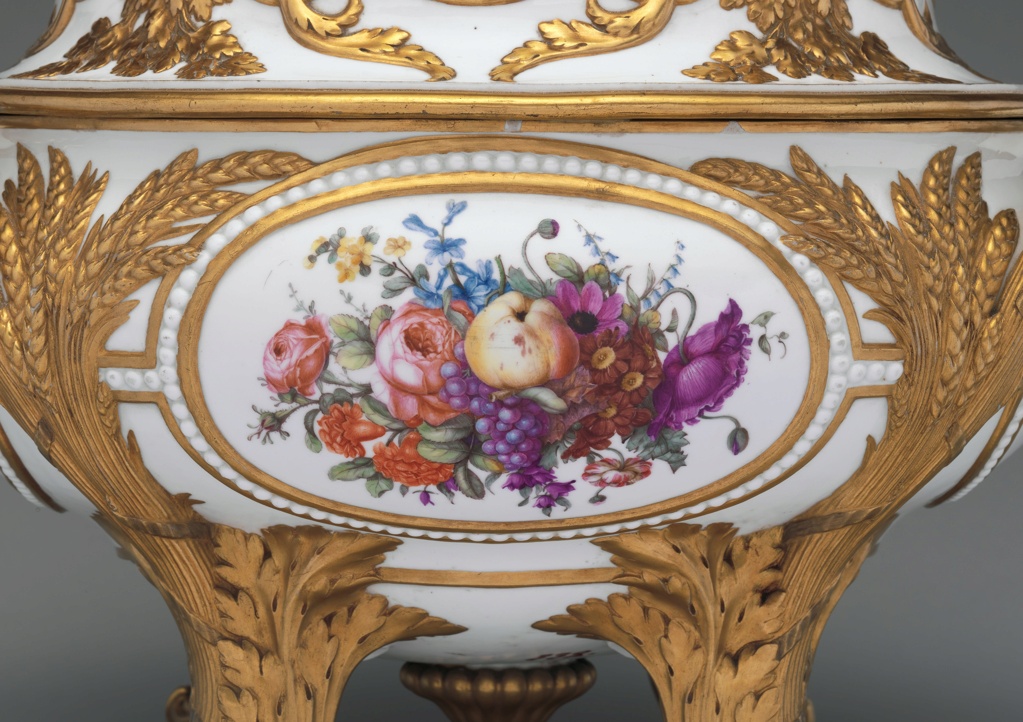
The factory archives indicate that all of the pots à oille and terrines of this design were made independent of a dinner service, and it is possible that they were intended to be used with wares made of gilt silver rather than of porcelain.
According to the factory sales records, all of the tureens of the épis de blé design made at Sèvres were either presented as gifts to foreign monarchs or were acquired by Louis XVI (1754–1793), king of France. While gilt silver was frequently the preferred medium for royal dinner services, porcelain became increasingly popular during the second half of the eighteenth century, and the two media may have been used together, as the extensive gilding on the Sèvres terrine would have made it visually compatible with gilt-silver tablewares.
The earliest of the tureens of this model are the two pots à oille and two terrines given by Louis XVI in 1777 to his brother-in-law Joseph II (1741–1790), the Holy Roman Emperor. Joseph II had traveled to France that year to visit his sister Marie-Antoinette (1755–1793), and one of the diplomatic gifts he received was an extensive green- ground Sèvres dinner service, as well as a variety of other pieces from the factory, including the four épis de blé tureens, two of each shape. The two pots à oille and two terrines were each valued at 900 livres,making them among the most expensive tureens produced at the factory.

Tureen with decoration of golden wheat ears
Sèvres porcelain painted, 1777
Part of the gift to Joseph II on his visit to his sister Marie-Antoinette
Image : Bundesmobilienverwaltung / Silberkammer - Hofburg Wien
This model of tureen must have found favor with Louis XVI, as four pots à oille épis de blé were purchased by the monarch in 1777. In contrast to the two different shapes of tureen given to Joseph II, the four acquired by Louis XVI were round, as indicated by the use of the term pots à oille.
The last appearance of this model of tureen in the factory sales records occurs in connection with a gift made by Louis XVI to Gustav III (1746–1792), king of Sweden, in 1784. As in the case of Joseph II, the Swedish monarch was presented with a large Sèvres dinner service, as well as numerous other pieces of Sèvres porcelain unrelated to the service itself. Among the additional gifts were two oval tureens (“terrines à Epis de Bled” [sic]), also valued at 900 livres each. While the terrines were presented to Gustav III in 1784, it has been suggested by David Peters that they may have been produced around the same time as the tureens cited above, and thus were selected from unsold stock at the Sèvres factory in order to augment the gift to the Swedish king. It is possible that the Museum’s terrine may have been one of the two sent to Sweden in 1784.

Two terrines and one pot à oille from the gift to Joseph II survive at the imperial palace in Vienna, known as the Hofburg; the second pot à oille was damaged in the nineteenth century.
Unless a mistake was made in recording the purchase by Louis XVI in 1777, the Museum’s terrine cannot be identified as having been owned by the French monarch, as all of his were of the round model. Neither of the two terrines given to Gustav III is known to have survived in Sweden. A terrine now in the Designmuseum Danmark, Copenhagen, may be one of these, but this cannot be proven, and its replaced lid and stand complicate the understanding of its history. A terrine of this model with similar decoration but without its stand was offered at auction in 1981 in Copenhagen; it, too, may have been one of those owned by the Swedish king. However, two other very similar terrines were sold in 1911 and 1971, respectively, and each of these also could have a royal Swedish provenance.

It appears that there are more terrines of this model, all of which have similar decoration consisting of trophies of agricultural implements and lush clusters of flowers, than are recorded in the sales records, so a more complete history of the Museum’s tureen may never be known.
The group of both round and oval tureens are among the most impressive tablewares produced at Sèvres, not only in terms of scale but also in regard to the quality of their painted decoration and their extensive use of gilding, all of which made them appropriate for use on a royal table.
* Source et infos complémentaires : MetMuseum
Terrine épis de blé or épis en or et plateau

Tureen with cover
Decorators : François Antoine Pfeiffer, Nicolas Sinsson
Gilded by Henri-François Vincent
Sèvres Manufactory, c. 1777-85
Hard-paste porcelain decorated in polychrome enamels, gold
Dimensions: 33.2 × 41.6 × 29.5 cm
Description
Dining etiquette in eighteenth-century French aristocratic households required the table to be set with an array of serving dishes arranged in a decorative pattern. The diners helped themselves from the dishes and vessels close at hand, and servants reset the table for each course. This style of dining, in which all the components of a course were displayed on the table rather than presented by servants to the diners, was known as the service à la française (service in the French manner), as the custom was codified in France in the seventeenth century. It became the dominant mode of fashionable dining in Europe until the early nineteenth century, when it was supplanted by the service à la Russe (service in the Russian manner), in which the guests no longer served themselves but rather were waited upon by servants.
An important component of the first course of a dinner was commonly a stew or a soup, and the tureens in which they were served were the most prominent feature of the table setting.

The imposing scale and elaborate decoration of this porcelain tureen and stand reflect the role it played not only as a vessel to contain an important element of the meal but also in terms of providing a focal point in the decorative placement of dishes on the table. For especially important dinners at court or in aristocratic households in the eighteenth century, drawings were made to demonstrate the proper arrangement of serving dishes on the table for each course; these drawings indicate serving dishes of various shapes were commonly grouped symmetrically around the tureen, which dictated placement and the layout of the table.
The tureens used in court circles during the second half of the eighteenth century would have been made either of silver or of porcelain, and in both media tureens were produced in two basic shapes. A round tureen was known in France as a pot à oille, named after a Spanish stew called olla podrida, while an oval tureen, such as the present example, was termed a terrine. Pots à oille were used for serving rich, meat- based stews or ragouts, whereas terrines were intended to contain soup, though these distinctions probably were not always rigidly observed. In the 1750s and 1760s the dinner services produced at Sèvres commonly included one pot à oille and two terrines, but by the 1770s, a large service frequently contained two round and two oval tureens. The factory’s sales records indicate that pots à oille and terrines, often valued at the same amount, were usually the most expensive components of a dinner service.
While both pots à oille and terrines were customarily produced at Sèvres as parts of dinner services, they were also made as independent objects, clearly intended for use with nonmatching dinner wares. This particular model of terrine was known at the factory as terrine épis de blé, due to a prominent motif of sheaves of wheat in low relief that decorate both the terrine and its stand. Along with its matching pot à oille, it was one of the largest and most richly decorated of the tureens made at Sèvres, and very few of either the round or oval models were produced.

The factory archives indicate that all of the pots à oille and terrines of this design were made independent of a dinner service, and it is possible that they were intended to be used with wares made of gilt silver rather than of porcelain.
According to the factory sales records, all of the tureens of the épis de blé design made at Sèvres were either presented as gifts to foreign monarchs or were acquired by Louis XVI (1754–1793), king of France. While gilt silver was frequently the preferred medium for royal dinner services, porcelain became increasingly popular during the second half of the eighteenth century, and the two media may have been used together, as the extensive gilding on the Sèvres terrine would have made it visually compatible with gilt-silver tablewares.
The earliest of the tureens of this model are the two pots à oille and two terrines given by Louis XVI in 1777 to his brother-in-law Joseph II (1741–1790), the Holy Roman Emperor. Joseph II had traveled to France that year to visit his sister Marie-Antoinette (1755–1793), and one of the diplomatic gifts he received was an extensive green- ground Sèvres dinner service, as well as a variety of other pieces from the factory, including the four épis de blé tureens, two of each shape. The two pots à oille and two terrines were each valued at 900 livres,making them among the most expensive tureens produced at the factory.

Tureen with decoration of golden wheat ears
Sèvres porcelain painted, 1777
Part of the gift to Joseph II on his visit to his sister Marie-Antoinette
Image : Bundesmobilienverwaltung / Silberkammer - Hofburg Wien
This model of tureen must have found favor with Louis XVI, as four pots à oille épis de blé were purchased by the monarch in 1777. In contrast to the two different shapes of tureen given to Joseph II, the four acquired by Louis XVI were round, as indicated by the use of the term pots à oille.
The last appearance of this model of tureen in the factory sales records occurs in connection with a gift made by Louis XVI to Gustav III (1746–1792), king of Sweden, in 1784. As in the case of Joseph II, the Swedish monarch was presented with a large Sèvres dinner service, as well as numerous other pieces of Sèvres porcelain unrelated to the service itself. Among the additional gifts were two oval tureens (“terrines à Epis de Bled” [sic]), also valued at 900 livres each. While the terrines were presented to Gustav III in 1784, it has been suggested by David Peters that they may have been produced around the same time as the tureens cited above, and thus were selected from unsold stock at the Sèvres factory in order to augment the gift to the Swedish king. It is possible that the Museum’s terrine may have been one of the two sent to Sweden in 1784.

Two terrines and one pot à oille from the gift to Joseph II survive at the imperial palace in Vienna, known as the Hofburg; the second pot à oille was damaged in the nineteenth century.
Unless a mistake was made in recording the purchase by Louis XVI in 1777, the Museum’s terrine cannot be identified as having been owned by the French monarch, as all of his were of the round model. Neither of the two terrines given to Gustav III is known to have survived in Sweden. A terrine now in the Designmuseum Danmark, Copenhagen, may be one of these, but this cannot be proven, and its replaced lid and stand complicate the understanding of its history. A terrine of this model with similar decoration but without its stand was offered at auction in 1981 in Copenhagen; it, too, may have been one of those owned by the Swedish king. However, two other very similar terrines were sold in 1911 and 1971, respectively, and each of these also could have a royal Swedish provenance.

It appears that there are more terrines of this model, all of which have similar decoration consisting of trophies of agricultural implements and lush clusters of flowers, than are recorded in the sales records, so a more complete history of the Museum’s tureen may never be known.
The group of both round and oval tureens are among the most impressive tablewares produced at Sèvres, not only in terms of scale but also in regard to the quality of their painted decoration and their extensive use of gilding, all of which made them appropriate for use on a royal table.
* Source et infos complémentaires : MetMuseum

La nuit, la neige- Messages : 18132
Date d'inscription : 21/12/2013
 Sujets similaires
Sujets similaires» Les services en porcelaine de Sèvres à décors révolutionnaires (durant la Révolution française)
» Porcelaines de Vincennes et de Sèvres
» Les services en porcelaine de Sèvres de Marie-Antoinette
» Les services en porcelaine de Sèvres de la comtesse d'Artois
» Les " Services aux oiseaux Buffon " des manufactures de porcelaine de Sèvres et Tournai
» Porcelaines de Vincennes et de Sèvres
» Les services en porcelaine de Sèvres de Marie-Antoinette
» Les services en porcelaine de Sèvres de la comtesse d'Artois
» Les " Services aux oiseaux Buffon " des manufactures de porcelaine de Sèvres et Tournai
LE FORUM DE MARIE-ANTOINETTE :: La France et le Monde au XVIIIe siècle :: Les Arts et l'artisanat au XVIIIe siècle :: Les arts décoratifs
Page 1 sur 1
Permission de ce forum:
Vous ne pouvez pas répondre aux sujets dans ce forum

